Facebook User Behavior and Body Image
VerifiedAdded on 2020/10/05
|35
|12586
|375
AI Summary
This assignment assesses Facebook user behavior, including frequency of activities such as creating events, joining groups, posting updates, and commenting on friends' content. Additionally, it evaluates body image concerns using the 7-item Drive for Thinness Questionnaire, measuring attitudes towards one's body, desire to change shape, and self-criticism.
Contribute Materials
Your contribution can guide someone’s learning journey. Share your
documents today.
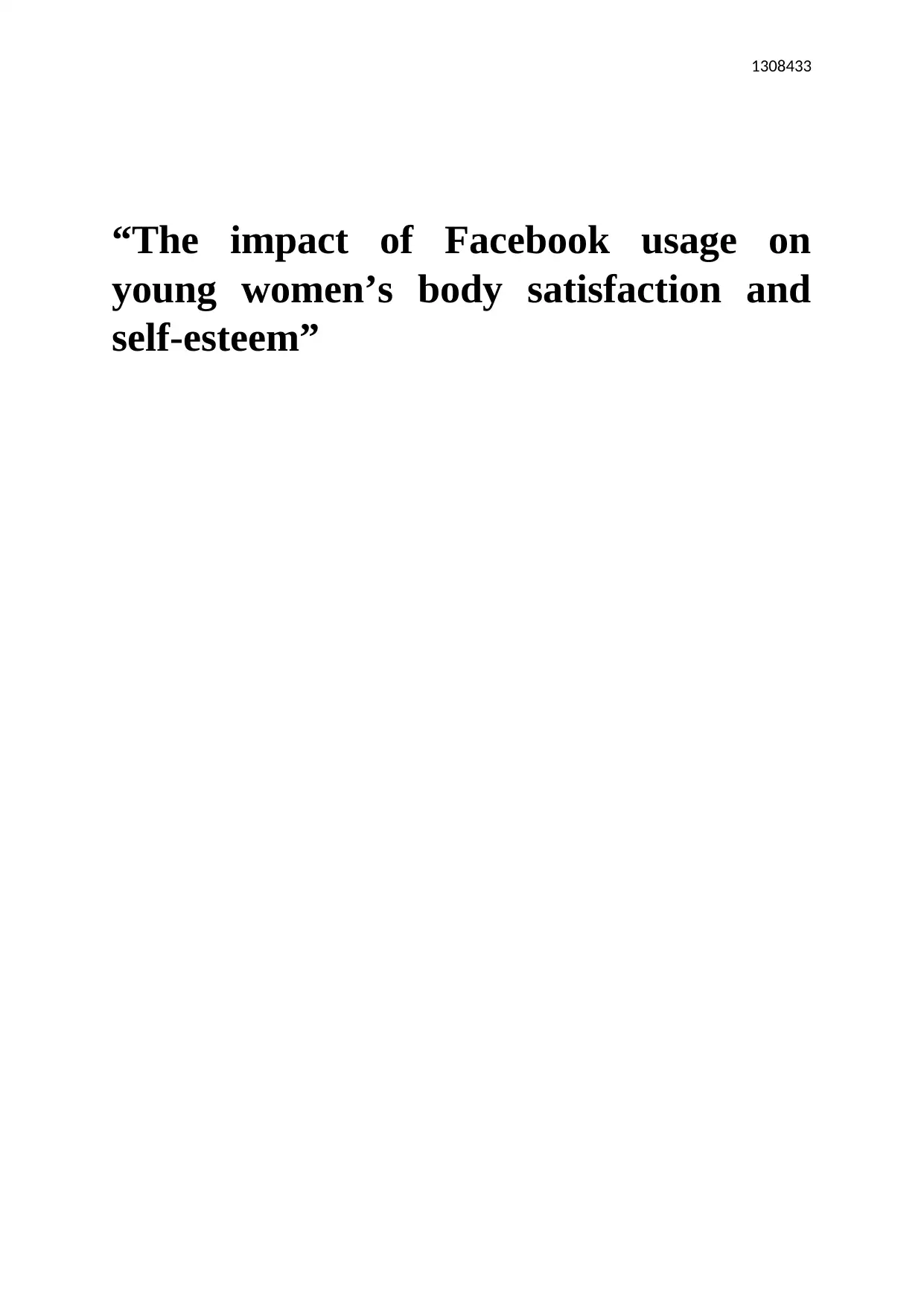
1308433
“The impact of Facebook usage on
young women’s body satisfaction and
self-esteem”
“The impact of Facebook usage on
young women’s body satisfaction and
self-esteem”
Secure Best Marks with AI Grader
Need help grading? Try our AI Grader for instant feedback on your assignments.
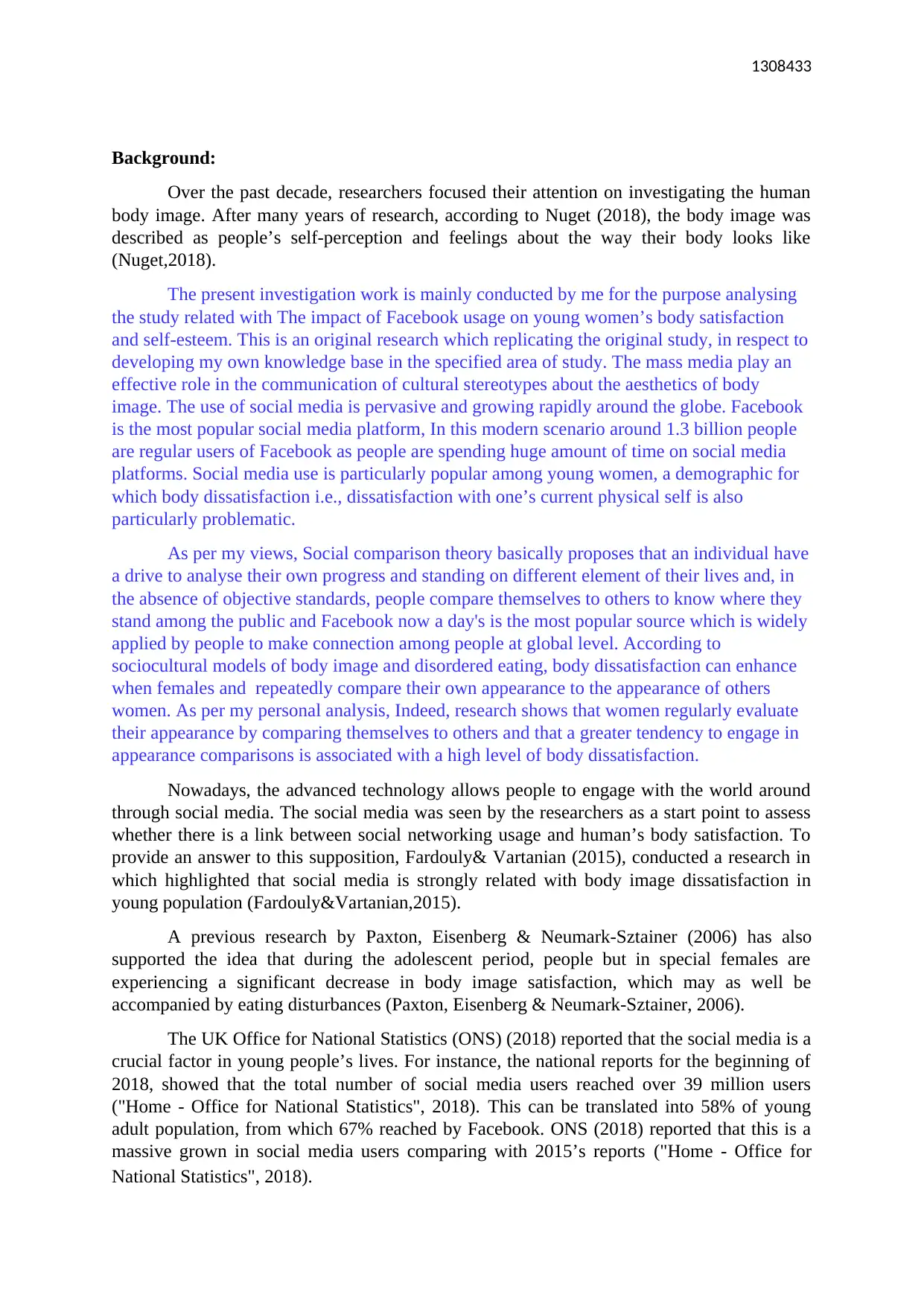
1308433
Background:
Over the past decade, researchers focused their attention on investigating the human
body image. After many years of research, according to Nuget (2018), the body image was
described as people’s self-perception and feelings about the way their body looks like
(Nuget,2018).
The present investigation work is mainly conducted by me for the purpose analysing
the study related with The impact of Facebook usage on young women’s body satisfaction
and self-esteem. This is an original research which replicating the original study, in respect to
developing my own knowledge base in the specified area of study. The mass media play an
effective role in the communication of cultural stereotypes about the aesthetics of body
image. The use of social media is pervasive and growing rapidly around the globe. Facebook
is the most popular social media platform, In this modern scenario around 1.3 billion people
are regular users of Facebook as people are spending huge amount of time on social media
platforms. Social media use is particularly popular among young women, a demographic for
which body dissatisfaction i.e., dissatisfaction with one’s current physical self is also
particularly problematic.
As per my views, Social comparison theory basically proposes that an individual have
a drive to analyse their own progress and standing on different element of their lives and, in
the absence of objective standards, people compare themselves to others to know where they
stand among the public and Facebook now a day's is the most popular source which is widely
applied by people to make connection among people at global level. According to
sociocultural models of body image and disordered eating, body dissatisfaction can enhance
when females and repeatedly compare their own appearance to the appearance of others
women. As per my personal analysis, Indeed, research shows that women regularly evaluate
their appearance by comparing themselves to others and that a greater tendency to engage in
appearance comparisons is associated with a high level of body dissatisfaction.
Nowadays, the advanced technology allows people to engage with the world around
through social media. The social media was seen by the researchers as a start point to assess
whether there is a link between social networking usage and human’s body satisfaction. To
provide an answer to this supposition, Fardouly& Vartanian (2015), conducted a research in
which highlighted that social media is strongly related with body image dissatisfaction in
young population (Fardouly&Vartanian,2015).
A previous research by Paxton, Eisenberg & Neumark-Sztainer (2006) has also
supported the idea that during the adolescent period, people but in special females are
experiencing a significant decrease in body image satisfaction, which may as well be
accompanied by eating disturbances (Paxton, Eisenberg & Neumark-Sztainer, 2006).
The UK Office for National Statistics (ONS) (2018) reported that the social media is a
crucial factor in young people’s lives. For instance, the national reports for the beginning of
2018, showed that the total number of social media users reached over 39 million users
("Home - Office for National Statistics", 2018). This can be translated into 58% of young
adult population, from which 67% reached by Facebook. ONS (2018) reported that this is a
massive grown in social media users comparing with 2015’s reports ("Home - Office for
National Statistics", 2018).
Background:
Over the past decade, researchers focused their attention on investigating the human
body image. After many years of research, according to Nuget (2018), the body image was
described as people’s self-perception and feelings about the way their body looks like
(Nuget,2018).
The present investigation work is mainly conducted by me for the purpose analysing
the study related with The impact of Facebook usage on young women’s body satisfaction
and self-esteem. This is an original research which replicating the original study, in respect to
developing my own knowledge base in the specified area of study. The mass media play an
effective role in the communication of cultural stereotypes about the aesthetics of body
image. The use of social media is pervasive and growing rapidly around the globe. Facebook
is the most popular social media platform, In this modern scenario around 1.3 billion people
are regular users of Facebook as people are spending huge amount of time on social media
platforms. Social media use is particularly popular among young women, a demographic for
which body dissatisfaction i.e., dissatisfaction with one’s current physical self is also
particularly problematic.
As per my views, Social comparison theory basically proposes that an individual have
a drive to analyse their own progress and standing on different element of their lives and, in
the absence of objective standards, people compare themselves to others to know where they
stand among the public and Facebook now a day's is the most popular source which is widely
applied by people to make connection among people at global level. According to
sociocultural models of body image and disordered eating, body dissatisfaction can enhance
when females and repeatedly compare their own appearance to the appearance of others
women. As per my personal analysis, Indeed, research shows that women regularly evaluate
their appearance by comparing themselves to others and that a greater tendency to engage in
appearance comparisons is associated with a high level of body dissatisfaction.
Nowadays, the advanced technology allows people to engage with the world around
through social media. The social media was seen by the researchers as a start point to assess
whether there is a link between social networking usage and human’s body satisfaction. To
provide an answer to this supposition, Fardouly& Vartanian (2015), conducted a research in
which highlighted that social media is strongly related with body image dissatisfaction in
young population (Fardouly&Vartanian,2015).
A previous research by Paxton, Eisenberg & Neumark-Sztainer (2006) has also
supported the idea that during the adolescent period, people but in special females are
experiencing a significant decrease in body image satisfaction, which may as well be
accompanied by eating disturbances (Paxton, Eisenberg & Neumark-Sztainer, 2006).
The UK Office for National Statistics (ONS) (2018) reported that the social media is a
crucial factor in young people’s lives. For instance, the national reports for the beginning of
2018, showed that the total number of social media users reached over 39 million users
("Home - Office for National Statistics", 2018). This can be translated into 58% of young
adult population, from which 67% reached by Facebook. ONS (2018) reported that this is a
massive grown in social media users comparing with 2015’s reports ("Home - Office for
National Statistics", 2018).
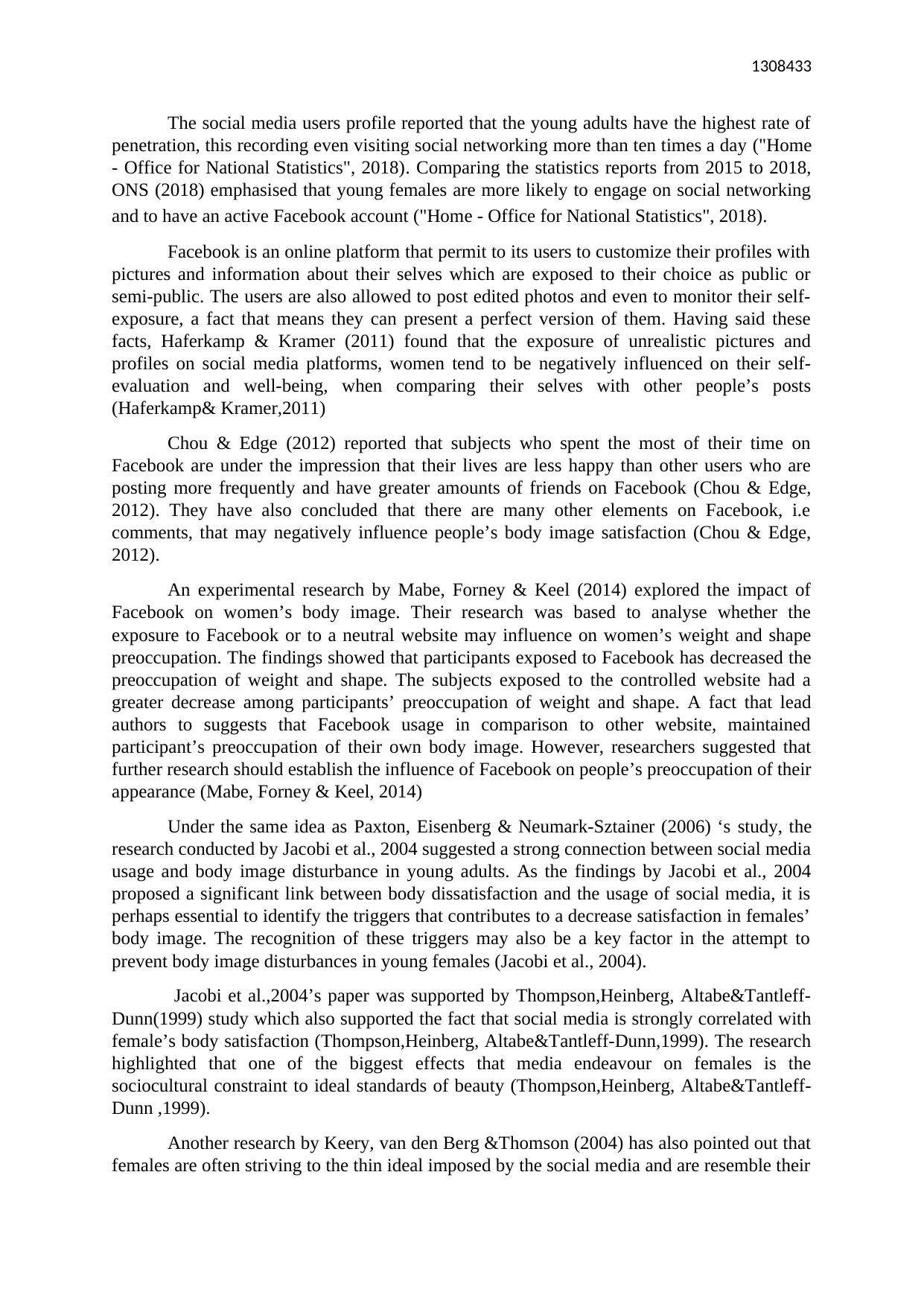
1308433
The social media users profile reported that the young adults have the highest rate of
penetration, this recording even visiting social networking more than ten times a day ("Home
- Office for National Statistics", 2018). Comparing the statistics reports from 2015 to 2018,
ONS (2018) emphasised that young females are more likely to engage on social networking
and to have an active Facebook account ("Home - Office for National Statistics", 2018).
Facebook is an online platform that permit to its users to customize their profiles with
pictures and information about their selves which are exposed to their choice as public or
semi-public. The users are also allowed to post edited photos and even to monitor their self-
exposure, a fact that means they can present a perfect version of them. Having said these
facts, Haferkamp & Kramer (2011) found that the exposure of unrealistic pictures and
profiles on social media platforms, women tend to be negatively influenced on their self-
evaluation and well-being, when comparing their selves with other people’s posts
(Haferkamp& Kramer,2011)
Chou & Edge (2012) reported that subjects who spent the most of their time on
Facebook are under the impression that their lives are less happy than other users who are
posting more frequently and have greater amounts of friends on Facebook (Chou & Edge,
2012). They have also concluded that there are many other elements on Facebook, i.e
comments, that may negatively influence people’s body image satisfaction (Chou & Edge,
2012).
An experimental research by Mabe, Forney & Keel (2014) explored the impact of
Facebook on women’s body image. Their research was based to analyse whether the
exposure to Facebook or to a neutral website may influence on women’s weight and shape
preoccupation. The findings showed that participants exposed to Facebook has decreased the
preoccupation of weight and shape. The subjects exposed to the controlled website had a
greater decrease among participants’ preoccupation of weight and shape. A fact that lead
authors to suggests that Facebook usage in comparison to other website, maintained
participant’s preoccupation of their own body image. However, researchers suggested that
further research should establish the influence of Facebook on people’s preoccupation of their
appearance (Mabe, Forney & Keel, 2014)
Under the same idea as Paxton, Eisenberg & Neumark-Sztainer (2006) ‘s study, the
research conducted by Jacobi et al., 2004 suggested a strong connection between social media
usage and body image disturbance in young adults. As the findings by Jacobi et al., 2004
proposed a significant link between body dissatisfaction and the usage of social media, it is
perhaps essential to identify the triggers that contributes to a decrease satisfaction in females’
body image. The recognition of these triggers may also be a key factor in the attempt to
prevent body image disturbances in young females (Jacobi et al., 2004).
Jacobi et al.,2004’s paper was supported by Thompson,Heinberg, Altabe&Tantleff-
Dunn(1999) study which also supported the fact that social media is strongly correlated with
female’s body satisfaction (Thompson,Heinberg, Altabe&Tantleff-Dunn,1999). The research
highlighted that one of the biggest effects that media endeavour on females is the
sociocultural constraint to ideal standards of beauty (Thompson,Heinberg, Altabe&Tantleff-
Dunn ,1999).
Another research by Keery, van den Berg &Thomson (2004) has also pointed out that
females are often striving to the thin ideal imposed by the social media and are resemble their
The social media users profile reported that the young adults have the highest rate of
penetration, this recording even visiting social networking more than ten times a day ("Home
- Office for National Statistics", 2018). Comparing the statistics reports from 2015 to 2018,
ONS (2018) emphasised that young females are more likely to engage on social networking
and to have an active Facebook account ("Home - Office for National Statistics", 2018).
Facebook is an online platform that permit to its users to customize their profiles with
pictures and information about their selves which are exposed to their choice as public or
semi-public. The users are also allowed to post edited photos and even to monitor their self-
exposure, a fact that means they can present a perfect version of them. Having said these
facts, Haferkamp & Kramer (2011) found that the exposure of unrealistic pictures and
profiles on social media platforms, women tend to be negatively influenced on their self-
evaluation and well-being, when comparing their selves with other people’s posts
(Haferkamp& Kramer,2011)
Chou & Edge (2012) reported that subjects who spent the most of their time on
Facebook are under the impression that their lives are less happy than other users who are
posting more frequently and have greater amounts of friends on Facebook (Chou & Edge,
2012). They have also concluded that there are many other elements on Facebook, i.e
comments, that may negatively influence people’s body image satisfaction (Chou & Edge,
2012).
An experimental research by Mabe, Forney & Keel (2014) explored the impact of
Facebook on women’s body image. Their research was based to analyse whether the
exposure to Facebook or to a neutral website may influence on women’s weight and shape
preoccupation. The findings showed that participants exposed to Facebook has decreased the
preoccupation of weight and shape. The subjects exposed to the controlled website had a
greater decrease among participants’ preoccupation of weight and shape. A fact that lead
authors to suggests that Facebook usage in comparison to other website, maintained
participant’s preoccupation of their own body image. However, researchers suggested that
further research should establish the influence of Facebook on people’s preoccupation of their
appearance (Mabe, Forney & Keel, 2014)
Under the same idea as Paxton, Eisenberg & Neumark-Sztainer (2006) ‘s study, the
research conducted by Jacobi et al., 2004 suggested a strong connection between social media
usage and body image disturbance in young adults. As the findings by Jacobi et al., 2004
proposed a significant link between body dissatisfaction and the usage of social media, it is
perhaps essential to identify the triggers that contributes to a decrease satisfaction in females’
body image. The recognition of these triggers may also be a key factor in the attempt to
prevent body image disturbances in young females (Jacobi et al., 2004).
Jacobi et al.,2004’s paper was supported by Thompson,Heinberg, Altabe&Tantleff-
Dunn(1999) study which also supported the fact that social media is strongly correlated with
female’s body satisfaction (Thompson,Heinberg, Altabe&Tantleff-Dunn,1999). The research
highlighted that one of the biggest effects that media endeavour on females is the
sociocultural constraint to ideal standards of beauty (Thompson,Heinberg, Altabe&Tantleff-
Dunn ,1999).
Another research by Keery, van den Berg &Thomson (2004) has also pointed out that
females are often striving to the thin ideal imposed by the social media and are resemble their
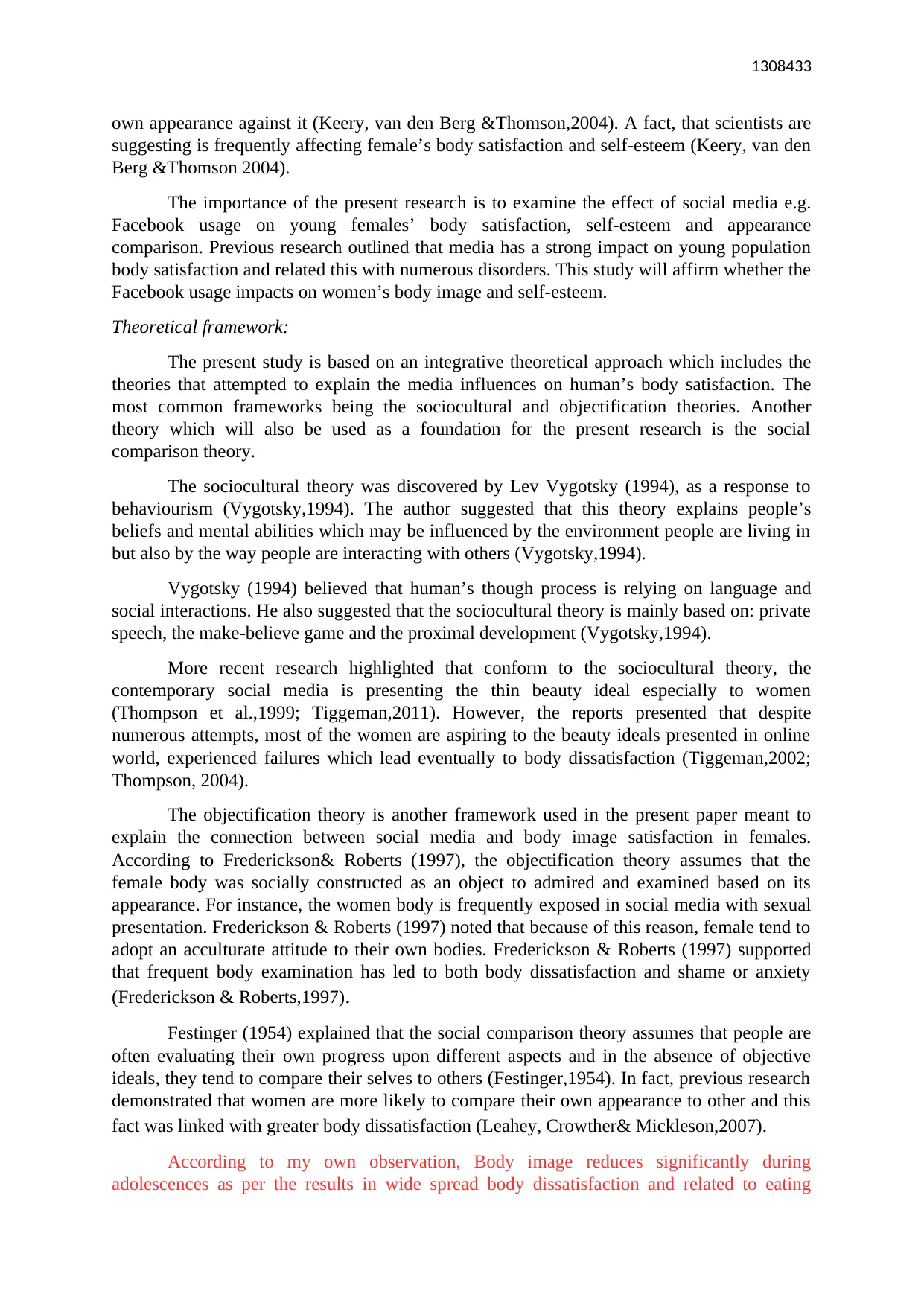
1308433
own appearance against it (Keery, van den Berg &Thomson,2004). A fact, that scientists are
suggesting is frequently affecting female’s body satisfaction and self-esteem (Keery, van den
Berg &Thomson 2004).
The importance of the present research is to examine the effect of social media e.g.
Facebook usage on young females’ body satisfaction, self-esteem and appearance
comparison. Previous research outlined that media has a strong impact on young population
body satisfaction and related this with numerous disorders. This study will affirm whether the
Facebook usage impacts on women’s body image and self-esteem.
Theoretical framework:
The present study is based on an integrative theoretical approach which includes the
theories that attempted to explain the media influences on human’s body satisfaction. The
most common frameworks being the sociocultural and objectification theories. Another
theory which will also be used as a foundation for the present research is the social
comparison theory.
The sociocultural theory was discovered by Lev Vygotsky (1994), as a response to
behaviourism (Vygotsky,1994). The author suggested that this theory explains people’s
beliefs and mental abilities which may be influenced by the environment people are living in
but also by the way people are interacting with others (Vygotsky,1994).
Vygotsky (1994) believed that human’s though process is relying on language and
social interactions. He also suggested that the sociocultural theory is mainly based on: private
speech, the make-believe game and the proximal development (Vygotsky,1994).
More recent research highlighted that conform to the sociocultural theory, the
contemporary social media is presenting the thin beauty ideal especially to women
(Thompson et al.,1999; Tiggeman,2011). However, the reports presented that despite
numerous attempts, most of the women are aspiring to the beauty ideals presented in online
world, experienced failures which lead eventually to body dissatisfaction (Tiggeman,2002;
Thompson, 2004).
The objectification theory is another framework used in the present paper meant to
explain the connection between social media and body image satisfaction in females.
According to Frederickson& Roberts (1997), the objectification theory assumes that the
female body was socially constructed as an object to admired and examined based on its
appearance. For instance, the women body is frequently exposed in social media with sexual
presentation. Frederickson & Roberts (1997) noted that because of this reason, female tend to
adopt an acculturate attitude to their own bodies. Frederickson & Roberts (1997) supported
that frequent body examination has led to both body dissatisfaction and shame or anxiety
(Frederickson & Roberts,1997).
Festinger (1954) explained that the social comparison theory assumes that people are
often evaluating their own progress upon different aspects and in the absence of objective
ideals, they tend to compare their selves to others (Festinger,1954). In fact, previous research
demonstrated that women are more likely to compare their own appearance to other and this
fact was linked with greater body dissatisfaction (Leahey, Crowther& Mickleson,2007).
According to my own observation, Body image reduces significantly during
adolescences as per the results in wide spread body dissatisfaction and related to eating
own appearance against it (Keery, van den Berg &Thomson,2004). A fact, that scientists are
suggesting is frequently affecting female’s body satisfaction and self-esteem (Keery, van den
Berg &Thomson 2004).
The importance of the present research is to examine the effect of social media e.g.
Facebook usage on young females’ body satisfaction, self-esteem and appearance
comparison. Previous research outlined that media has a strong impact on young population
body satisfaction and related this with numerous disorders. This study will affirm whether the
Facebook usage impacts on women’s body image and self-esteem.
Theoretical framework:
The present study is based on an integrative theoretical approach which includes the
theories that attempted to explain the media influences on human’s body satisfaction. The
most common frameworks being the sociocultural and objectification theories. Another
theory which will also be used as a foundation for the present research is the social
comparison theory.
The sociocultural theory was discovered by Lev Vygotsky (1994), as a response to
behaviourism (Vygotsky,1994). The author suggested that this theory explains people’s
beliefs and mental abilities which may be influenced by the environment people are living in
but also by the way people are interacting with others (Vygotsky,1994).
Vygotsky (1994) believed that human’s though process is relying on language and
social interactions. He also suggested that the sociocultural theory is mainly based on: private
speech, the make-believe game and the proximal development (Vygotsky,1994).
More recent research highlighted that conform to the sociocultural theory, the
contemporary social media is presenting the thin beauty ideal especially to women
(Thompson et al.,1999; Tiggeman,2011). However, the reports presented that despite
numerous attempts, most of the women are aspiring to the beauty ideals presented in online
world, experienced failures which lead eventually to body dissatisfaction (Tiggeman,2002;
Thompson, 2004).
The objectification theory is another framework used in the present paper meant to
explain the connection between social media and body image satisfaction in females.
According to Frederickson& Roberts (1997), the objectification theory assumes that the
female body was socially constructed as an object to admired and examined based on its
appearance. For instance, the women body is frequently exposed in social media with sexual
presentation. Frederickson & Roberts (1997) noted that because of this reason, female tend to
adopt an acculturate attitude to their own bodies. Frederickson & Roberts (1997) supported
that frequent body examination has led to both body dissatisfaction and shame or anxiety
(Frederickson & Roberts,1997).
Festinger (1954) explained that the social comparison theory assumes that people are
often evaluating their own progress upon different aspects and in the absence of objective
ideals, they tend to compare their selves to others (Festinger,1954). In fact, previous research
demonstrated that women are more likely to compare their own appearance to other and this
fact was linked with greater body dissatisfaction (Leahey, Crowther& Mickleson,2007).
According to my own observation, Body image reduces significantly during
adolescences as per the results in wide spread body dissatisfaction and related to eating
Secure Best Marks with AI Grader
Need help grading? Try our AI Grader for instant feedback on your assignments.
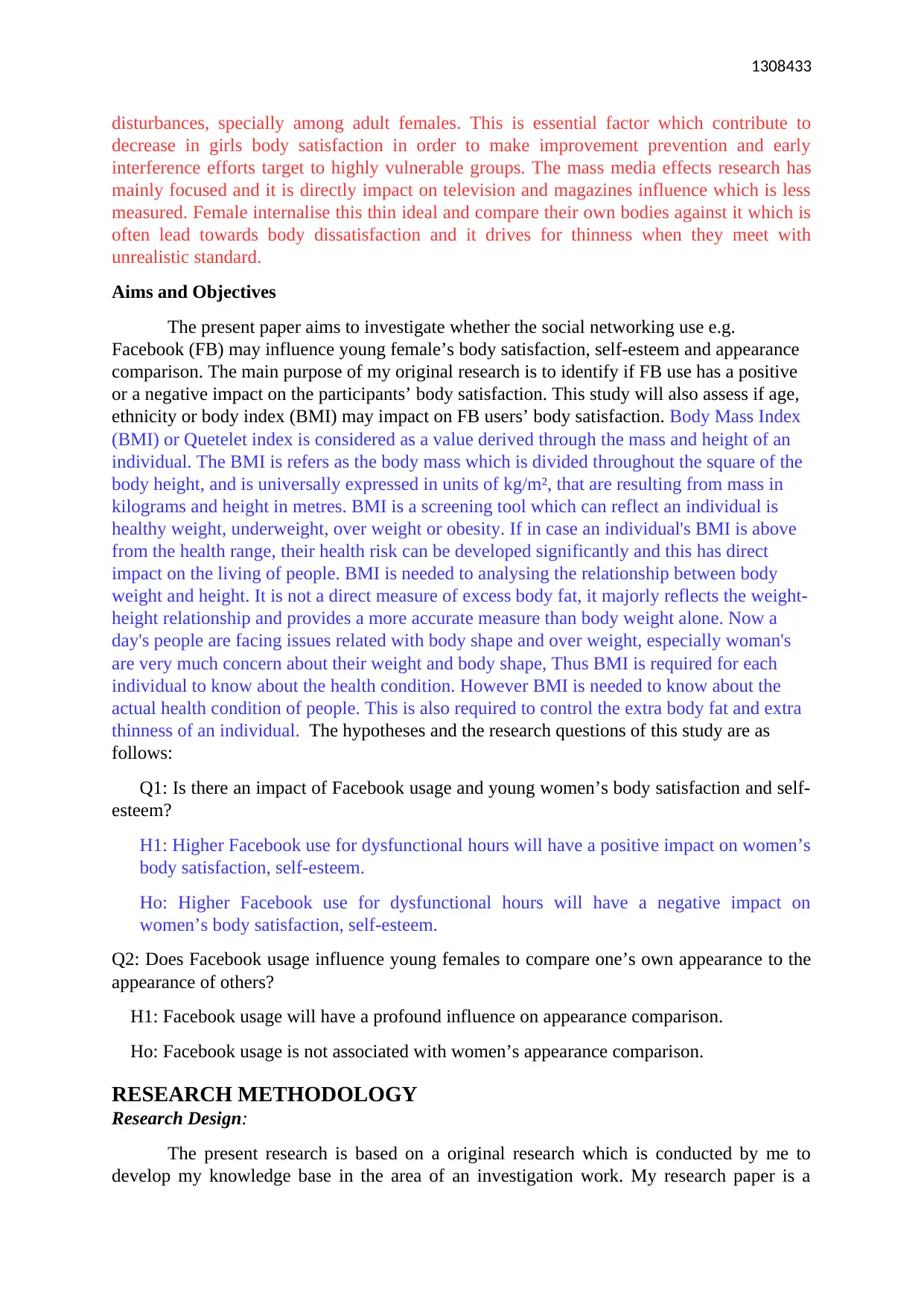
1308433
disturbances, specially among adult females. This is essential factor which contribute to
decrease in girls body satisfaction in order to make improvement prevention and early
interference efforts target to highly vulnerable groups. The mass media effects research has
mainly focused and it is directly impact on television and magazines influence which is less
measured. Female internalise this thin ideal and compare their own bodies against it which is
often lead towards body dissatisfaction and it drives for thinness when they meet with
unrealistic standard.
Aims and Objectives
The present paper aims to investigate whether the social networking use e.g.
Facebook (FB) may influence young female’s body satisfaction, self-esteem and appearance
comparison. The main purpose of my original research is to identify if FB use has a positive
or a negative impact on the participants’ body satisfaction. This study will also assess if age,
ethnicity or body index (BMI) may impact on FB users’ body satisfaction. Body Mass Index
(BMI) or Quetelet index is considered as a value derived through the mass and height of an
individual. The BMI is refers as the body mass which is divided throughout the square of the
body height, and is universally expressed in units of kg/m², that are resulting from mass in
kilograms and height in metres. BMI is a screening tool which can reflect an individual is
healthy weight, underweight, over weight or obesity. If in case an individual's BMI is above
from the health range, their health risk can be developed significantly and this has direct
impact on the living of people. BMI is needed to analysing the relationship between body
weight and height. It is not a direct measure of excess body fat, it majorly reflects the weight-
height relationship and provides a more accurate measure than body weight alone. Now a
day's people are facing issues related with body shape and over weight, especially woman's
are very much concern about their weight and body shape, Thus BMI is required for each
individual to know about the health condition. However BMI is needed to know about the
actual health condition of people. This is also required to control the extra body fat and extra
thinness of an individual. The hypotheses and the research questions of this study are as
follows:
Q1: Is there an impact of Facebook usage and young women’s body satisfaction and self-
esteem?
H1: Higher Facebook use for dysfunctional hours will have a positive impact on women’s
body satisfaction, self-esteem.
Ho: Higher Facebook use for dysfunctional hours will have a negative impact on
women’s body satisfaction, self-esteem.
Q2: Does Facebook usage influence young females to compare one’s own appearance to the
appearance of others?
H1: Facebook usage will have a profound influence on appearance comparison.
Ho: Facebook usage is not associated with women’s appearance comparison.
RESEARCH METHODOLOGY
Research Design:
The present research is based on a original research which is conducted by me to
develop my knowledge base in the area of an investigation work. My research paper is a
disturbances, specially among adult females. This is essential factor which contribute to
decrease in girls body satisfaction in order to make improvement prevention and early
interference efforts target to highly vulnerable groups. The mass media effects research has
mainly focused and it is directly impact on television and magazines influence which is less
measured. Female internalise this thin ideal and compare their own bodies against it which is
often lead towards body dissatisfaction and it drives for thinness when they meet with
unrealistic standard.
Aims and Objectives
The present paper aims to investigate whether the social networking use e.g.
Facebook (FB) may influence young female’s body satisfaction, self-esteem and appearance
comparison. The main purpose of my original research is to identify if FB use has a positive
or a negative impact on the participants’ body satisfaction. This study will also assess if age,
ethnicity or body index (BMI) may impact on FB users’ body satisfaction. Body Mass Index
(BMI) or Quetelet index is considered as a value derived through the mass and height of an
individual. The BMI is refers as the body mass which is divided throughout the square of the
body height, and is universally expressed in units of kg/m², that are resulting from mass in
kilograms and height in metres. BMI is a screening tool which can reflect an individual is
healthy weight, underweight, over weight or obesity. If in case an individual's BMI is above
from the health range, their health risk can be developed significantly and this has direct
impact on the living of people. BMI is needed to analysing the relationship between body
weight and height. It is not a direct measure of excess body fat, it majorly reflects the weight-
height relationship and provides a more accurate measure than body weight alone. Now a
day's people are facing issues related with body shape and over weight, especially woman's
are very much concern about their weight and body shape, Thus BMI is required for each
individual to know about the health condition. However BMI is needed to know about the
actual health condition of people. This is also required to control the extra body fat and extra
thinness of an individual. The hypotheses and the research questions of this study are as
follows:
Q1: Is there an impact of Facebook usage and young women’s body satisfaction and self-
esteem?
H1: Higher Facebook use for dysfunctional hours will have a positive impact on women’s
body satisfaction, self-esteem.
Ho: Higher Facebook use for dysfunctional hours will have a negative impact on
women’s body satisfaction, self-esteem.
Q2: Does Facebook usage influence young females to compare one’s own appearance to the
appearance of others?
H1: Facebook usage will have a profound influence on appearance comparison.
Ho: Facebook usage is not associated with women’s appearance comparison.
RESEARCH METHODOLOGY
Research Design:
The present research is based on a original research which is conducted by me to
develop my knowledge base in the area of an investigation work. My research paper is a
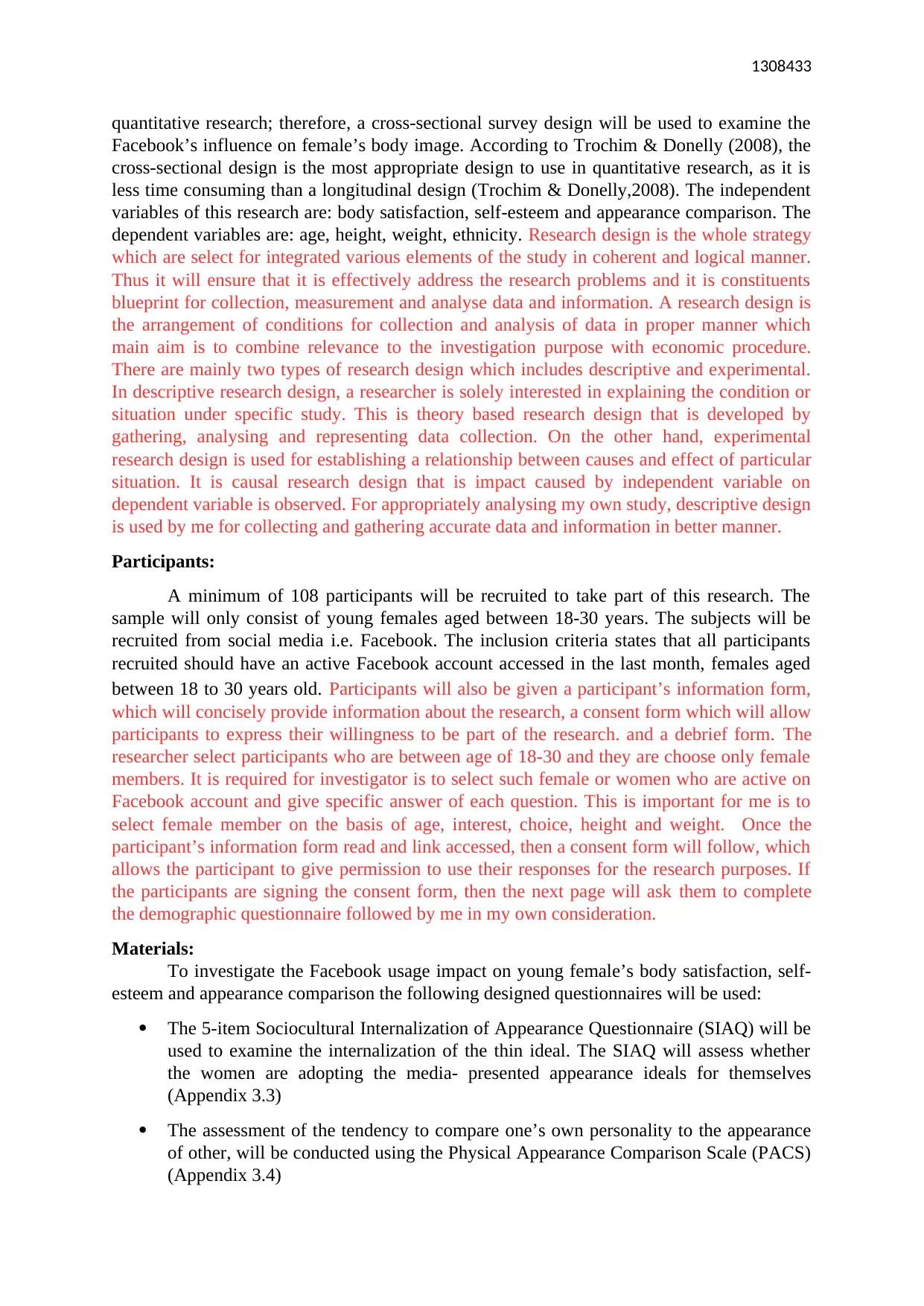
1308433
quantitative research; therefore, a cross-sectional survey design will be used to examine the
Facebook’s influence on female’s body image. According to Trochim & Donelly (2008), the
cross-sectional design is the most appropriate design to use in quantitative research, as it is
less time consuming than a longitudinal design (Trochim & Donelly,2008). The independent
variables of this research are: body satisfaction, self-esteem and appearance comparison. The
dependent variables are: age, height, weight, ethnicity. Research design is the whole strategy
which are select for integrated various elements of the study in coherent and logical manner.
Thus it will ensure that it is effectively address the research problems and it is constituents
blueprint for collection, measurement and analyse data and information. A research design is
the arrangement of conditions for collection and analysis of data in proper manner which
main aim is to combine relevance to the investigation purpose with economic procedure.
There are mainly two types of research design which includes descriptive and experimental.
In descriptive research design, a researcher is solely interested in explaining the condition or
situation under specific study. This is theory based research design that is developed by
gathering, analysing and representing data collection. On the other hand, experimental
research design is used for establishing a relationship between causes and effect of particular
situation. It is causal research design that is impact caused by independent variable on
dependent variable is observed. For appropriately analysing my own study, descriptive design
is used by me for collecting and gathering accurate data and information in better manner.
Participants:
A minimum of 108 participants will be recruited to take part of this research. The
sample will only consist of young females aged between 18-30 years. The subjects will be
recruited from social media i.e. Facebook. The inclusion criteria states that all participants
recruited should have an active Facebook account accessed in the last month, females aged
between 18 to 30 years old. Participants will also be given a participant’s information form,
which will concisely provide information about the research, a consent form which will allow
participants to express their willingness to be part of the research. and a debrief form. The
researcher select participants who are between age of 18-30 and they are choose only female
members. It is required for investigator is to select such female or women who are active on
Facebook account and give specific answer of each question. This is important for me is to
select female member on the basis of age, interest, choice, height and weight. Once the
participant’s information form read and link accessed, then a consent form will follow, which
allows the participant to give permission to use their responses for the research purposes. If
the participants are signing the consent form, then the next page will ask them to complete
the demographic questionnaire followed by me in my own consideration.
Materials:
To investigate the Facebook usage impact on young female’s body satisfaction, self-
esteem and appearance comparison the following designed questionnaires will be used:
The 5-item Sociocultural Internalization of Appearance Questionnaire (SIAQ) will be
used to examine the internalization of the thin ideal. The SIAQ will assess whether
the women are adopting the media- presented appearance ideals for themselves
(Appendix 3.3)
The assessment of the tendency to compare one’s own personality to the appearance
of other, will be conducted using the Physical Appearance Comparison Scale (PACS)
(Appendix 3.4)
quantitative research; therefore, a cross-sectional survey design will be used to examine the
Facebook’s influence on female’s body image. According to Trochim & Donelly (2008), the
cross-sectional design is the most appropriate design to use in quantitative research, as it is
less time consuming than a longitudinal design (Trochim & Donelly,2008). The independent
variables of this research are: body satisfaction, self-esteem and appearance comparison. The
dependent variables are: age, height, weight, ethnicity. Research design is the whole strategy
which are select for integrated various elements of the study in coherent and logical manner.
Thus it will ensure that it is effectively address the research problems and it is constituents
blueprint for collection, measurement and analyse data and information. A research design is
the arrangement of conditions for collection and analysis of data in proper manner which
main aim is to combine relevance to the investigation purpose with economic procedure.
There are mainly two types of research design which includes descriptive and experimental.
In descriptive research design, a researcher is solely interested in explaining the condition or
situation under specific study. This is theory based research design that is developed by
gathering, analysing and representing data collection. On the other hand, experimental
research design is used for establishing a relationship between causes and effect of particular
situation. It is causal research design that is impact caused by independent variable on
dependent variable is observed. For appropriately analysing my own study, descriptive design
is used by me for collecting and gathering accurate data and information in better manner.
Participants:
A minimum of 108 participants will be recruited to take part of this research. The
sample will only consist of young females aged between 18-30 years. The subjects will be
recruited from social media i.e. Facebook. The inclusion criteria states that all participants
recruited should have an active Facebook account accessed in the last month, females aged
between 18 to 30 years old. Participants will also be given a participant’s information form,
which will concisely provide information about the research, a consent form which will allow
participants to express their willingness to be part of the research. and a debrief form. The
researcher select participants who are between age of 18-30 and they are choose only female
members. It is required for investigator is to select such female or women who are active on
Facebook account and give specific answer of each question. This is important for me is to
select female member on the basis of age, interest, choice, height and weight. Once the
participant’s information form read and link accessed, then a consent form will follow, which
allows the participant to give permission to use their responses for the research purposes. If
the participants are signing the consent form, then the next page will ask them to complete
the demographic questionnaire followed by me in my own consideration.
Materials:
To investigate the Facebook usage impact on young female’s body satisfaction, self-
esteem and appearance comparison the following designed questionnaires will be used:
The 5-item Sociocultural Internalization of Appearance Questionnaire (SIAQ) will be
used to examine the internalization of the thin ideal. The SIAQ will assess whether
the women are adopting the media- presented appearance ideals for themselves
(Appendix 3.3)
The assessment of the tendency to compare one’s own personality to the appearance
of other, will be conducted using the Physical Appearance Comparison Scale (PACS)
(Appendix 3.4)
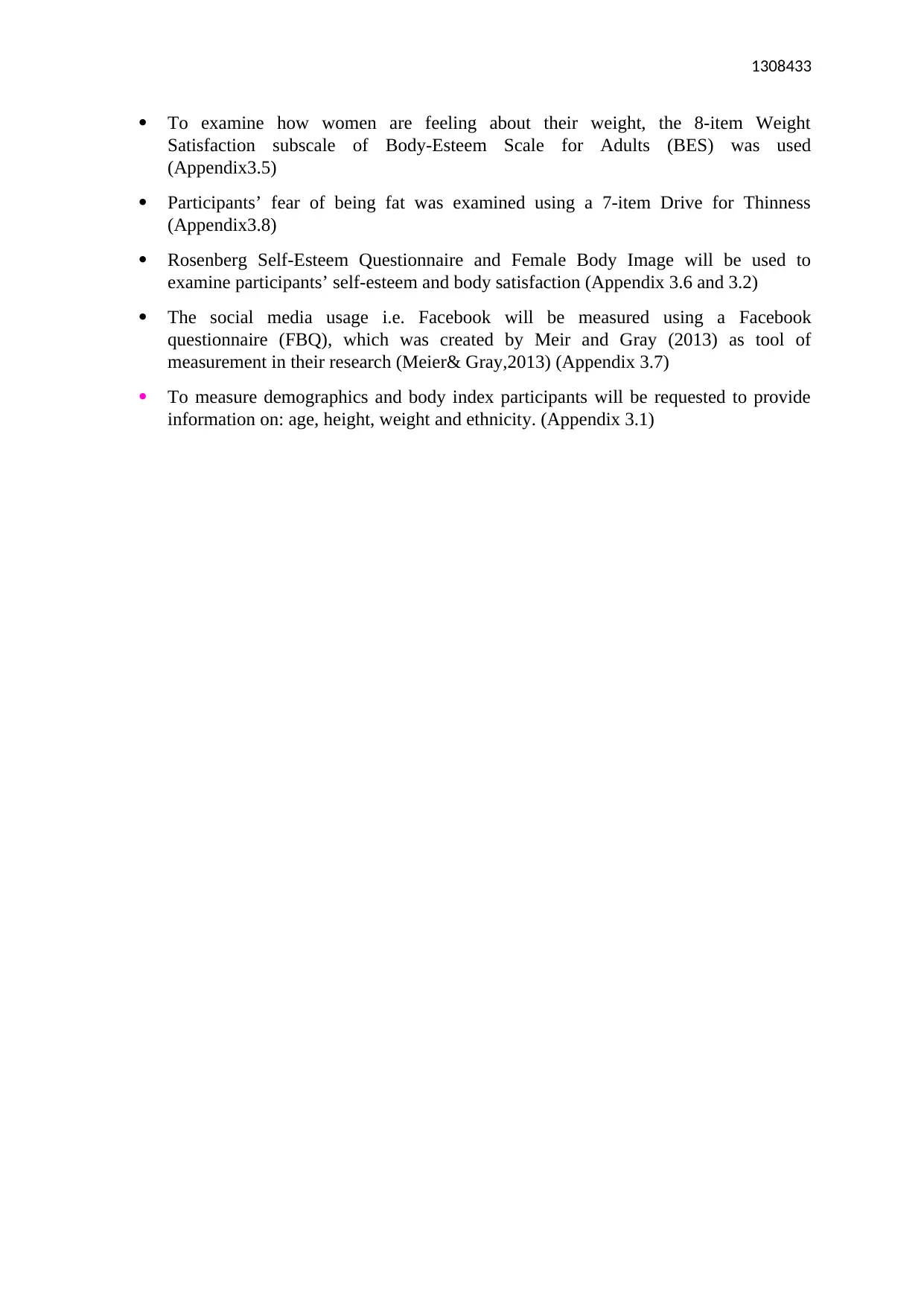
1308433
To examine how women are feeling about their weight, the 8-item Weight
Satisfaction subscale of Body-Esteem Scale for Adults (BES) was used
(Appendix3.5)
Participants’ fear of being fat was examined using a 7-item Drive for Thinness
(Appendix3.8)
Rosenberg Self-Esteem Questionnaire and Female Body Image will be used to
examine participants’ self-esteem and body satisfaction (Appendix 3.6 and 3.2)
The social media usage i.e. Facebook will be measured using a Facebook
questionnaire (FBQ), which was created by Meir and Gray (2013) as tool of
measurement in their research (Meier& Gray,2013) (Appendix 3.7)
To measure demographics and body index participants will be requested to provide
information on: age, height, weight and ethnicity. (Appendix 3.1)
To examine how women are feeling about their weight, the 8-item Weight
Satisfaction subscale of Body-Esteem Scale for Adults (BES) was used
(Appendix3.5)
Participants’ fear of being fat was examined using a 7-item Drive for Thinness
(Appendix3.8)
Rosenberg Self-Esteem Questionnaire and Female Body Image will be used to
examine participants’ self-esteem and body satisfaction (Appendix 3.6 and 3.2)
The social media usage i.e. Facebook will be measured using a Facebook
questionnaire (FBQ), which was created by Meir and Gray (2013) as tool of
measurement in their research (Meier& Gray,2013) (Appendix 3.7)
To measure demographics and body index participants will be requested to provide
information on: age, height, weight and ethnicity. (Appendix 3.1)
Paraphrase This Document
Need a fresh take? Get an instant paraphrase of this document with our AI Paraphraser
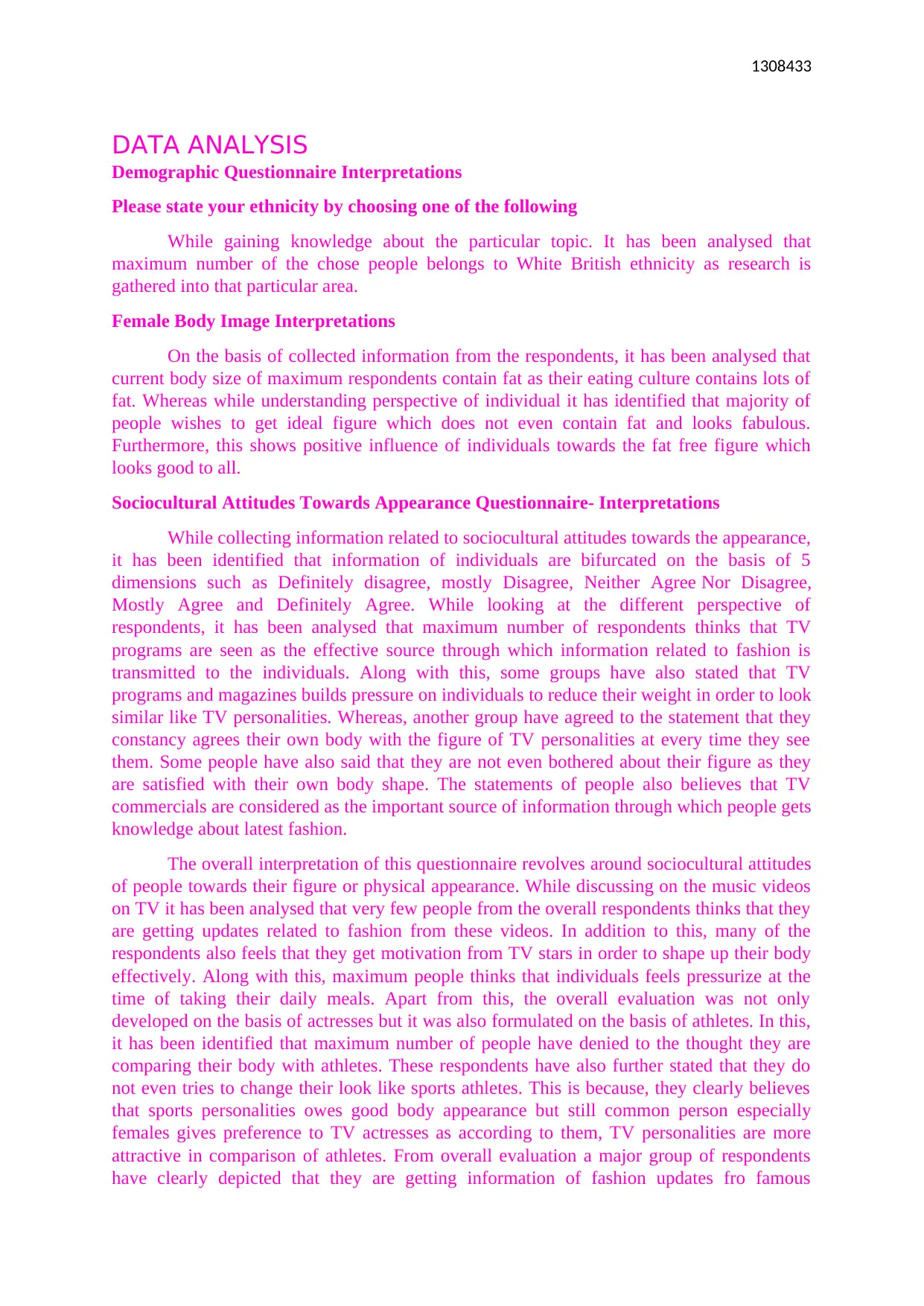
1308433
DATA ANALYSIS
Demographic Questionnaire Interpretations
Please state your ethnicity by choosing one of the following
While gaining knowledge about the particular topic. It has been analysed that
maximum number of the chose people belongs to White British ethnicity as research is
gathered into that particular area.
Female Body Image Interpretations
On the basis of collected information from the respondents, it has been analysed that
current body size of maximum respondents contain fat as their eating culture contains lots of
fat. Whereas while understanding perspective of individual it has identified that majority of
people wishes to get ideal figure which does not even contain fat and looks fabulous.
Furthermore, this shows positive influence of individuals towards the fat free figure which
looks good to all.
Sociocultural Attitudes Towards Appearance Questionnaire- Interpretations
While collecting information related to sociocultural attitudes towards the appearance,
it has been identified that information of individuals are bifurcated on the basis of 5
dimensions such as Definitely disagree, mostly Disagree, Neither Agree Nor Disagree,
Mostly Agree and Definitely Agree. While looking at the different perspective of
respondents, it has been analysed that maximum number of respondents thinks that TV
programs are seen as the effective source through which information related to fashion is
transmitted to the individuals. Along with this, some groups have also stated that TV
programs and magazines builds pressure on individuals to reduce their weight in order to look
similar like TV personalities. Whereas, another group have agreed to the statement that they
constancy agrees their own body with the figure of TV personalities at every time they see
them. Some people have also said that they are not even bothered about their figure as they
are satisfied with their own body shape. The statements of people also believes that TV
commercials are considered as the important source of information through which people gets
knowledge about latest fashion.
The overall interpretation of this questionnaire revolves around sociocultural attitudes
of people towards their figure or physical appearance. While discussing on the music videos
on TV it has been analysed that very few people from the overall respondents thinks that they
are getting updates related to fashion from these videos. In addition to this, many of the
respondents also feels that they get motivation from TV stars in order to shape up their body
effectively. Along with this, maximum people thinks that individuals feels pressurize at the
time of taking their daily meals. Apart from this, the overall evaluation was not only
developed on the basis of actresses but it was also formulated on the basis of athletes. In this,
it has been identified that maximum number of people have denied to the thought they are
comparing their body with athletes. These respondents have also further stated that they do
not even tries to change their look like sports athletes. This is because, they clearly believes
that sports personalities owes good body appearance but still common person especially
females gives preference to TV actresses as according to them, TV personalities are more
attractive in comparison of athletes. From overall evaluation a major group of respondents
have clearly depicted that they are getting information of fashion updates fro famous
DATA ANALYSIS
Demographic Questionnaire Interpretations
Please state your ethnicity by choosing one of the following
While gaining knowledge about the particular topic. It has been analysed that
maximum number of the chose people belongs to White British ethnicity as research is
gathered into that particular area.
Female Body Image Interpretations
On the basis of collected information from the respondents, it has been analysed that
current body size of maximum respondents contain fat as their eating culture contains lots of
fat. Whereas while understanding perspective of individual it has identified that majority of
people wishes to get ideal figure which does not even contain fat and looks fabulous.
Furthermore, this shows positive influence of individuals towards the fat free figure which
looks good to all.
Sociocultural Attitudes Towards Appearance Questionnaire- Interpretations
While collecting information related to sociocultural attitudes towards the appearance,
it has been identified that information of individuals are bifurcated on the basis of 5
dimensions such as Definitely disagree, mostly Disagree, Neither Agree Nor Disagree,
Mostly Agree and Definitely Agree. While looking at the different perspective of
respondents, it has been analysed that maximum number of respondents thinks that TV
programs are seen as the effective source through which information related to fashion is
transmitted to the individuals. Along with this, some groups have also stated that TV
programs and magazines builds pressure on individuals to reduce their weight in order to look
similar like TV personalities. Whereas, another group have agreed to the statement that they
constancy agrees their own body with the figure of TV personalities at every time they see
them. Some people have also said that they are not even bothered about their figure as they
are satisfied with their own body shape. The statements of people also believes that TV
commercials are considered as the important source of information through which people gets
knowledge about latest fashion.
The overall interpretation of this questionnaire revolves around sociocultural attitudes
of people towards their figure or physical appearance. While discussing on the music videos
on TV it has been analysed that very few people from the overall respondents thinks that they
are getting updates related to fashion from these videos. In addition to this, many of the
respondents also feels that they get motivation from TV stars in order to shape up their body
effectively. Along with this, maximum people thinks that individuals feels pressurize at the
time of taking their daily meals. Apart from this, the overall evaluation was not only
developed on the basis of actresses but it was also formulated on the basis of athletes. In this,
it has been identified that maximum number of people have denied to the thought they are
comparing their body with athletes. These respondents have also further stated that they do
not even tries to change their look like sports athletes. This is because, they clearly believes
that sports personalities owes good body appearance but still common person especially
females gives preference to TV actresses as according to them, TV personalities are more
attractive in comparison of athletes. From overall evaluation a major group of respondents
have clearly depicted that they are getting information of fashion updates fro famous
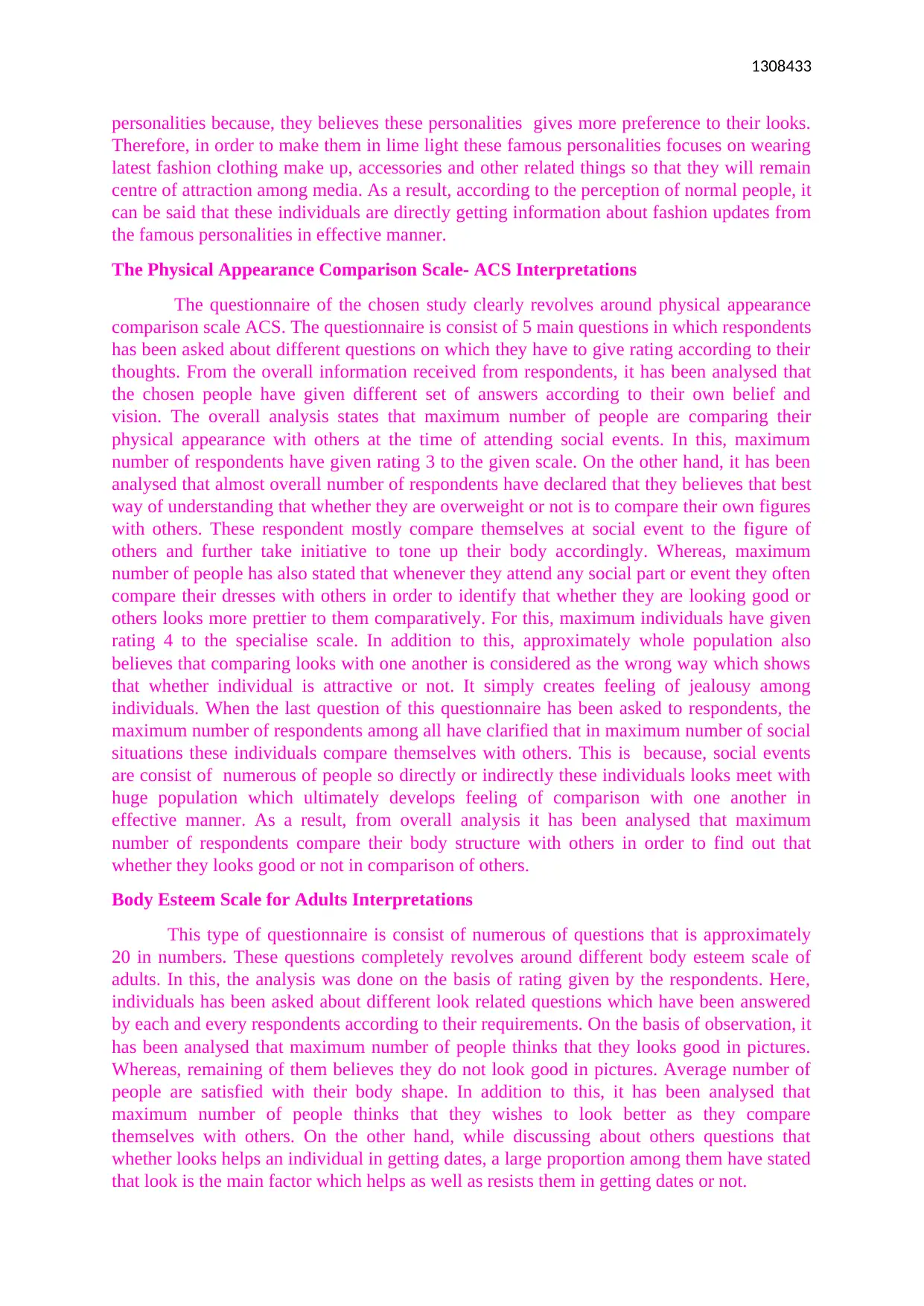
1308433
personalities because, they believes these personalities gives more preference to their looks.
Therefore, in order to make them in lime light these famous personalities focuses on wearing
latest fashion clothing make up, accessories and other related things so that they will remain
centre of attraction among media. As a result, according to the perception of normal people, it
can be said that these individuals are directly getting information about fashion updates from
the famous personalities in effective manner.
The Physical Appearance Comparison Scale- ACS Interpretations
The questionnaire of the chosen study clearly revolves around physical appearance
comparison scale ACS. The questionnaire is consist of 5 main questions in which respondents
has been asked about different questions on which they have to give rating according to their
thoughts. From the overall information received from respondents, it has been analysed that
the chosen people have given different set of answers according to their own belief and
vision. The overall analysis states that maximum number of people are comparing their
physical appearance with others at the time of attending social events. In this, maximum
number of respondents have given rating 3 to the given scale. On the other hand, it has been
analysed that almost overall number of respondents have declared that they believes that best
way of understanding that whether they are overweight or not is to compare their own figures
with others. These respondent mostly compare themselves at social event to the figure of
others and further take initiative to tone up their body accordingly. Whereas, maximum
number of people has also stated that whenever they attend any social part or event they often
compare their dresses with others in order to identify that whether they are looking good or
others looks more prettier to them comparatively. For this, maximum individuals have given
rating 4 to the specialise scale. In addition to this, approximately whole population also
believes that comparing looks with one another is considered as the wrong way which shows
that whether individual is attractive or not. It simply creates feeling of jealousy among
individuals. When the last question of this questionnaire has been asked to respondents, the
maximum number of respondents among all have clarified that in maximum number of social
situations these individuals compare themselves with others. This is because, social events
are consist of numerous of people so directly or indirectly these individuals looks meet with
huge population which ultimately develops feeling of comparison with one another in
effective manner. As a result, from overall analysis it has been analysed that maximum
number of respondents compare their body structure with others in order to find out that
whether they looks good or not in comparison of others.
Body Esteem Scale for Adults Interpretations
This type of questionnaire is consist of numerous of questions that is approximately
20 in numbers. These questions completely revolves around different body esteem scale of
adults. In this, the analysis was done on the basis of rating given by the respondents. Here,
individuals has been asked about different look related questions which have been answered
by each and every respondents according to their requirements. On the basis of observation, it
has been analysed that maximum number of people thinks that they looks good in pictures.
Whereas, remaining of them believes they do not look good in pictures. Average number of
people are satisfied with their body shape. In addition to this, it has been analysed that
maximum number of people thinks that they wishes to look better as they compare
themselves with others. On the other hand, while discussing about others questions that
whether looks helps an individual in getting dates, a large proportion among them have stated
that look is the main factor which helps as well as resists them in getting dates or not.
personalities because, they believes these personalities gives more preference to their looks.
Therefore, in order to make them in lime light these famous personalities focuses on wearing
latest fashion clothing make up, accessories and other related things so that they will remain
centre of attraction among media. As a result, according to the perception of normal people, it
can be said that these individuals are directly getting information about fashion updates from
the famous personalities in effective manner.
The Physical Appearance Comparison Scale- ACS Interpretations
The questionnaire of the chosen study clearly revolves around physical appearance
comparison scale ACS. The questionnaire is consist of 5 main questions in which respondents
has been asked about different questions on which they have to give rating according to their
thoughts. From the overall information received from respondents, it has been analysed that
the chosen people have given different set of answers according to their own belief and
vision. The overall analysis states that maximum number of people are comparing their
physical appearance with others at the time of attending social events. In this, maximum
number of respondents have given rating 3 to the given scale. On the other hand, it has been
analysed that almost overall number of respondents have declared that they believes that best
way of understanding that whether they are overweight or not is to compare their own figures
with others. These respondent mostly compare themselves at social event to the figure of
others and further take initiative to tone up their body accordingly. Whereas, maximum
number of people has also stated that whenever they attend any social part or event they often
compare their dresses with others in order to identify that whether they are looking good or
others looks more prettier to them comparatively. For this, maximum individuals have given
rating 4 to the specialise scale. In addition to this, approximately whole population also
believes that comparing looks with one another is considered as the wrong way which shows
that whether individual is attractive or not. It simply creates feeling of jealousy among
individuals. When the last question of this questionnaire has been asked to respondents, the
maximum number of respondents among all have clarified that in maximum number of social
situations these individuals compare themselves with others. This is because, social events
are consist of numerous of people so directly or indirectly these individuals looks meet with
huge population which ultimately develops feeling of comparison with one another in
effective manner. As a result, from overall analysis it has been analysed that maximum
number of respondents compare their body structure with others in order to find out that
whether they looks good or not in comparison of others.
Body Esteem Scale for Adults Interpretations
This type of questionnaire is consist of numerous of questions that is approximately
20 in numbers. These questions completely revolves around different body esteem scale of
adults. In this, the analysis was done on the basis of rating given by the respondents. Here,
individuals has been asked about different look related questions which have been answered
by each and every respondents according to their requirements. On the basis of observation, it
has been analysed that maximum number of people thinks that they looks good in pictures.
Whereas, remaining of them believes they do not look good in pictures. Average number of
people are satisfied with their body shape. In addition to this, it has been analysed that
maximum number of people thinks that they wishes to look better as they compare
themselves with others. On the other hand, while discussing about others questions that
whether looks helps an individual in getting dates, a large proportion among them have stated
that look is the main factor which helps as well as resists them in getting dates or not.
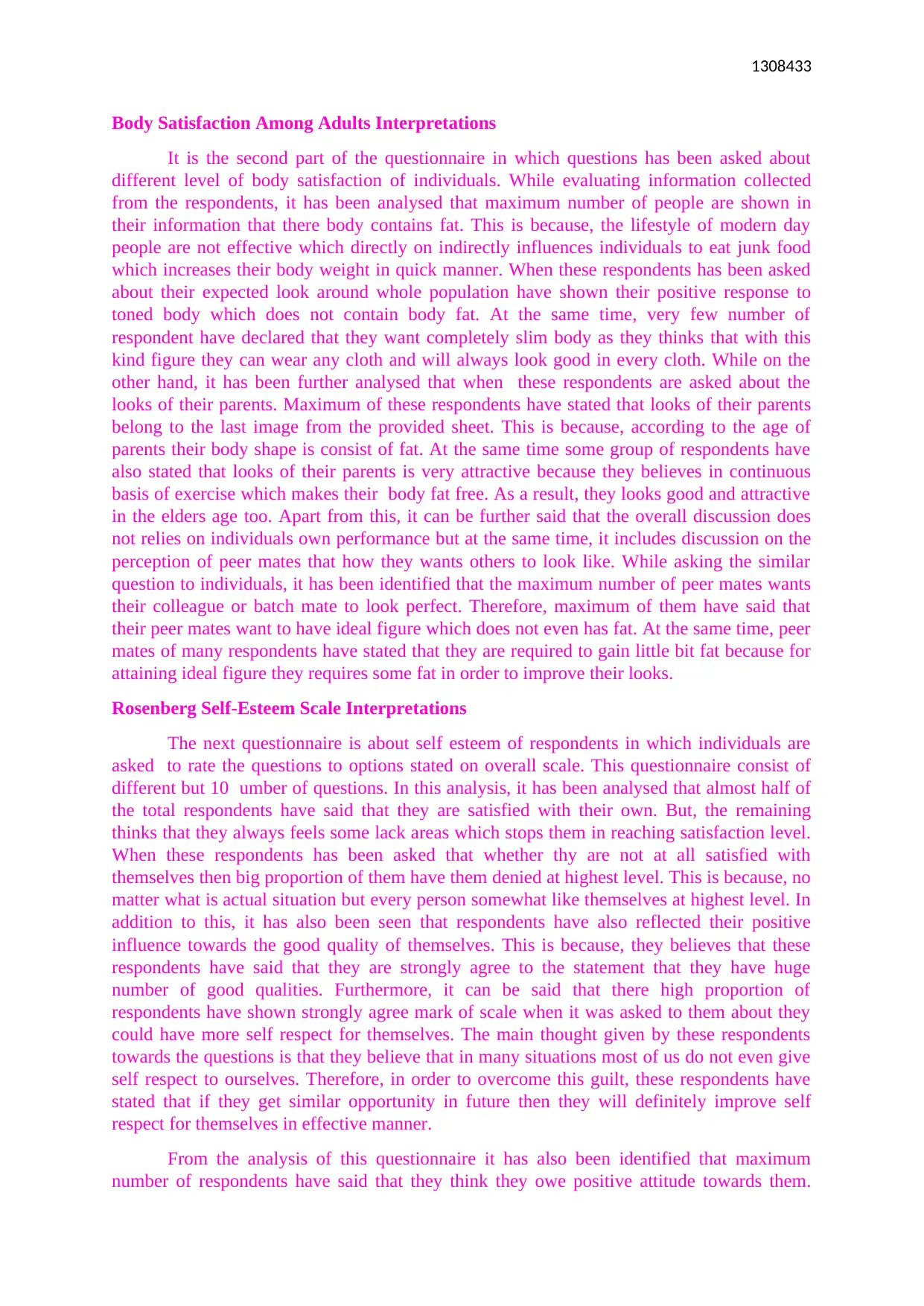
1308433
Body Satisfaction Among Adults Interpretations
It is the second part of the questionnaire in which questions has been asked about
different level of body satisfaction of individuals. While evaluating information collected
from the respondents, it has been analysed that maximum number of people are shown in
their information that there body contains fat. This is because, the lifestyle of modern day
people are not effective which directly on indirectly influences individuals to eat junk food
which increases their body weight in quick manner. When these respondents has been asked
about their expected look around whole population have shown their positive response to
toned body which does not contain body fat. At the same time, very few number of
respondent have declared that they want completely slim body as they thinks that with this
kind figure they can wear any cloth and will always look good in every cloth. While on the
other hand, it has been further analysed that when these respondents are asked about the
looks of their parents. Maximum of these respondents have stated that looks of their parents
belong to the last image from the provided sheet. This is because, according to the age of
parents their body shape is consist of fat. At the same time some group of respondents have
also stated that looks of their parents is very attractive because they believes in continuous
basis of exercise which makes their body fat free. As a result, they looks good and attractive
in the elders age too. Apart from this, it can be further said that the overall discussion does
not relies on individuals own performance but at the same time, it includes discussion on the
perception of peer mates that how they wants others to look like. While asking the similar
question to individuals, it has been identified that the maximum number of peer mates wants
their colleague or batch mate to look perfect. Therefore, maximum of them have said that
their peer mates want to have ideal figure which does not even has fat. At the same time, peer
mates of many respondents have stated that they are required to gain little bit fat because for
attaining ideal figure they requires some fat in order to improve their looks.
Rosenberg Self-Esteem Scale Interpretations
The next questionnaire is about self esteem of respondents in which individuals are
asked to rate the questions to options stated on overall scale. This questionnaire consist of
different but 10 umber of questions. In this analysis, it has been analysed that almost half of
the total respondents have said that they are satisfied with their own. But, the remaining
thinks that they always feels some lack areas which stops them in reaching satisfaction level.
When these respondents has been asked that whether thy are not at all satisfied with
themselves then big proportion of them have them denied at highest level. This is because, no
matter what is actual situation but every person somewhat like themselves at highest level. In
addition to this, it has also been seen that respondents have also reflected their positive
influence towards the good quality of themselves. This is because, they believes that these
respondents have said that they are strongly agree to the statement that they have huge
number of good qualities. Furthermore, it can be said that there high proportion of
respondents have shown strongly agree mark of scale when it was asked to them about they
could have more self respect for themselves. The main thought given by these respondents
towards the questions is that they believe that in many situations most of us do not even give
self respect to ourselves. Therefore, in order to overcome this guilt, these respondents have
stated that if they get similar opportunity in future then they will definitely improve self
respect for themselves in effective manner.
From the analysis of this questionnaire it has also been identified that maximum
number of respondents have said that they think they owe positive attitude towards them.
Body Satisfaction Among Adults Interpretations
It is the second part of the questionnaire in which questions has been asked about
different level of body satisfaction of individuals. While evaluating information collected
from the respondents, it has been analysed that maximum number of people are shown in
their information that there body contains fat. This is because, the lifestyle of modern day
people are not effective which directly on indirectly influences individuals to eat junk food
which increases their body weight in quick manner. When these respondents has been asked
about their expected look around whole population have shown their positive response to
toned body which does not contain body fat. At the same time, very few number of
respondent have declared that they want completely slim body as they thinks that with this
kind figure they can wear any cloth and will always look good in every cloth. While on the
other hand, it has been further analysed that when these respondents are asked about the
looks of their parents. Maximum of these respondents have stated that looks of their parents
belong to the last image from the provided sheet. This is because, according to the age of
parents their body shape is consist of fat. At the same time some group of respondents have
also stated that looks of their parents is very attractive because they believes in continuous
basis of exercise which makes their body fat free. As a result, they looks good and attractive
in the elders age too. Apart from this, it can be further said that the overall discussion does
not relies on individuals own performance but at the same time, it includes discussion on the
perception of peer mates that how they wants others to look like. While asking the similar
question to individuals, it has been identified that the maximum number of peer mates wants
their colleague or batch mate to look perfect. Therefore, maximum of them have said that
their peer mates want to have ideal figure which does not even has fat. At the same time, peer
mates of many respondents have stated that they are required to gain little bit fat because for
attaining ideal figure they requires some fat in order to improve their looks.
Rosenberg Self-Esteem Scale Interpretations
The next questionnaire is about self esteem of respondents in which individuals are
asked to rate the questions to options stated on overall scale. This questionnaire consist of
different but 10 umber of questions. In this analysis, it has been analysed that almost half of
the total respondents have said that they are satisfied with their own. But, the remaining
thinks that they always feels some lack areas which stops them in reaching satisfaction level.
When these respondents has been asked that whether thy are not at all satisfied with
themselves then big proportion of them have them denied at highest level. This is because, no
matter what is actual situation but every person somewhat like themselves at highest level. In
addition to this, it has also been seen that respondents have also reflected their positive
influence towards the good quality of themselves. This is because, they believes that these
respondents have said that they are strongly agree to the statement that they have huge
number of good qualities. Furthermore, it can be said that there high proportion of
respondents have shown strongly agree mark of scale when it was asked to them about they
could have more self respect for themselves. The main thought given by these respondents
towards the questions is that they believe that in many situations most of us do not even give
self respect to ourselves. Therefore, in order to overcome this guilt, these respondents have
stated that if they get similar opportunity in future then they will definitely improve self
respect for themselves in effective manner.
From the analysis of this questionnaire it has also been identified that maximum
number of respondents have said that they think they owe positive attitude towards them.
Secure Best Marks with AI Grader
Need help grading? Try our AI Grader for instant feedback on your assignments.
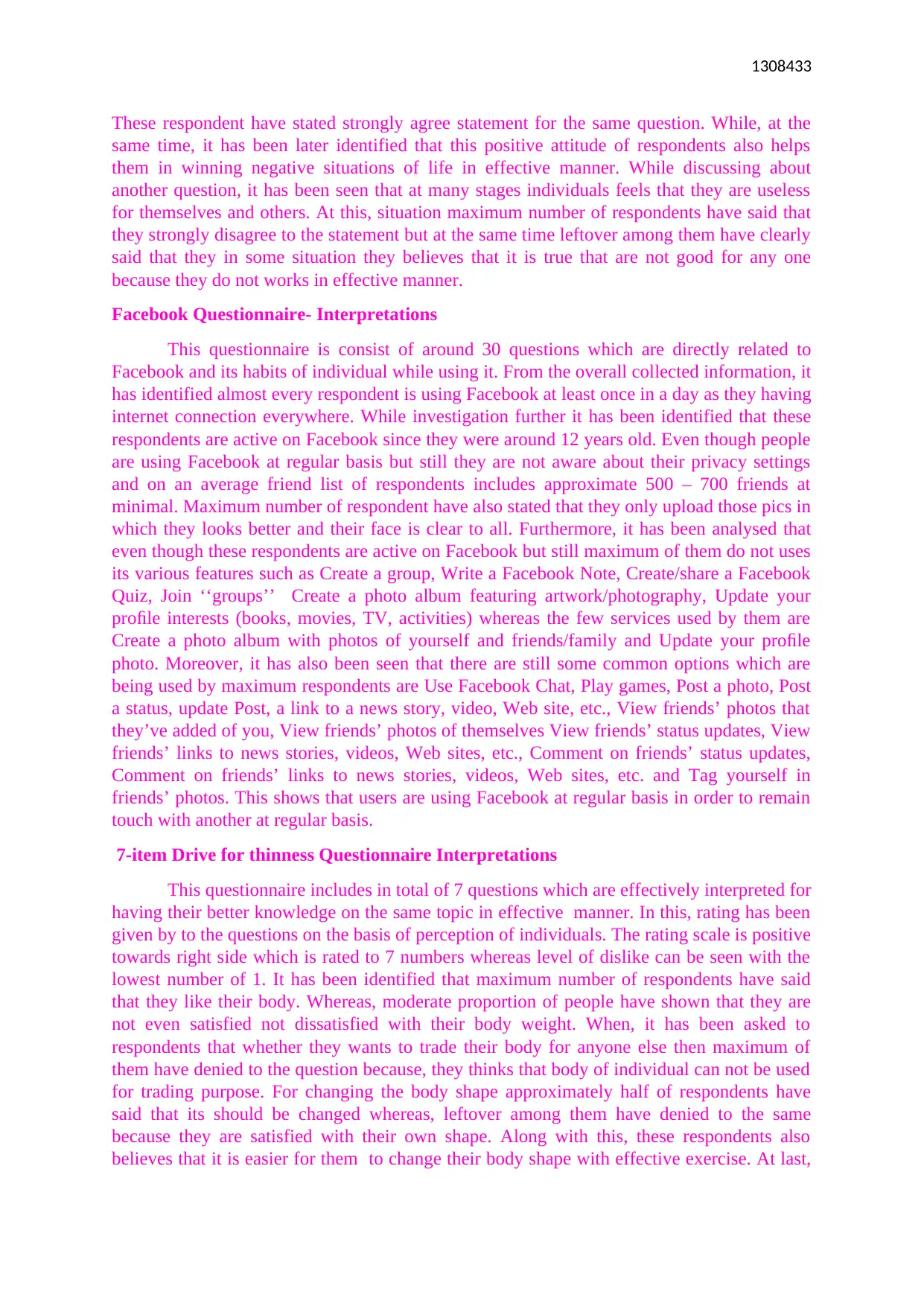
1308433
These respondent have stated strongly agree statement for the same question. While, at the
same time, it has been later identified that this positive attitude of respondents also helps
them in winning negative situations of life in effective manner. While discussing about
another question, it has been seen that at many stages individuals feels that they are useless
for themselves and others. At this, situation maximum number of respondents have said that
they strongly disagree to the statement but at the same time leftover among them have clearly
said that they in some situation they believes that it is true that are not good for any one
because they do not works in effective manner.
Facebook Questionnaire- Interpretations
This questionnaire is consist of around 30 questions which are directly related to
Facebook and its habits of individual while using it. From the overall collected information, it
has identified almost every respondent is using Facebook at least once in a day as they having
internet connection everywhere. While investigation further it has been identified that these
respondents are active on Facebook since they were around 12 years old. Even though people
are using Facebook at regular basis but still they are not aware about their privacy settings
and on an average friend list of respondents includes approximate 500 – 700 friends at
minimal. Maximum number of respondent have also stated that they only upload those pics in
which they looks better and their face is clear to all. Furthermore, it has been analysed that
even though these respondents are active on Facebook but still maximum of them do not uses
its various features such as Create a group, Write a Facebook Note, Create/share a Facebook
Quiz, Join ‘‘groups’’ Create a photo album featuring artwork/photography, Update your
profile interests (books, movies, TV, activities) whereas the few services used by them are
Create a photo album with photos of yourself and friends/family and Update your profile
photo. Moreover, it has also been seen that there are still some common options which are
being used by maximum respondents are Use Facebook Chat, Play games, Post a photo, Post
a status, update Post, a link to a news story, video, Web site, etc., View friends’ photos that
they’ve added of you, View friends’ photos of themselves View friends’ status updates, View
friends’ links to news stories, videos, Web sites, etc., Comment on friends’ status updates,
Comment on friends’ links to news stories, videos, Web sites, etc. and Tag yourself in
friends’ photos. This shows that users are using Facebook at regular basis in order to remain
touch with another at regular basis.
7-item Drive for thinness Questionnaire Interpretations
This questionnaire includes in total of 7 questions which are effectively interpreted for
having their better knowledge on the same topic in effective manner. In this, rating has been
given by to the questions on the basis of perception of individuals. The rating scale is positive
towards right side which is rated to 7 numbers whereas level of dislike can be seen with the
lowest number of 1. It has been identified that maximum number of respondents have said
that they like their body. Whereas, moderate proportion of people have shown that they are
not even satisfied not dissatisfied with their body weight. When, it has been asked to
respondents that whether they wants to trade their body for anyone else then maximum of
them have denied to the question because, they thinks that body of individual can not be used
for trading purpose. For changing the body shape approximately half of respondents have
said that its should be changed whereas, leftover among them have denied to the same
because they are satisfied with their own shape. Along with this, these respondents also
believes that it is easier for them to change their body shape with effective exercise. At last,
These respondent have stated strongly agree statement for the same question. While, at the
same time, it has been later identified that this positive attitude of respondents also helps
them in winning negative situations of life in effective manner. While discussing about
another question, it has been seen that at many stages individuals feels that they are useless
for themselves and others. At this, situation maximum number of respondents have said that
they strongly disagree to the statement but at the same time leftover among them have clearly
said that they in some situation they believes that it is true that are not good for any one
because they do not works in effective manner.
Facebook Questionnaire- Interpretations
This questionnaire is consist of around 30 questions which are directly related to
Facebook and its habits of individual while using it. From the overall collected information, it
has identified almost every respondent is using Facebook at least once in a day as they having
internet connection everywhere. While investigation further it has been identified that these
respondents are active on Facebook since they were around 12 years old. Even though people
are using Facebook at regular basis but still they are not aware about their privacy settings
and on an average friend list of respondents includes approximate 500 – 700 friends at
minimal. Maximum number of respondent have also stated that they only upload those pics in
which they looks better and their face is clear to all. Furthermore, it has been analysed that
even though these respondents are active on Facebook but still maximum of them do not uses
its various features such as Create a group, Write a Facebook Note, Create/share a Facebook
Quiz, Join ‘‘groups’’ Create a photo album featuring artwork/photography, Update your
profile interests (books, movies, TV, activities) whereas the few services used by them are
Create a photo album with photos of yourself and friends/family and Update your profile
photo. Moreover, it has also been seen that there are still some common options which are
being used by maximum respondents are Use Facebook Chat, Play games, Post a photo, Post
a status, update Post, a link to a news story, video, Web site, etc., View friends’ photos that
they’ve added of you, View friends’ photos of themselves View friends’ status updates, View
friends’ links to news stories, videos, Web sites, etc., Comment on friends’ status updates,
Comment on friends’ links to news stories, videos, Web sites, etc. and Tag yourself in
friends’ photos. This shows that users are using Facebook at regular basis in order to remain
touch with another at regular basis.
7-item Drive for thinness Questionnaire Interpretations
This questionnaire includes in total of 7 questions which are effectively interpreted for
having their better knowledge on the same topic in effective manner. In this, rating has been
given by to the questions on the basis of perception of individuals. The rating scale is positive
towards right side which is rated to 7 numbers whereas level of dislike can be seen with the
lowest number of 1. It has been identified that maximum number of respondents have said
that they like their body. Whereas, moderate proportion of people have shown that they are
not even satisfied not dissatisfied with their body weight. When, it has been asked to
respondents that whether they wants to trade their body for anyone else then maximum of
them have denied to the question because, they thinks that body of individual can not be used
for trading purpose. For changing the body shape approximately half of respondents have
said that its should be changed whereas, leftover among them have denied to the same
because they are satisfied with their own shape. Along with this, these respondents also
believes that it is easier for them to change their body shape with effective exercise. At last,
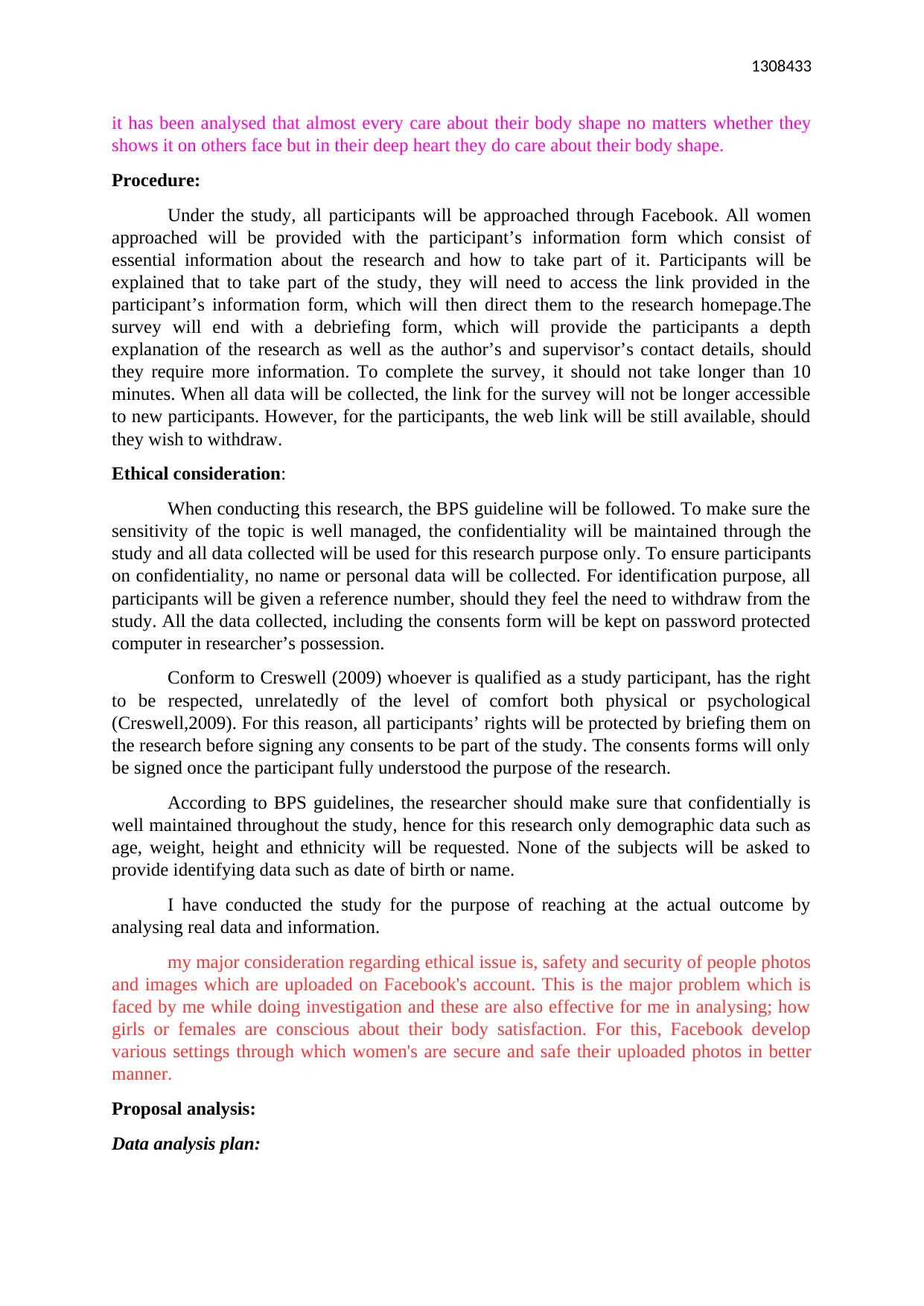
1308433
it has been analysed that almost every care about their body shape no matters whether they
shows it on others face but in their deep heart they do care about their body shape.
Procedure:
Under the study, all participants will be approached through Facebook. All women
approached will be provided with the participant’s information form which consist of
essential information about the research and how to take part of it. Participants will be
explained that to take part of the study, they will need to access the link provided in the
participant’s information form, which will then direct them to the research homepage.The
survey will end with a debriefing form, which will provide the participants a depth
explanation of the research as well as the author’s and supervisor’s contact details, should
they require more information. To complete the survey, it should not take longer than 10
minutes. When all data will be collected, the link for the survey will not be longer accessible
to new participants. However, for the participants, the web link will be still available, should
they wish to withdraw.
Ethical consideration:
When conducting this research, the BPS guideline will be followed. To make sure the
sensitivity of the topic is well managed, the confidentiality will be maintained through the
study and all data collected will be used for this research purpose only. To ensure participants
on confidentiality, no name or personal data will be collected. For identification purpose, all
participants will be given a reference number, should they feel the need to withdraw from the
study. All the data collected, including the consents form will be kept on password protected
computer in researcher’s possession.
Conform to Creswell (2009) whoever is qualified as a study participant, has the right
to be respected, unrelatedly of the level of comfort both physical or psychological
(Creswell,2009). For this reason, all participants’ rights will be protected by briefing them on
the research before signing any consents to be part of the study. The consents forms will only
be signed once the participant fully understood the purpose of the research.
According to BPS guidelines, the researcher should make sure that confidentially is
well maintained throughout the study, hence for this research only demographic data such as
age, weight, height and ethnicity will be requested. None of the subjects will be asked to
provide identifying data such as date of birth or name.
I have conducted the study for the purpose of reaching at the actual outcome by
analysing real data and information.
my major consideration regarding ethical issue is, safety and security of people photos
and images which are uploaded on Facebook's account. This is the major problem which is
faced by me while doing investigation and these are also effective for me in analysing; how
girls or females are conscious about their body satisfaction. For this, Facebook develop
various settings through which women's are secure and safe their uploaded photos in better
manner.
Proposal analysis:
Data analysis plan:
it has been analysed that almost every care about their body shape no matters whether they
shows it on others face but in their deep heart they do care about their body shape.
Procedure:
Under the study, all participants will be approached through Facebook. All women
approached will be provided with the participant’s information form which consist of
essential information about the research and how to take part of it. Participants will be
explained that to take part of the study, they will need to access the link provided in the
participant’s information form, which will then direct them to the research homepage.The
survey will end with a debriefing form, which will provide the participants a depth
explanation of the research as well as the author’s and supervisor’s contact details, should
they require more information. To complete the survey, it should not take longer than 10
minutes. When all data will be collected, the link for the survey will not be longer accessible
to new participants. However, for the participants, the web link will be still available, should
they wish to withdraw.
Ethical consideration:
When conducting this research, the BPS guideline will be followed. To make sure the
sensitivity of the topic is well managed, the confidentiality will be maintained through the
study and all data collected will be used for this research purpose only. To ensure participants
on confidentiality, no name or personal data will be collected. For identification purpose, all
participants will be given a reference number, should they feel the need to withdraw from the
study. All the data collected, including the consents form will be kept on password protected
computer in researcher’s possession.
Conform to Creswell (2009) whoever is qualified as a study participant, has the right
to be respected, unrelatedly of the level of comfort both physical or psychological
(Creswell,2009). For this reason, all participants’ rights will be protected by briefing them on
the research before signing any consents to be part of the study. The consents forms will only
be signed once the participant fully understood the purpose of the research.
According to BPS guidelines, the researcher should make sure that confidentially is
well maintained throughout the study, hence for this research only demographic data such as
age, weight, height and ethnicity will be requested. None of the subjects will be asked to
provide identifying data such as date of birth or name.
I have conducted the study for the purpose of reaching at the actual outcome by
analysing real data and information.
my major consideration regarding ethical issue is, safety and security of people photos
and images which are uploaded on Facebook's account. This is the major problem which is
faced by me while doing investigation and these are also effective for me in analysing; how
girls or females are conscious about their body satisfaction. For this, Facebook develop
various settings through which women's are secure and safe their uploaded photos in better
manner.
Proposal analysis:
Data analysis plan:
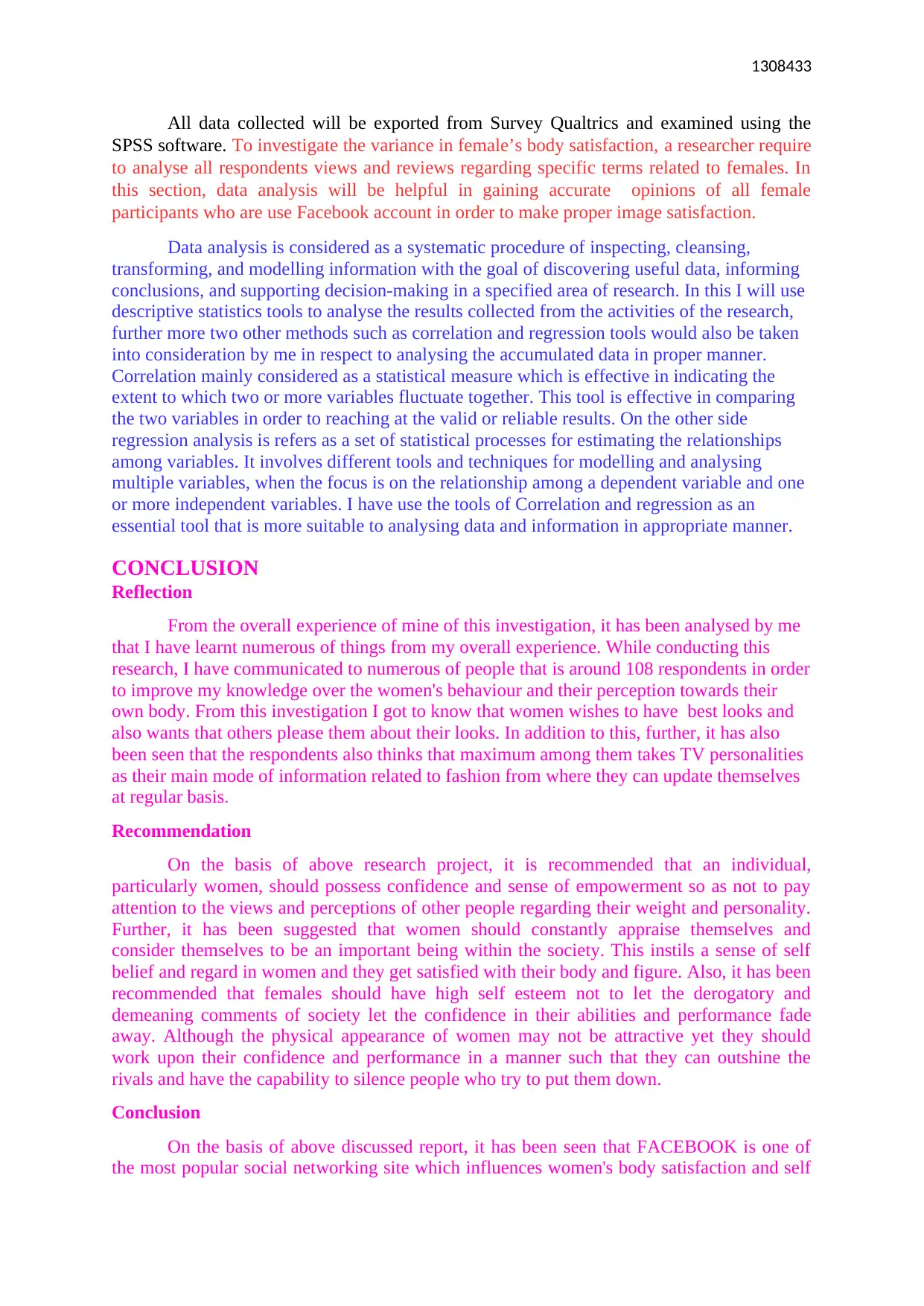
1308433
All data collected will be exported from Survey Qualtrics and examined using the
SPSS software. To investigate the variance in female’s body satisfaction, a researcher require
to analyse all respondents views and reviews regarding specific terms related to females. In
this section, data analysis will be helpful in gaining accurate opinions of all female
participants who are use Facebook account in order to make proper image satisfaction.
Data analysis is considered as a systematic procedure of inspecting, cleansing,
transforming, and modelling information with the goal of discovering useful data, informing
conclusions, and supporting decision-making in a specified area of research. In this I will use
descriptive statistics tools to analyse the results collected from the activities of the research,
further more two other methods such as correlation and regression tools would also be taken
into consideration by me in respect to analysing the accumulated data in proper manner.
Correlation mainly considered as a statistical measure which is effective in indicating the
extent to which two or more variables fluctuate together. This tool is effective in comparing
the two variables in order to reaching at the valid or reliable results. On the other side
regression analysis is refers as a set of statistical processes for estimating the relationships
among variables. It involves different tools and techniques for modelling and analysing
multiple variables, when the focus is on the relationship among a dependent variable and one
or more independent variables. I have use the tools of Correlation and regression as an
essential tool that is more suitable to analysing data and information in appropriate manner.
CONCLUSION
Reflection
From the overall experience of mine of this investigation, it has been analysed by me
that I have learnt numerous of things from my overall experience. While conducting this
research, I have communicated to numerous of people that is around 108 respondents in order
to improve my knowledge over the women's behaviour and their perception towards their
own body. From this investigation I got to know that women wishes to have best looks and
also wants that others please them about their looks. In addition to this, further, it has also
been seen that the respondents also thinks that maximum among them takes TV personalities
as their main mode of information related to fashion from where they can update themselves
at regular basis.
Recommendation
On the basis of above research project, it is recommended that an individual,
particularly women, should possess confidence and sense of empowerment so as not to pay
attention to the views and perceptions of other people regarding their weight and personality.
Further, it has been suggested that women should constantly appraise themselves and
consider themselves to be an important being within the society. This instils a sense of self
belief and regard in women and they get satisfied with their body and figure. Also, it has been
recommended that females should have high self esteem not to let the derogatory and
demeaning comments of society let the confidence in their abilities and performance fade
away. Although the physical appearance of women may not be attractive yet they should
work upon their confidence and performance in a manner such that they can outshine the
rivals and have the capability to silence people who try to put them down.
Conclusion
On the basis of above discussed report, it has been seen that FACEBOOK is one of
the most popular social networking site which influences women's body satisfaction and self
All data collected will be exported from Survey Qualtrics and examined using the
SPSS software. To investigate the variance in female’s body satisfaction, a researcher require
to analyse all respondents views and reviews regarding specific terms related to females. In
this section, data analysis will be helpful in gaining accurate opinions of all female
participants who are use Facebook account in order to make proper image satisfaction.
Data analysis is considered as a systematic procedure of inspecting, cleansing,
transforming, and modelling information with the goal of discovering useful data, informing
conclusions, and supporting decision-making in a specified area of research. In this I will use
descriptive statistics tools to analyse the results collected from the activities of the research,
further more two other methods such as correlation and regression tools would also be taken
into consideration by me in respect to analysing the accumulated data in proper manner.
Correlation mainly considered as a statistical measure which is effective in indicating the
extent to which two or more variables fluctuate together. This tool is effective in comparing
the two variables in order to reaching at the valid or reliable results. On the other side
regression analysis is refers as a set of statistical processes for estimating the relationships
among variables. It involves different tools and techniques for modelling and analysing
multiple variables, when the focus is on the relationship among a dependent variable and one
or more independent variables. I have use the tools of Correlation and regression as an
essential tool that is more suitable to analysing data and information in appropriate manner.
CONCLUSION
Reflection
From the overall experience of mine of this investigation, it has been analysed by me
that I have learnt numerous of things from my overall experience. While conducting this
research, I have communicated to numerous of people that is around 108 respondents in order
to improve my knowledge over the women's behaviour and their perception towards their
own body. From this investigation I got to know that women wishes to have best looks and
also wants that others please them about their looks. In addition to this, further, it has also
been seen that the respondents also thinks that maximum among them takes TV personalities
as their main mode of information related to fashion from where they can update themselves
at regular basis.
Recommendation
On the basis of above research project, it is recommended that an individual,
particularly women, should possess confidence and sense of empowerment so as not to pay
attention to the views and perceptions of other people regarding their weight and personality.
Further, it has been suggested that women should constantly appraise themselves and
consider themselves to be an important being within the society. This instils a sense of self
belief and regard in women and they get satisfied with their body and figure. Also, it has been
recommended that females should have high self esteem not to let the derogatory and
demeaning comments of society let the confidence in their abilities and performance fade
away. Although the physical appearance of women may not be attractive yet they should
work upon their confidence and performance in a manner such that they can outshine the
rivals and have the capability to silence people who try to put them down.
Conclusion
On the basis of above discussed report, it has been seen that FACEBOOK is one of
the most popular social networking site which influences women's body satisfaction and self
Paraphrase This Document
Need a fresh take? Get an instant paraphrase of this document with our AI Paraphraser

1308433
esteem. It has been seen that women are highly conscious about their looks and wishes to
improve it effectively with the help of TV shows and other medium that contribute in its self-
improvement in effective manner. In order to improve their knowledge, investigator have
used numerous questionnaire so that maximum info9rmation can be gained by them from the
chosen respondents in effective manner.
esteem. It has been seen that women are highly conscious about their looks and wishes to
improve it effectively with the help of TV shows and other medium that contribute in its self-
improvement in effective manner. In order to improve their knowledge, investigator have
used numerous questionnaire so that maximum info9rmation can be gained by them from the
chosen respondents in effective manner.
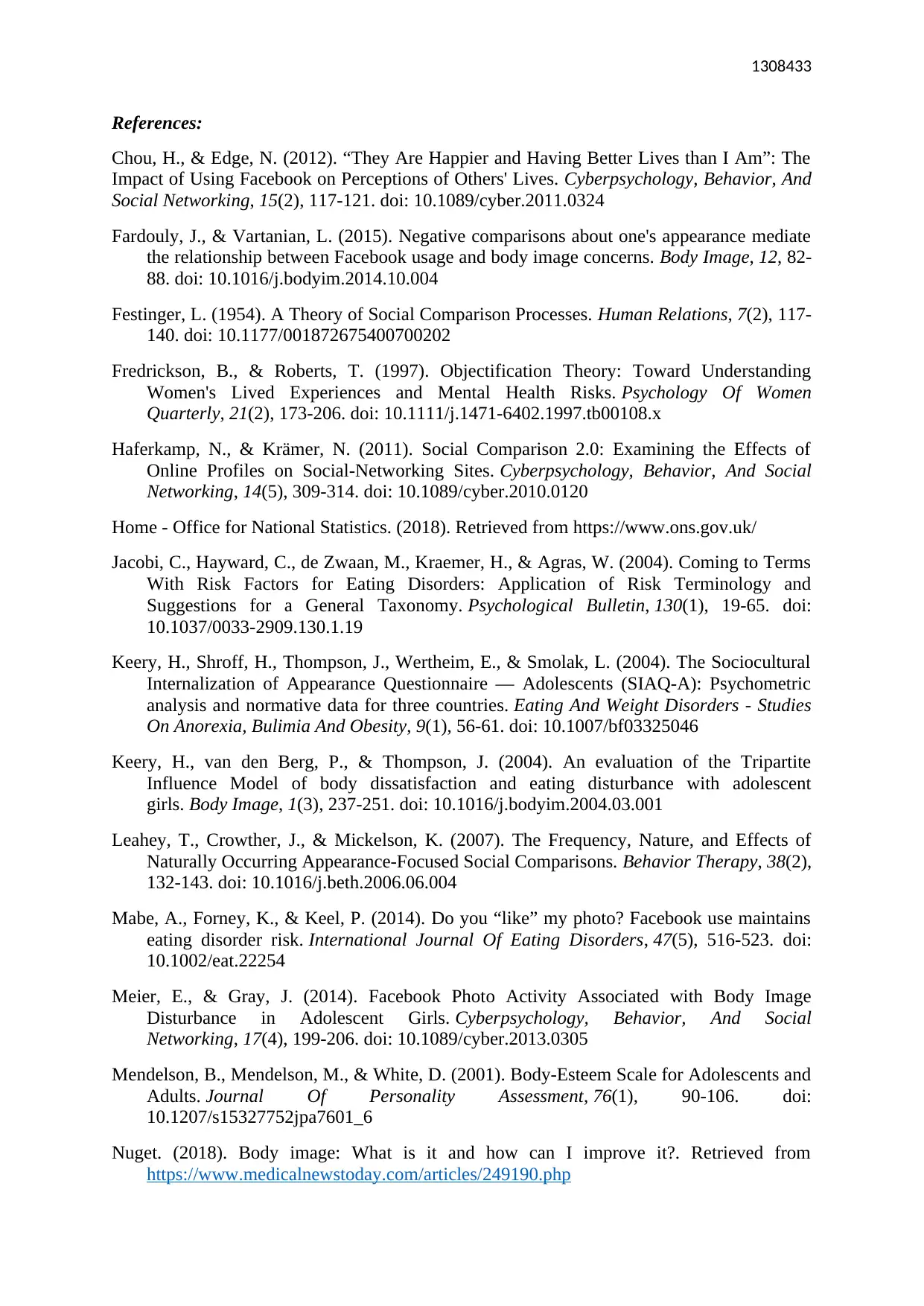
1308433
References:
Chou, H., & Edge, N. (2012). “They Are Happier and Having Better Lives than I Am”: The
Impact of Using Facebook on Perceptions of Others' Lives. Cyberpsychology, Behavior, And
Social Networking, 15(2), 117-121. doi: 10.1089/cyber.2011.0324
Fardouly, J., & Vartanian, L. (2015). Negative comparisons about one's appearance mediate
the relationship between Facebook usage and body image concerns. Body Image, 12, 82-
88. doi: 10.1016/j.bodyim.2014.10.004
Festinger, L. (1954). A Theory of Social Comparison Processes. Human Relations, 7(2), 117-
140. doi: 10.1177/001872675400700202
Fredrickson, B., & Roberts, T. (1997). Objectification Theory: Toward Understanding
Women's Lived Experiences and Mental Health Risks. Psychology Of Women
Quarterly, 21(2), 173-206. doi: 10.1111/j.1471-6402.1997.tb00108.x
Haferkamp, N., & Krämer, N. (2011). Social Comparison 2.0: Examining the Effects of
Online Profiles on Social-Networking Sites. Cyberpsychology, Behavior, And Social
Networking, 14(5), 309-314. doi: 10.1089/cyber.2010.0120
Home - Office for National Statistics. (2018). Retrieved from https://www.ons.gov.uk/
Jacobi, C., Hayward, C., de Zwaan, M., Kraemer, H., & Agras, W. (2004). Coming to Terms
With Risk Factors for Eating Disorders: Application of Risk Terminology and
Suggestions for a General Taxonomy. Psychological Bulletin, 130(1), 19-65. doi:
10.1037/0033-2909.130.1.19
Keery, H., Shroff, H., Thompson, J., Wertheim, E., & Smolak, L. (2004). The Sociocultural
Internalization of Appearance Questionnaire — Adolescents (SIAQ-A): Psychometric
analysis and normative data for three countries. Eating And Weight Disorders - Studies
On Anorexia, Bulimia And Obesity, 9(1), 56-61. doi: 10.1007/bf03325046
Keery, H., van den Berg, P., & Thompson, J. (2004). An evaluation of the Tripartite
Influence Model of body dissatisfaction and eating disturbance with adolescent
girls. Body Image, 1(3), 237-251. doi: 10.1016/j.bodyim.2004.03.001
Leahey, T., Crowther, J., & Mickelson, K. (2007). The Frequency, Nature, and Effects of
Naturally Occurring Appearance-Focused Social Comparisons. Behavior Therapy, 38(2),
132-143. doi: 10.1016/j.beth.2006.06.004
Mabe, A., Forney, K., & Keel, P. (2014). Do you “like” my photo? Facebook use maintains
eating disorder risk. International Journal Of Eating Disorders, 47(5), 516-523. doi:
10.1002/eat.22254
Meier, E., & Gray, J. (2014). Facebook Photo Activity Associated with Body Image
Disturbance in Adolescent Girls. Cyberpsychology, Behavior, And Social
Networking, 17(4), 199-206. doi: 10.1089/cyber.2013.0305
Mendelson, B., Mendelson, M., & White, D. (2001). Body-Esteem Scale for Adolescents and
Adults. Journal Of Personality Assessment, 76(1), 90-106. doi:
10.1207/s15327752jpa7601_6
Nuget. (2018). Body image: What is it and how can I improve it?. Retrieved from
https://www.medicalnewstoday.com/articles/249190.php
References:
Chou, H., & Edge, N. (2012). “They Are Happier and Having Better Lives than I Am”: The
Impact of Using Facebook on Perceptions of Others' Lives. Cyberpsychology, Behavior, And
Social Networking, 15(2), 117-121. doi: 10.1089/cyber.2011.0324
Fardouly, J., & Vartanian, L. (2015). Negative comparisons about one's appearance mediate
the relationship between Facebook usage and body image concerns. Body Image, 12, 82-
88. doi: 10.1016/j.bodyim.2014.10.004
Festinger, L. (1954). A Theory of Social Comparison Processes. Human Relations, 7(2), 117-
140. doi: 10.1177/001872675400700202
Fredrickson, B., & Roberts, T. (1997). Objectification Theory: Toward Understanding
Women's Lived Experiences and Mental Health Risks. Psychology Of Women
Quarterly, 21(2), 173-206. doi: 10.1111/j.1471-6402.1997.tb00108.x
Haferkamp, N., & Krämer, N. (2011). Social Comparison 2.0: Examining the Effects of
Online Profiles on Social-Networking Sites. Cyberpsychology, Behavior, And Social
Networking, 14(5), 309-314. doi: 10.1089/cyber.2010.0120
Home - Office for National Statistics. (2018). Retrieved from https://www.ons.gov.uk/
Jacobi, C., Hayward, C., de Zwaan, M., Kraemer, H., & Agras, W. (2004). Coming to Terms
With Risk Factors for Eating Disorders: Application of Risk Terminology and
Suggestions for a General Taxonomy. Psychological Bulletin, 130(1), 19-65. doi:
10.1037/0033-2909.130.1.19
Keery, H., Shroff, H., Thompson, J., Wertheim, E., & Smolak, L. (2004). The Sociocultural
Internalization of Appearance Questionnaire — Adolescents (SIAQ-A): Psychometric
analysis and normative data for three countries. Eating And Weight Disorders - Studies
On Anorexia, Bulimia And Obesity, 9(1), 56-61. doi: 10.1007/bf03325046
Keery, H., van den Berg, P., & Thompson, J. (2004). An evaluation of the Tripartite
Influence Model of body dissatisfaction and eating disturbance with adolescent
girls. Body Image, 1(3), 237-251. doi: 10.1016/j.bodyim.2004.03.001
Leahey, T., Crowther, J., & Mickelson, K. (2007). The Frequency, Nature, and Effects of
Naturally Occurring Appearance-Focused Social Comparisons. Behavior Therapy, 38(2),
132-143. doi: 10.1016/j.beth.2006.06.004
Mabe, A., Forney, K., & Keel, P. (2014). Do you “like” my photo? Facebook use maintains
eating disorder risk. International Journal Of Eating Disorders, 47(5), 516-523. doi:
10.1002/eat.22254
Meier, E., & Gray, J. (2014). Facebook Photo Activity Associated with Body Image
Disturbance in Adolescent Girls. Cyberpsychology, Behavior, And Social
Networking, 17(4), 199-206. doi: 10.1089/cyber.2013.0305
Mendelson, B., Mendelson, M., & White, D. (2001). Body-Esteem Scale for Adolescents and
Adults. Journal Of Personality Assessment, 76(1), 90-106. doi:
10.1207/s15327752jpa7601_6
Nuget. (2018). Body image: What is it and how can I improve it?. Retrieved from
https://www.medicalnewstoday.com/articles/249190.php
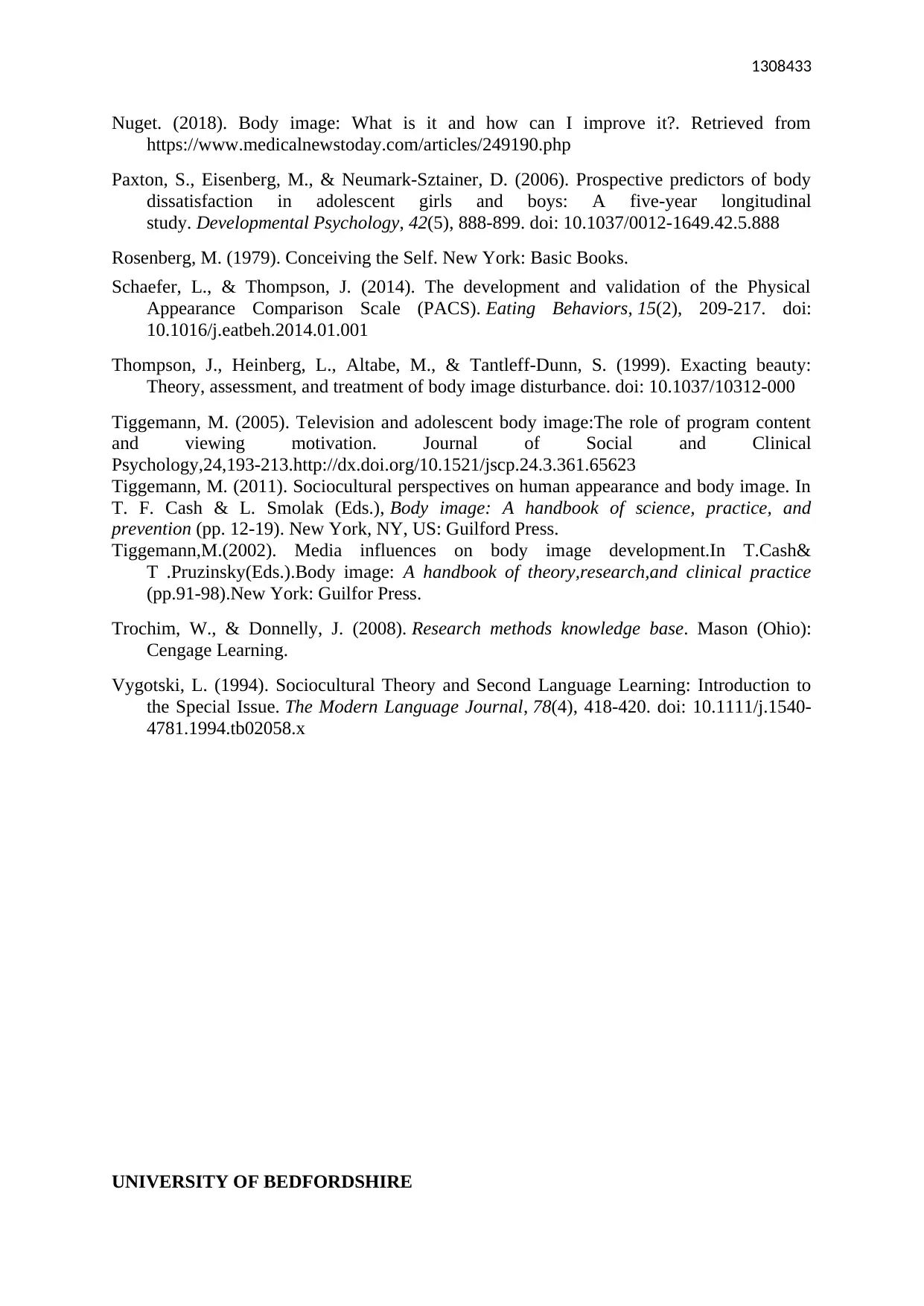
1308433
Nuget. (2018). Body image: What is it and how can I improve it?. Retrieved from
https://www.medicalnewstoday.com/articles/249190.php
Paxton, S., Eisenberg, M., & Neumark-Sztainer, D. (2006). Prospective predictors of body
dissatisfaction in adolescent girls and boys: A five-year longitudinal
study. Developmental Psychology, 42(5), 888-899. doi: 10.1037/0012-1649.42.5.888
Rosenberg, M. (1979). Conceiving the Self. New York: Basic Books.
Schaefer, L., & Thompson, J. (2014). The development and validation of the Physical
Appearance Comparison Scale (PACS). Eating Behaviors, 15(2), 209-217. doi:
10.1016/j.eatbeh.2014.01.001
Thompson, J., Heinberg, L., Altabe, M., & Tantleff-Dunn, S. (1999). Exacting beauty:
Theory, assessment, and treatment of body image disturbance. doi: 10.1037/10312-000
Tiggemann, M. (2005). Television and adolescent body image:The role of program content
and viewing motivation. Journal of Social and Clinical
Psychology,24,193-213.http://dx.doi.org/10.1521/jscp.24.3.361.65623
Tiggemann, M. (2011). Sociocultural perspectives on human appearance and body image. In
T. F. Cash & L. Smolak (Eds.), Body image: A handbook of science, practice, and
prevention (pp. 12-19). New York, NY, US: Guilford Press.
Tiggemann,M.(2002). Media influences on body image development.In T.Cash&
T .Pruzinsky(Eds.).Body image: A handbook of theory,research,and clinical practice
(pp.91-98).New York: Guilfor Press.
Trochim, W., & Donnelly, J. (2008). Research methods knowledge base. Mason (Ohio):
Cengage Learning.
Vygotski, L. (1994). Sociocultural Theory and Second Language Learning: Introduction to
the Special Issue. The Modern Language Journal, 78(4), 418-420. doi: 10.1111/j.1540-
4781.1994.tb02058.x
UNIVERSITY OF BEDFORDSHIRE
Nuget. (2018). Body image: What is it and how can I improve it?. Retrieved from
https://www.medicalnewstoday.com/articles/249190.php
Paxton, S., Eisenberg, M., & Neumark-Sztainer, D. (2006). Prospective predictors of body
dissatisfaction in adolescent girls and boys: A five-year longitudinal
study. Developmental Psychology, 42(5), 888-899. doi: 10.1037/0012-1649.42.5.888
Rosenberg, M. (1979). Conceiving the Self. New York: Basic Books.
Schaefer, L., & Thompson, J. (2014). The development and validation of the Physical
Appearance Comparison Scale (PACS). Eating Behaviors, 15(2), 209-217. doi:
10.1016/j.eatbeh.2014.01.001
Thompson, J., Heinberg, L., Altabe, M., & Tantleff-Dunn, S. (1999). Exacting beauty:
Theory, assessment, and treatment of body image disturbance. doi: 10.1037/10312-000
Tiggemann, M. (2005). Television and adolescent body image:The role of program content
and viewing motivation. Journal of Social and Clinical
Psychology,24,193-213.http://dx.doi.org/10.1521/jscp.24.3.361.65623
Tiggemann, M. (2011). Sociocultural perspectives on human appearance and body image. In
T. F. Cash & L. Smolak (Eds.), Body image: A handbook of science, practice, and
prevention (pp. 12-19). New York, NY, US: Guilford Press.
Tiggemann,M.(2002). Media influences on body image development.In T.Cash&
T .Pruzinsky(Eds.).Body image: A handbook of theory,research,and clinical practice
(pp.91-98).New York: Guilfor Press.
Trochim, W., & Donnelly, J. (2008). Research methods knowledge base. Mason (Ohio):
Cengage Learning.
Vygotski, L. (1994). Sociocultural Theory and Second Language Learning: Introduction to
the Special Issue. The Modern Language Journal, 78(4), 418-420. doi: 10.1111/j.1540-
4781.1994.tb02058.x
UNIVERSITY OF BEDFORDSHIRE
Secure Best Marks with AI Grader
Need help grading? Try our AI Grader for instant feedback on your assignments.
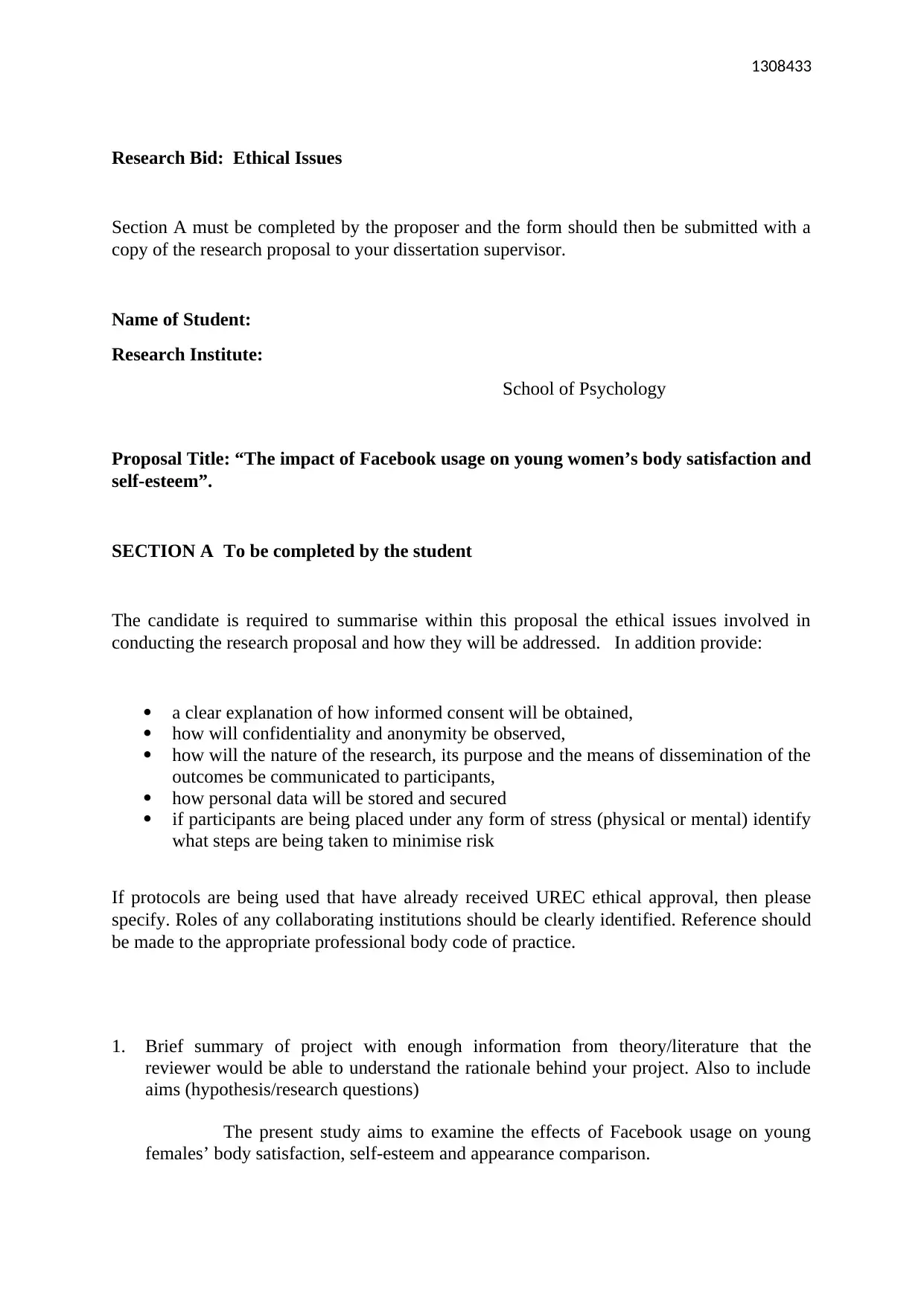
1308433
Research Bid: Ethical Issues
Section A must be completed by the proposer and the form should then be submitted with a
copy of the research proposal to your dissertation supervisor.
Name of Student:
Research Institute:
School of Psychology
Proposal Title: “The impact of Facebook usage on young women’s body satisfaction and
self-esteem”.
SECTION A To be completed by the student
The candidate is required to summarise within this proposal the ethical issues involved in
conducting the research proposal and how they will be addressed. In addition provide:
a clear explanation of how informed consent will be obtained,
how will confidentiality and anonymity be observed,
how will the nature of the research, its purpose and the means of dissemination of the
outcomes be communicated to participants,
how personal data will be stored and secured
if participants are being placed under any form of stress (physical or mental) identify
what steps are being taken to minimise risk
If protocols are being used that have already received UREC ethical approval, then please
specify. Roles of any collaborating institutions should be clearly identified. Reference should
be made to the appropriate professional body code of practice.
1. Brief summary of project with enough information from theory/literature that the
reviewer would be able to understand the rationale behind your project. Also to include
aims (hypothesis/research questions)
The present study aims to examine the effects of Facebook usage on young
females’ body satisfaction, self-esteem and appearance comparison.
Research Bid: Ethical Issues
Section A must be completed by the proposer and the form should then be submitted with a
copy of the research proposal to your dissertation supervisor.
Name of Student:
Research Institute:
School of Psychology
Proposal Title: “The impact of Facebook usage on young women’s body satisfaction and
self-esteem”.
SECTION A To be completed by the student
The candidate is required to summarise within this proposal the ethical issues involved in
conducting the research proposal and how they will be addressed. In addition provide:
a clear explanation of how informed consent will be obtained,
how will confidentiality and anonymity be observed,
how will the nature of the research, its purpose and the means of dissemination of the
outcomes be communicated to participants,
how personal data will be stored and secured
if participants are being placed under any form of stress (physical or mental) identify
what steps are being taken to minimise risk
If protocols are being used that have already received UREC ethical approval, then please
specify. Roles of any collaborating institutions should be clearly identified. Reference should
be made to the appropriate professional body code of practice.
1. Brief summary of project with enough information from theory/literature that the
reviewer would be able to understand the rationale behind your project. Also to include
aims (hypothesis/research questions)
The present study aims to examine the effects of Facebook usage on young
females’ body satisfaction, self-esteem and appearance comparison.
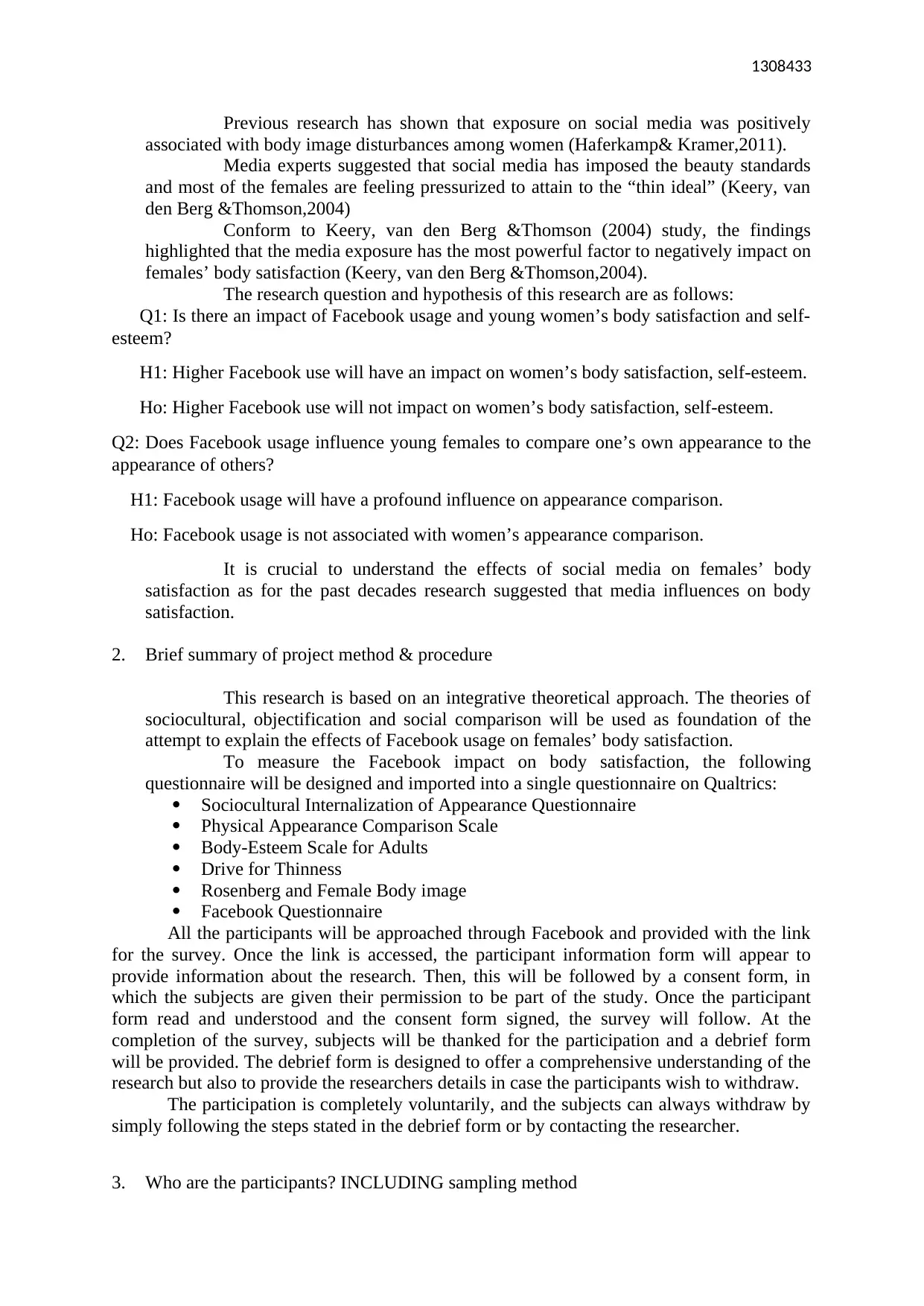
1308433
Previous research has shown that exposure on social media was positively
associated with body image disturbances among women (Haferkamp& Kramer,2011).
Media experts suggested that social media has imposed the beauty standards
and most of the females are feeling pressurized to attain to the “thin ideal” (Keery, van
den Berg &Thomson,2004)
Conform to Keery, van den Berg &Thomson (2004) study, the findings
highlighted that the media exposure has the most powerful factor to negatively impact on
females’ body satisfaction (Keery, van den Berg &Thomson,2004).
The research question and hypothesis of this research are as follows:
Q1: Is there an impact of Facebook usage and young women’s body satisfaction and self-
esteem?
H1: Higher Facebook use will have an impact on women’s body satisfaction, self-esteem.
Ho: Higher Facebook use will not impact on women’s body satisfaction, self-esteem.
Q2: Does Facebook usage influence young females to compare one’s own appearance to the
appearance of others?
H1: Facebook usage will have a profound influence on appearance comparison.
Ho: Facebook usage is not associated with women’s appearance comparison.
It is crucial to understand the effects of social media on females’ body
satisfaction as for the past decades research suggested that media influences on body
satisfaction.
2. Brief summary of project method & procedure
This research is based on an integrative theoretical approach. The theories of
sociocultural, objectification and social comparison will be used as foundation of the
attempt to explain the effects of Facebook usage on females’ body satisfaction.
To measure the Facebook impact on body satisfaction, the following
questionnaire will be designed and imported into a single questionnaire on Qualtrics:
Sociocultural Internalization of Appearance Questionnaire
Physical Appearance Comparison Scale
Body-Esteem Scale for Adults
Drive for Thinness
Rosenberg and Female Body image
Facebook Questionnaire
All the participants will be approached through Facebook and provided with the link
for the survey. Once the link is accessed, the participant information form will appear to
provide information about the research. Then, this will be followed by a consent form, in
which the subjects are given their permission to be part of the study. Once the participant
form read and understood and the consent form signed, the survey will follow. At the
completion of the survey, subjects will be thanked for the participation and a debrief form
will be provided. The debrief form is designed to offer a comprehensive understanding of the
research but also to provide the researchers details in case the participants wish to withdraw.
The participation is completely voluntarily, and the subjects can always withdraw by
simply following the steps stated in the debrief form or by contacting the researcher.
3. Who are the participants? INCLUDING sampling method
Previous research has shown that exposure on social media was positively
associated with body image disturbances among women (Haferkamp& Kramer,2011).
Media experts suggested that social media has imposed the beauty standards
and most of the females are feeling pressurized to attain to the “thin ideal” (Keery, van
den Berg &Thomson,2004)
Conform to Keery, van den Berg &Thomson (2004) study, the findings
highlighted that the media exposure has the most powerful factor to negatively impact on
females’ body satisfaction (Keery, van den Berg &Thomson,2004).
The research question and hypothesis of this research are as follows:
Q1: Is there an impact of Facebook usage and young women’s body satisfaction and self-
esteem?
H1: Higher Facebook use will have an impact on women’s body satisfaction, self-esteem.
Ho: Higher Facebook use will not impact on women’s body satisfaction, self-esteem.
Q2: Does Facebook usage influence young females to compare one’s own appearance to the
appearance of others?
H1: Facebook usage will have a profound influence on appearance comparison.
Ho: Facebook usage is not associated with women’s appearance comparison.
It is crucial to understand the effects of social media on females’ body
satisfaction as for the past decades research suggested that media influences on body
satisfaction.
2. Brief summary of project method & procedure
This research is based on an integrative theoretical approach. The theories of
sociocultural, objectification and social comparison will be used as foundation of the
attempt to explain the effects of Facebook usage on females’ body satisfaction.
To measure the Facebook impact on body satisfaction, the following
questionnaire will be designed and imported into a single questionnaire on Qualtrics:
Sociocultural Internalization of Appearance Questionnaire
Physical Appearance Comparison Scale
Body-Esteem Scale for Adults
Drive for Thinness
Rosenberg and Female Body image
Facebook Questionnaire
All the participants will be approached through Facebook and provided with the link
for the survey. Once the link is accessed, the participant information form will appear to
provide information about the research. Then, this will be followed by a consent form, in
which the subjects are given their permission to be part of the study. Once the participant
form read and understood and the consent form signed, the survey will follow. At the
completion of the survey, subjects will be thanked for the participation and a debrief form
will be provided. The debrief form is designed to offer a comprehensive understanding of the
research but also to provide the researchers details in case the participants wish to withdraw.
The participation is completely voluntarily, and the subjects can always withdraw by
simply following the steps stated in the debrief form or by contacting the researcher.
3. Who are the participants? INCLUDING sampling method
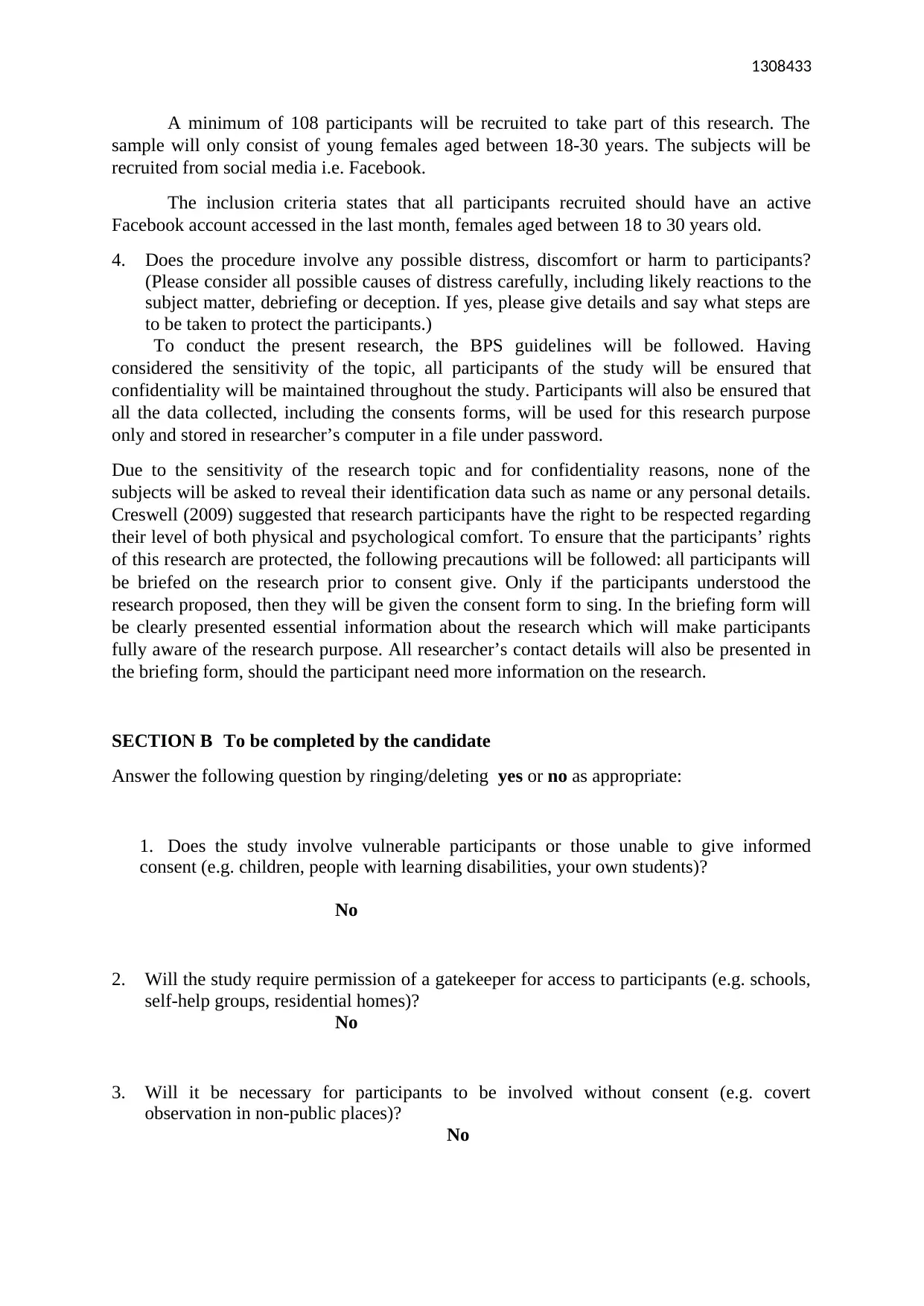
1308433
A minimum of 108 participants will be recruited to take part of this research. The
sample will only consist of young females aged between 18-30 years. The subjects will be
recruited from social media i.e. Facebook.
The inclusion criteria states that all participants recruited should have an active
Facebook account accessed in the last month, females aged between 18 to 30 years old.
4. Does the procedure involve any possible distress, discomfort or harm to participants?
(Please consider all possible causes of distress carefully, including likely reactions to the
subject matter, debriefing or deception. If yes, please give details and say what steps are
to be taken to protect the participants.)
To conduct the present research, the BPS guidelines will be followed. Having
considered the sensitivity of the topic, all participants of the study will be ensured that
confidentiality will be maintained throughout the study. Participants will also be ensured that
all the data collected, including the consents forms, will be used for this research purpose
only and stored in researcher’s computer in a file under password.
Due to the sensitivity of the research topic and for confidentiality reasons, none of the
subjects will be asked to reveal their identification data such as name or any personal details.
Creswell (2009) suggested that research participants have the right to be respected regarding
their level of both physical and psychological comfort. To ensure that the participants’ rights
of this research are protected, the following precautions will be followed: all participants will
be briefed on the research prior to consent give. Only if the participants understood the
research proposed, then they will be given the consent form to sing. In the briefing form will
be clearly presented essential information about the research which will make participants
fully aware of the research purpose. All researcher’s contact details will also be presented in
the briefing form, should the participant need more information on the research.
SECTION B To be completed by the candidate
Answer the following question by ringing/deleting yes or no as appropriate:
1. Does the study involve vulnerable participants or those unable to give informed
consent (e.g. children, people with learning disabilities, your own students)?
No
2. Will the study require permission of a gatekeeper for access to participants (e.g. schools,
self-help groups, residential homes)?
No
3. Will it be necessary for participants to be involved without consent (e.g. covert
observation in non-public places)?
No
A minimum of 108 participants will be recruited to take part of this research. The
sample will only consist of young females aged between 18-30 years. The subjects will be
recruited from social media i.e. Facebook.
The inclusion criteria states that all participants recruited should have an active
Facebook account accessed in the last month, females aged between 18 to 30 years old.
4. Does the procedure involve any possible distress, discomfort or harm to participants?
(Please consider all possible causes of distress carefully, including likely reactions to the
subject matter, debriefing or deception. If yes, please give details and say what steps are
to be taken to protect the participants.)
To conduct the present research, the BPS guidelines will be followed. Having
considered the sensitivity of the topic, all participants of the study will be ensured that
confidentiality will be maintained throughout the study. Participants will also be ensured that
all the data collected, including the consents forms, will be used for this research purpose
only and stored in researcher’s computer in a file under password.
Due to the sensitivity of the research topic and for confidentiality reasons, none of the
subjects will be asked to reveal their identification data such as name or any personal details.
Creswell (2009) suggested that research participants have the right to be respected regarding
their level of both physical and psychological comfort. To ensure that the participants’ rights
of this research are protected, the following precautions will be followed: all participants will
be briefed on the research prior to consent give. Only if the participants understood the
research proposed, then they will be given the consent form to sing. In the briefing form will
be clearly presented essential information about the research which will make participants
fully aware of the research purpose. All researcher’s contact details will also be presented in
the briefing form, should the participant need more information on the research.
SECTION B To be completed by the candidate
Answer the following question by ringing/deleting yes or no as appropriate:
1. Does the study involve vulnerable participants or those unable to give informed
consent (e.g. children, people with learning disabilities, your own students)?
No
2. Will the study require permission of a gatekeeper for access to participants (e.g. schools,
self-help groups, residential homes)?
No
3. Will it be necessary for participants to be involved without consent (e.g. covert
observation in non-public places)?
No
Paraphrase This Document
Need a fresh take? Get an instant paraphrase of this document with our AI Paraphraser
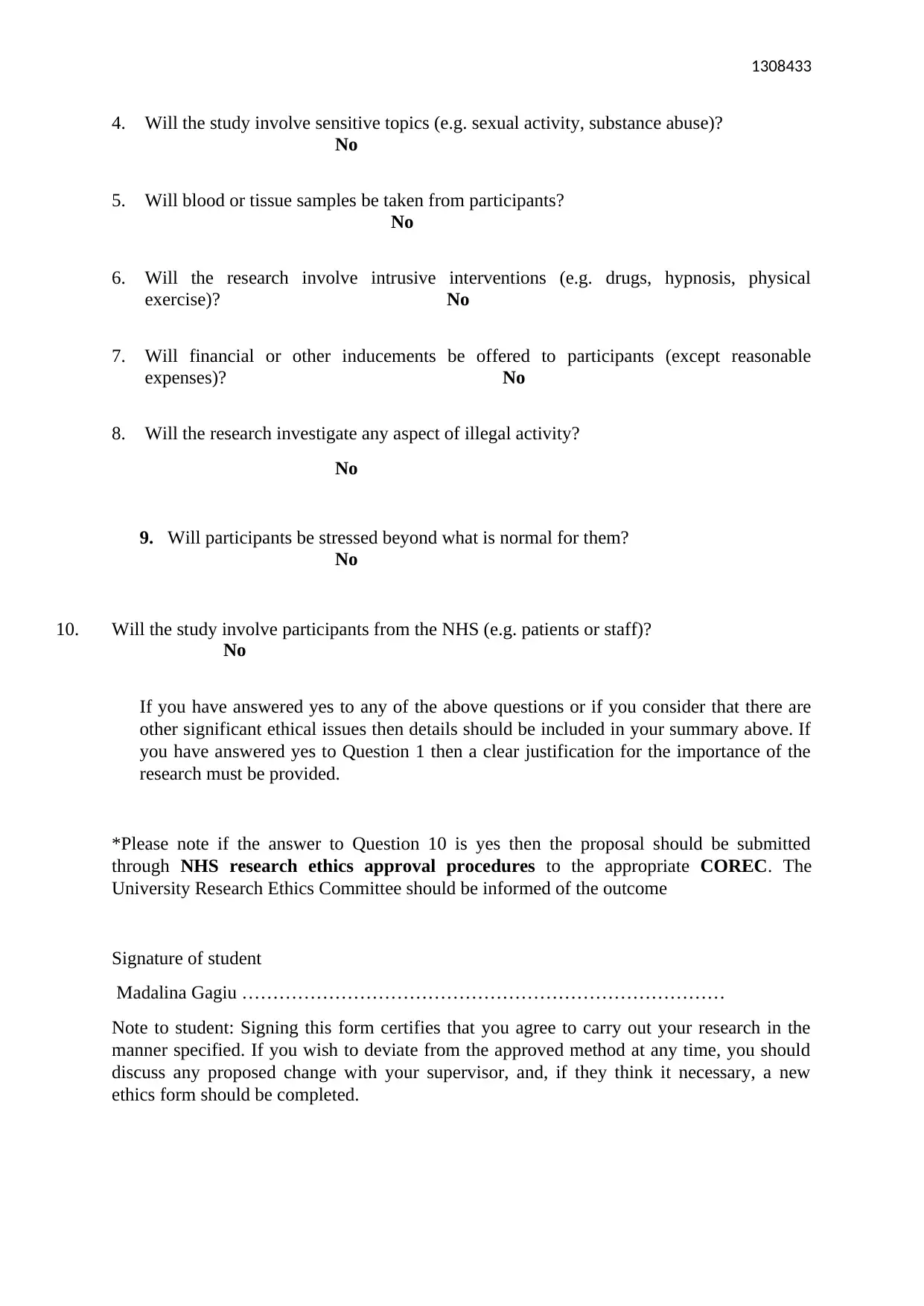
1308433
4. Will the study involve sensitive topics (e.g. sexual activity, substance abuse)?
No
5. Will blood or tissue samples be taken from participants?
No
6. Will the research involve intrusive interventions (e.g. drugs, hypnosis, physical
exercise)? No
7. Will financial or other inducements be offered to participants (except reasonable
expenses)? No
8. Will the research investigate any aspect of illegal activity?
No
9. Will participants be stressed beyond what is normal for them?
No
10. Will the study involve participants from the NHS (e.g. patients or staff)?
No
If you have answered yes to any of the above questions or if you consider that there are
other significant ethical issues then details should be included in your summary above. If
you have answered yes to Question 1 then a clear justification for the importance of the
research must be provided.
*Please note if the answer to Question 10 is yes then the proposal should be submitted
through NHS research ethics approval procedures to the appropriate COREC. The
University Research Ethics Committee should be informed of the outcome
Signature of student
Madalina Gagiu ……………………………………………………………………
Note to student: Signing this form certifies that you agree to carry out your research in the
manner specified. If you wish to deviate from the approved method at any time, you should
discuss any proposed change with your supervisor, and, if they think it necessary, a new
ethics form should be completed.
4. Will the study involve sensitive topics (e.g. sexual activity, substance abuse)?
No
5. Will blood or tissue samples be taken from participants?
No
6. Will the research involve intrusive interventions (e.g. drugs, hypnosis, physical
exercise)? No
7. Will financial or other inducements be offered to participants (except reasonable
expenses)? No
8. Will the research investigate any aspect of illegal activity?
No
9. Will participants be stressed beyond what is normal for them?
No
10. Will the study involve participants from the NHS (e.g. patients or staff)?
No
If you have answered yes to any of the above questions or if you consider that there are
other significant ethical issues then details should be included in your summary above. If
you have answered yes to Question 1 then a clear justification for the importance of the
research must be provided.
*Please note if the answer to Question 10 is yes then the proposal should be submitted
through NHS research ethics approval procedures to the appropriate COREC. The
University Research Ethics Committee should be informed of the outcome
Signature of student
Madalina Gagiu ……………………………………………………………………
Note to student: Signing this form certifies that you agree to carry out your research in the
manner specified. If you wish to deviate from the approved method at any time, you should
discuss any proposed change with your supervisor, and, if they think it necessary, a new
ethics form should be completed.
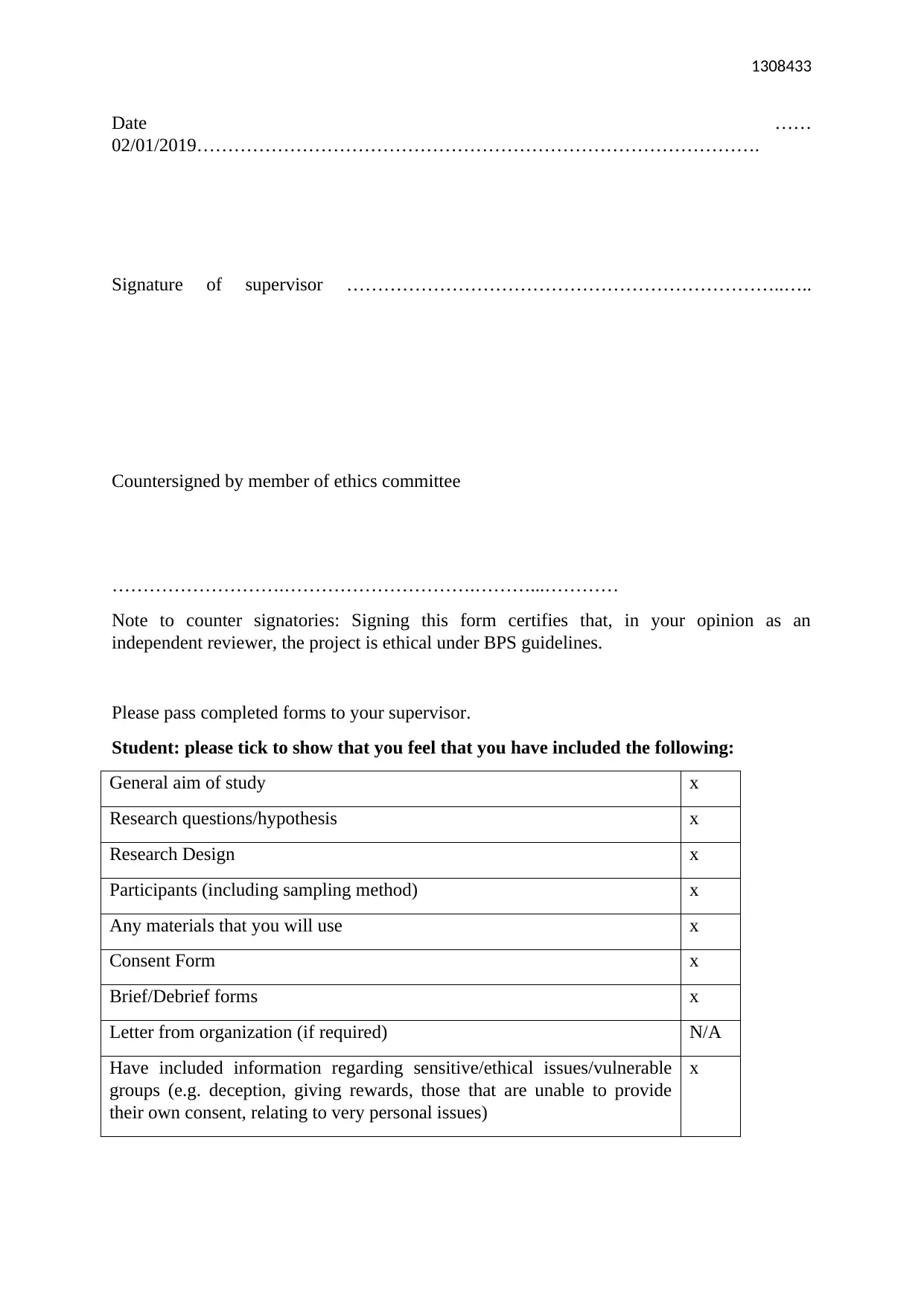
1308433
Date ……
02/01/2019……………………………………………………………………………….
Signature of supervisor ……………………………………………………………..…..
Countersigned by member of ethics committee
……………………….………………………….………...…………
Note to counter signatories: Signing this form certifies that, in your opinion as an
independent reviewer, the project is ethical under BPS guidelines.
Please pass completed forms to your supervisor.
Student: please tick to show that you feel that you have included the following:
General aim of study x
Research questions/hypothesis x
Research Design x
Participants (including sampling method) x
Any materials that you will use x
Consent Form x
Brief/Debrief forms x
Letter from organization (if required) N/A
Have included information regarding sensitive/ethical issues/vulnerable
groups (e.g. deception, giving rewards, those that are unable to provide
their own consent, relating to very personal issues)
x
Date ……
02/01/2019……………………………………………………………………………….
Signature of supervisor ……………………………………………………………..…..
Countersigned by member of ethics committee
……………………….………………………….………...…………
Note to counter signatories: Signing this form certifies that, in your opinion as an
independent reviewer, the project is ethical under BPS guidelines.
Please pass completed forms to your supervisor.
Student: please tick to show that you feel that you have included the following:
General aim of study x
Research questions/hypothesis x
Research Design x
Participants (including sampling method) x
Any materials that you will use x
Consent Form x
Brief/Debrief forms x
Letter from organization (if required) N/A
Have included information regarding sensitive/ethical issues/vulnerable
groups (e.g. deception, giving rewards, those that are unable to provide
their own consent, relating to very personal issues)
x

1308433
Secure Best Marks with AI Grader
Need help grading? Try our AI Grader for instant feedback on your assignments.
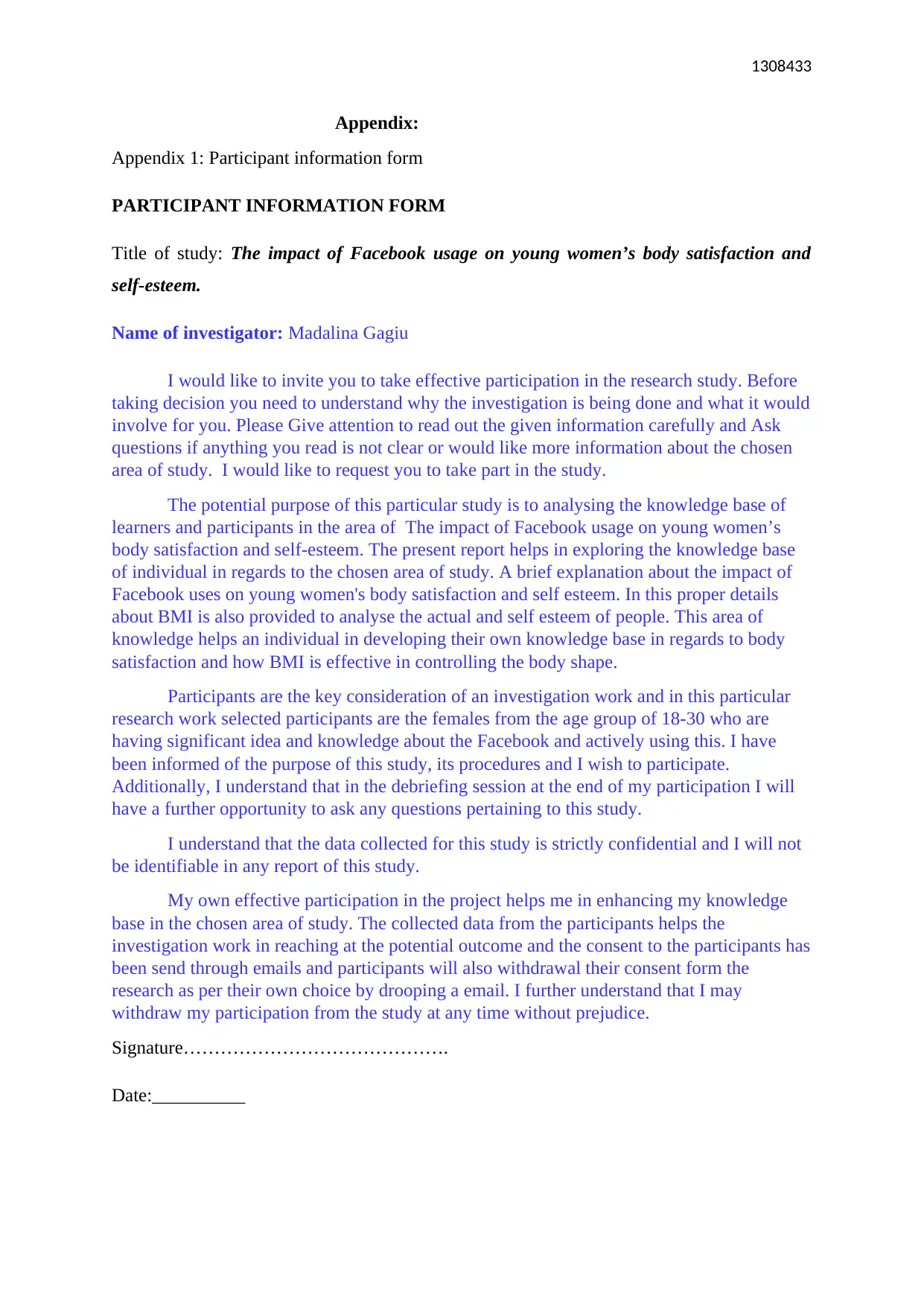
1308433
Appendix:
Appendix 1: Participant information form
PARTICIPANT INFORMATION FORM
Title of study: The impact of Facebook usage on young women’s body satisfaction and
self-esteem.
Name of investigator: Madalina Gagiu
I would like to invite you to take effective participation in the research study. Before
taking decision you need to understand why the investigation is being done and what it would
involve for you. Please Give attention to read out the given information carefully and Ask
questions if anything you read is not clear or would like more information about the chosen
area of study. I would like to request you to take part in the study.
The potential purpose of this particular study is to analysing the knowledge base of
learners and participants in the area of The impact of Facebook usage on young women’s
body satisfaction and self-esteem. The present report helps in exploring the knowledge base
of individual in regards to the chosen area of study. A brief explanation about the impact of
Facebook uses on young women's body satisfaction and self esteem. In this proper details
about BMI is also provided to analyse the actual and self esteem of people. This area of
knowledge helps an individual in developing their own knowledge base in regards to body
satisfaction and how BMI is effective in controlling the body shape.
Participants are the key consideration of an investigation work and in this particular
research work selected participants are the females from the age group of 18-30 who are
having significant idea and knowledge about the Facebook and actively using this. I have
been informed of the purpose of this study, its procedures and I wish to participate.
Additionally, I understand that in the debriefing session at the end of my participation I will
have a further opportunity to ask any questions pertaining to this study.
I understand that the data collected for this study is strictly confidential and I will not
be identifiable in any report of this study.
My own effective participation in the project helps me in enhancing my knowledge
base in the chosen area of study. The collected data from the participants helps the
investigation work in reaching at the potential outcome and the consent to the participants has
been send through emails and participants will also withdrawal their consent form the
research as per their own choice by drooping a email. I further understand that I may
withdraw my participation from the study at any time without prejudice.
Signature…………………………………….
Date:__________
Appendix:
Appendix 1: Participant information form
PARTICIPANT INFORMATION FORM
Title of study: The impact of Facebook usage on young women’s body satisfaction and
self-esteem.
Name of investigator: Madalina Gagiu
I would like to invite you to take effective participation in the research study. Before
taking decision you need to understand why the investigation is being done and what it would
involve for you. Please Give attention to read out the given information carefully and Ask
questions if anything you read is not clear or would like more information about the chosen
area of study. I would like to request you to take part in the study.
The potential purpose of this particular study is to analysing the knowledge base of
learners and participants in the area of The impact of Facebook usage on young women’s
body satisfaction and self-esteem. The present report helps in exploring the knowledge base
of individual in regards to the chosen area of study. A brief explanation about the impact of
Facebook uses on young women's body satisfaction and self esteem. In this proper details
about BMI is also provided to analyse the actual and self esteem of people. This area of
knowledge helps an individual in developing their own knowledge base in regards to body
satisfaction and how BMI is effective in controlling the body shape.
Participants are the key consideration of an investigation work and in this particular
research work selected participants are the females from the age group of 18-30 who are
having significant idea and knowledge about the Facebook and actively using this. I have
been informed of the purpose of this study, its procedures and I wish to participate.
Additionally, I understand that in the debriefing session at the end of my participation I will
have a further opportunity to ask any questions pertaining to this study.
I understand that the data collected for this study is strictly confidential and I will not
be identifiable in any report of this study.
My own effective participation in the project helps me in enhancing my knowledge
base in the chosen area of study. The collected data from the participants helps the
investigation work in reaching at the potential outcome and the consent to the participants has
been send through emails and participants will also withdrawal their consent form the
research as per their own choice by drooping a email. I further understand that I may
withdraw my participation from the study at any time without prejudice.
Signature…………………………………….
Date:__________
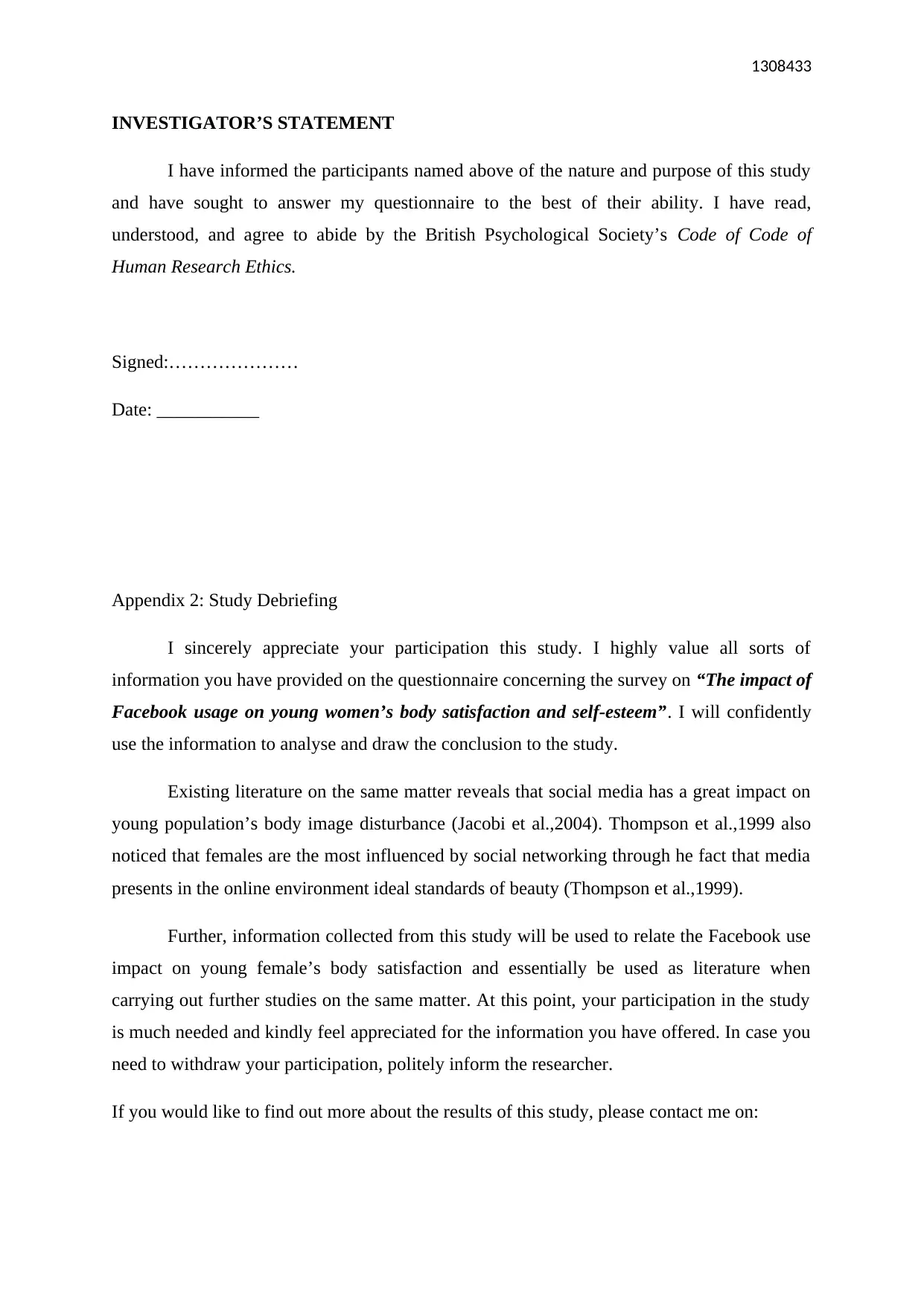
1308433
INVESTIGATOR’S STATEMENT
I have informed the participants named above of the nature and purpose of this study
and have sought to answer my questionnaire to the best of their ability. I have read,
understood, and agree to abide by the British Psychological Society’s Code of Code of
Human Research Ethics.
Signed:…………………
Date: ___________
Appendix 2: Study Debriefing
I sincerely appreciate your participation this study. I highly value all sorts of
information you have provided on the questionnaire concerning the survey on “The impact of
Facebook usage on young women’s body satisfaction and self-esteem”. I will confidently
use the information to analyse and draw the conclusion to the study.
Existing literature on the same matter reveals that social media has a great impact on
young population’s body image disturbance (Jacobi et al.,2004). Thompson et al.,1999 also
noticed that females are the most influenced by social networking through he fact that media
presents in the online environment ideal standards of beauty (Thompson et al.,1999).
Further, information collected from this study will be used to relate the Facebook use
impact on young female’s body satisfaction and essentially be used as literature when
carrying out further studies on the same matter. At this point, your participation in the study
is much needed and kindly feel appreciated for the information you have offered. In case you
need to withdraw your participation, politely inform the researcher.
If you would like to find out more about the results of this study, please contact me on:
INVESTIGATOR’S STATEMENT
I have informed the participants named above of the nature and purpose of this study
and have sought to answer my questionnaire to the best of their ability. I have read,
understood, and agree to abide by the British Psychological Society’s Code of Code of
Human Research Ethics.
Signed:…………………
Date: ___________
Appendix 2: Study Debriefing
I sincerely appreciate your participation this study. I highly value all sorts of
information you have provided on the questionnaire concerning the survey on “The impact of
Facebook usage on young women’s body satisfaction and self-esteem”. I will confidently
use the information to analyse and draw the conclusion to the study.
Existing literature on the same matter reveals that social media has a great impact on
young population’s body image disturbance (Jacobi et al.,2004). Thompson et al.,1999 also
noticed that females are the most influenced by social networking through he fact that media
presents in the online environment ideal standards of beauty (Thompson et al.,1999).
Further, information collected from this study will be used to relate the Facebook use
impact on young female’s body satisfaction and essentially be used as literature when
carrying out further studies on the same matter. At this point, your participation in the study
is much needed and kindly feel appreciated for the information you have offered. In case you
need to withdraw your participation, politely inform the researcher.
If you would like to find out more about the results of this study, please contact me on:

1308433
Thank you for your participation!
Thank you for your participation!
Paraphrase This Document
Need a fresh take? Get an instant paraphrase of this document with our AI Paraphraser
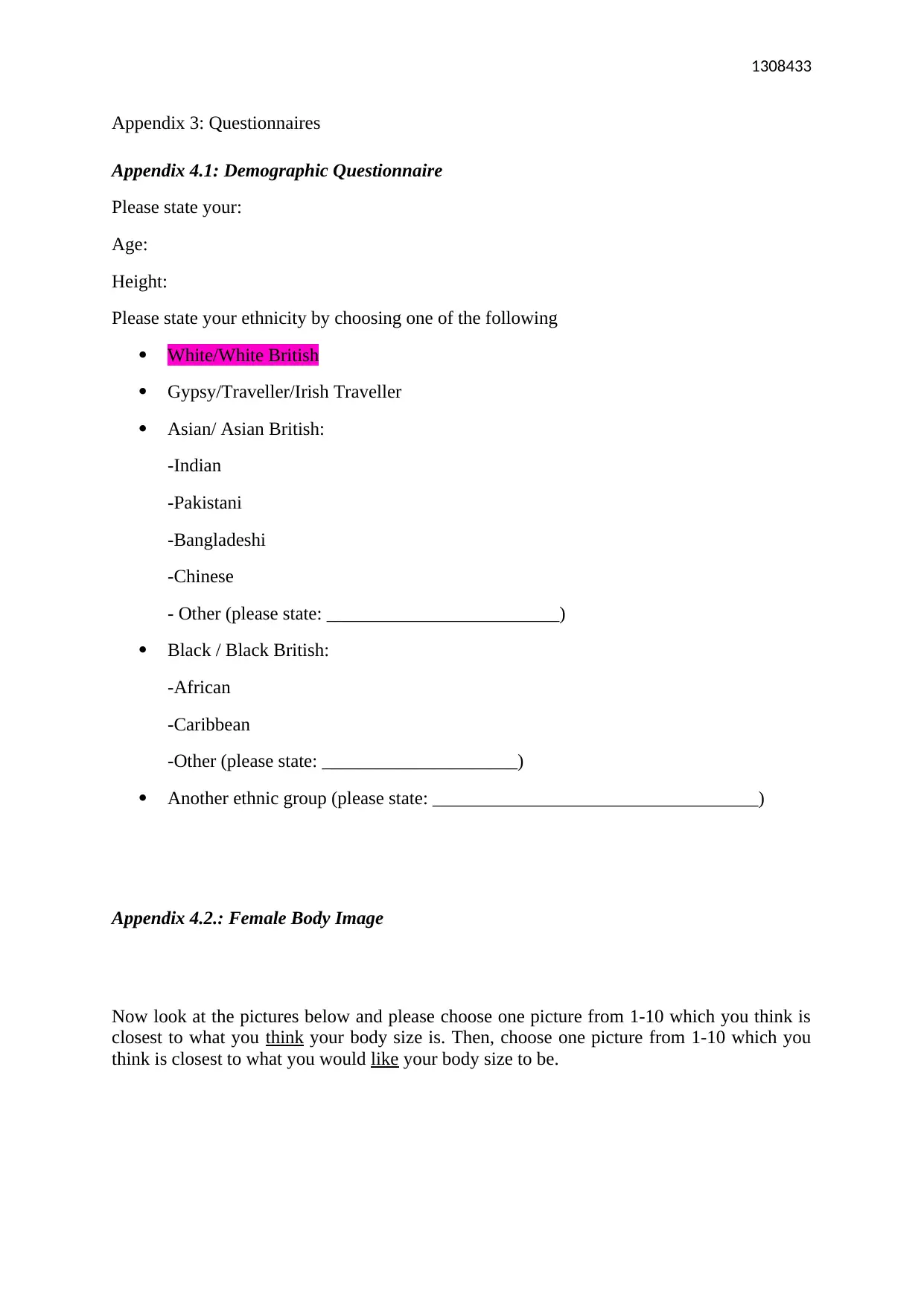
1308433
Appendix 3: Questionnaires
Appendix 4.1: Demographic Questionnaire
Please state your:
Age:
Height:
Please state your ethnicity by choosing one of the following
White/White British
Gypsy/Traveller/Irish Traveller
Asian/ Asian British:
-Indian
-Pakistani
-Bangladeshi
-Chinese
- Other (please state: _________________________)
Black / Black British:
-African
-Caribbean
-Other (please state: _____________________)
Another ethnic group (please state: ___________________________________)
Appendix 4.2.: Female Body Image
Now look at the pictures below and please choose one picture from 1-10 which you think is
closest to what you think your body size is. Then, choose one picture from 1-10 which you
think is closest to what you would like your body size to be.
Appendix 3: Questionnaires
Appendix 4.1: Demographic Questionnaire
Please state your:
Age:
Height:
Please state your ethnicity by choosing one of the following
White/White British
Gypsy/Traveller/Irish Traveller
Asian/ Asian British:
-Indian
-Pakistani
-Bangladeshi
-Chinese
- Other (please state: _________________________)
Black / Black British:
-African
-Caribbean
-Other (please state: _____________________)
Another ethnic group (please state: ___________________________________)
Appendix 4.2.: Female Body Image
Now look at the pictures below and please choose one picture from 1-10 which you think is
closest to what you think your body size is. Then, choose one picture from 1-10 which you
think is closest to what you would like your body size to be.
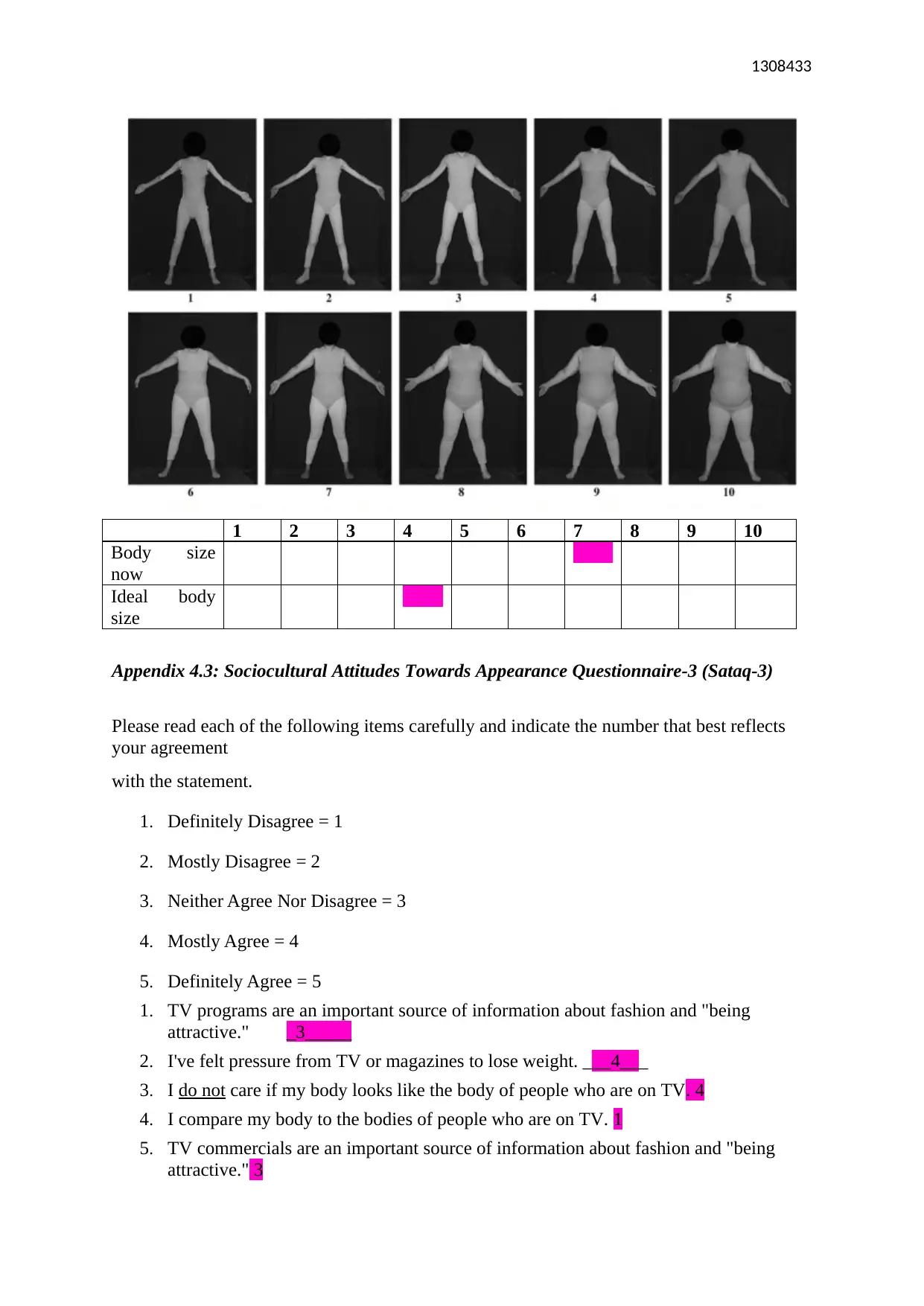
1308433
1 2 3 4 5 6 7 8 9 10
Body size
now
Ideal body
size
Appendix 4.3: Sociocultural Attitudes Towards Appearance Questionnaire-3 (Sataq-3)
Please read each of the following items carefully and indicate the number that best reflects
your agreement
with the statement.
1. Definitely Disagree = 1
2. Mostly Disagree = 2
3. Neither Agree Nor Disagree = 3
4. Mostly Agree = 4
5. Definitely Agree = 5
1. TV programs are an important source of information about fashion and "being
attractive." _3_____
2. I've felt pressure from TV or magazines to lose weight. ___4___
3. I do not care if my body looks like the body of people who are on TV. 4
4. I compare my body to the bodies of people who are on TV. 1
5. TV commercials are an important source of information about fashion and "being
attractive." 3
1 2 3 4 5 6 7 8 9 10
Body size
now
Ideal body
size
Appendix 4.3: Sociocultural Attitudes Towards Appearance Questionnaire-3 (Sataq-3)
Please read each of the following items carefully and indicate the number that best reflects
your agreement
with the statement.
1. Definitely Disagree = 1
2. Mostly Disagree = 2
3. Neither Agree Nor Disagree = 3
4. Mostly Agree = 4
5. Definitely Agree = 5
1. TV programs are an important source of information about fashion and "being
attractive." _3_____
2. I've felt pressure from TV or magazines to lose weight. ___4___
3. I do not care if my body looks like the body of people who are on TV. 4
4. I compare my body to the bodies of people who are on TV. 1
5. TV commercials are an important source of information about fashion and "being
attractive." 3
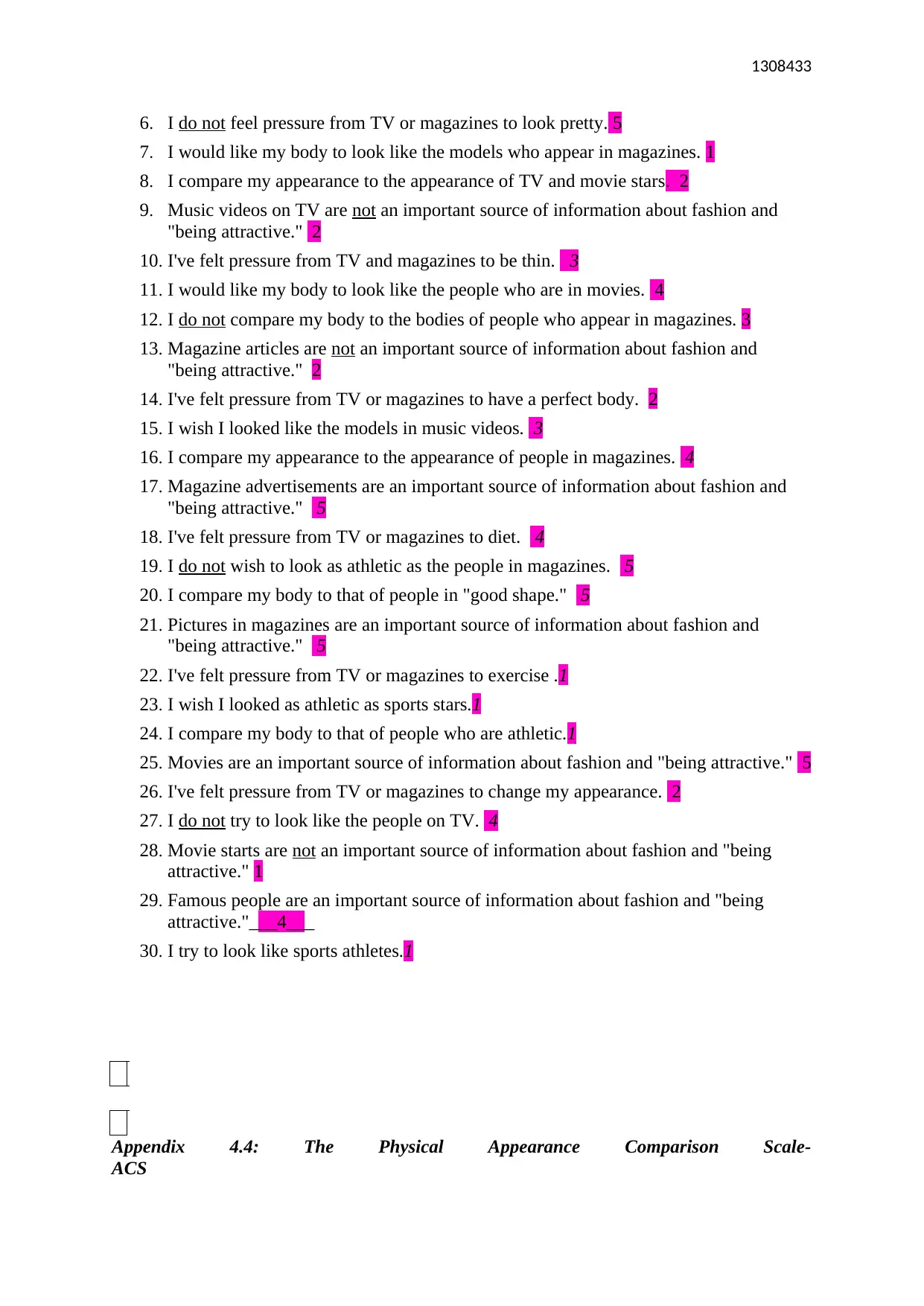
1308433
6. I do not feel pressure from TV or magazines to look pretty. 5
7. I would like my body to look like the models who appear in magazines. 1
8. I compare my appearance to the appearance of TV and movie stars. 2
9. Music videos on TV are not an important source of information about fashion and
"being attractive." 2
10. I've felt pressure from TV and magazines to be thin. 3
11. I would like my body to look like the people who are in movies. 4
12. I do not compare my body to the bodies of people who appear in magazines. 3
13. Magazine articles are not an important source of information about fashion and
"being attractive." 2
14. I've felt pressure from TV or magazines to have a perfect body. 2
15. I wish I looked like the models in music videos. 3
16. I compare my appearance to the appearance of people in magazines. 4
17. Magazine advertisements are an important source of information about fashion and
"being attractive." 5
18. I've felt pressure from TV or magazines to diet. 4
19. I do not wish to look as athletic as the people in magazines. 5
20. I compare my body to that of people in "good shape." 5
21. Pictures in magazines are an important source of information about fashion and
"being attractive." 5
22. I've felt pressure from TV or magazines to exercise .1
23. I wish I looked as athletic as sports stars.1
24. I compare my body to that of people who are athletic.1
25. Movies are an important source of information about fashion and "being attractive." 5
26. I've felt pressure from TV or magazines to change my appearance. 2
27. I do not try to look like the people on TV. 4
28. Movie starts are not an important source of information about fashion and "being
attractive." 1
29. Famous people are an important source of information about fashion and "being
attractive."___4___
30. I try to look like sports athletes.1
Appendix 4.4: The Physical Appearance Comparison Scale-
ACS
6. I do not feel pressure from TV or magazines to look pretty. 5
7. I would like my body to look like the models who appear in magazines. 1
8. I compare my appearance to the appearance of TV and movie stars. 2
9. Music videos on TV are not an important source of information about fashion and
"being attractive." 2
10. I've felt pressure from TV and magazines to be thin. 3
11. I would like my body to look like the people who are in movies. 4
12. I do not compare my body to the bodies of people who appear in magazines. 3
13. Magazine articles are not an important source of information about fashion and
"being attractive." 2
14. I've felt pressure from TV or magazines to have a perfect body. 2
15. I wish I looked like the models in music videos. 3
16. I compare my appearance to the appearance of people in magazines. 4
17. Magazine advertisements are an important source of information about fashion and
"being attractive." 5
18. I've felt pressure from TV or magazines to diet. 4
19. I do not wish to look as athletic as the people in magazines. 5
20. I compare my body to that of people in "good shape." 5
21. Pictures in magazines are an important source of information about fashion and
"being attractive." 5
22. I've felt pressure from TV or magazines to exercise .1
23. I wish I looked as athletic as sports stars.1
24. I compare my body to that of people who are athletic.1
25. Movies are an important source of information about fashion and "being attractive." 5
26. I've felt pressure from TV or magazines to change my appearance. 2
27. I do not try to look like the people on TV. 4
28. Movie starts are not an important source of information about fashion and "being
attractive." 1
29. Famous people are an important source of information about fashion and "being
attractive."___4___
30. I try to look like sports athletes.1
Appendix 4.4: The Physical Appearance Comparison Scale-
ACS
Secure Best Marks with AI Grader
Need help grading? Try our AI Grader for instant feedback on your assignments.
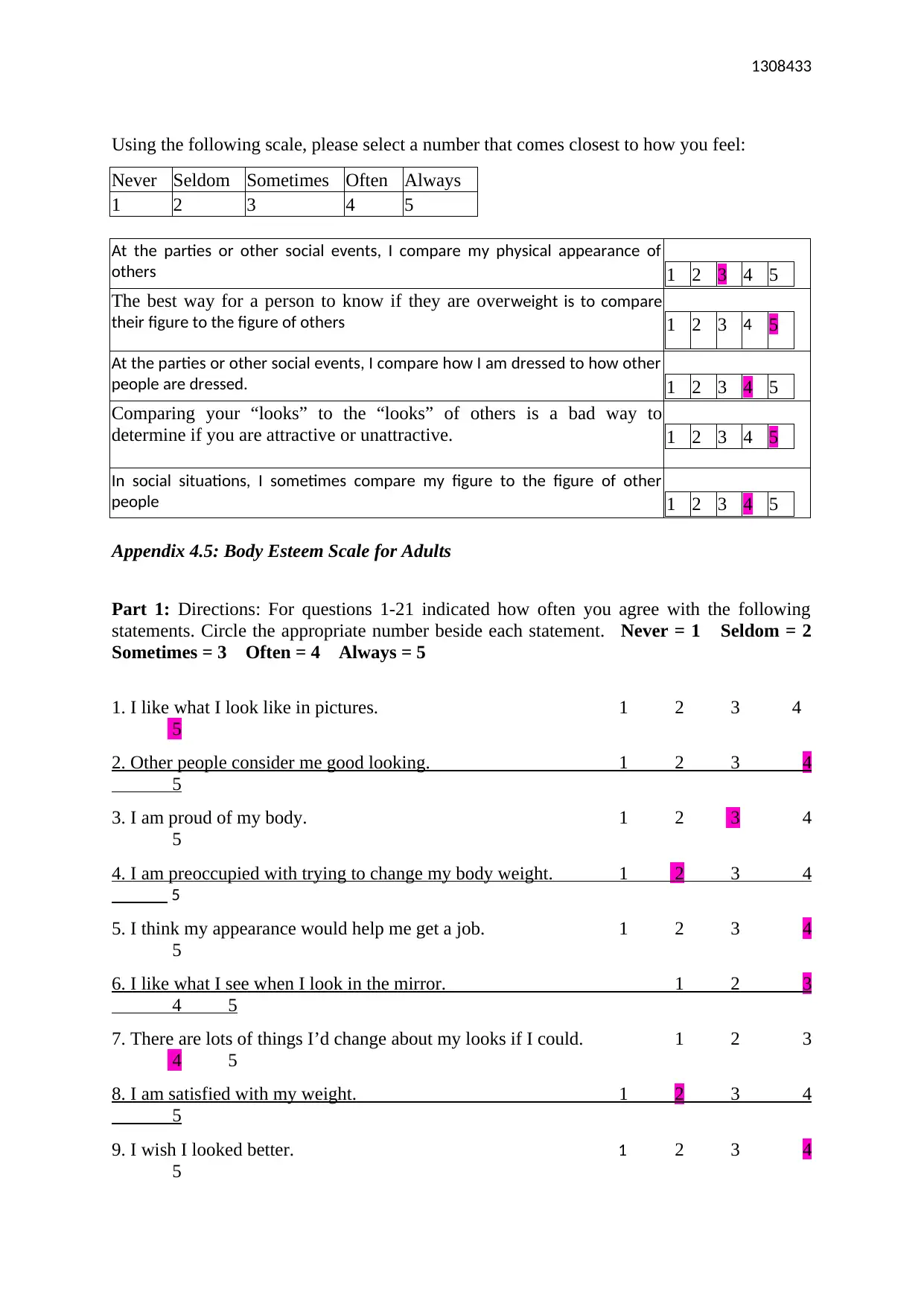
1308433
Using the following scale, please select a number that comes closest to how you feel:
Never Seldom Sometimes Often Always
1 2 3 4 5
At the parties or other social events, I compare my physical appearance of
others 1 2 3 4 5
The best way for a person to know if they are overweight is to compare
their figure to the figure of others 1 2 3 4 5
At the parties or other social events, I compare how I am dressed to how other
people are dressed. 1 2 3 4 5
Comparing your “looks” to the “looks” of others is a bad way to
determine if you are attractive or unattractive. 1 2 3 4 5
In social situations, I sometimes compare my figure to the figure of other
people 1 2 3 4 5
Appendix 4.5: Body Esteem Scale for Adults
Part 1: Directions: For questions 1-21 indicated how often you agree with the following
statements. Circle the appropriate number beside each statement. Never = 1 Seldom = 2
Sometimes = 3 Often = 4 Always = 5
1. I like what I look like in pictures. 1 2 3 4
5
2. Other people consider me good looking. 1 2 3 4
5
3. I am proud of my body. 1 2 3 4
5
4. I am preoccupied with trying to change my body weight. 1 2 3 4
5
5. I think my appearance would help me get a job. 1 2 3 4
5
6. I like what I see when I look in the mirror. 1 2 3
4 5
7. There are lots of things I’d change about my looks if I could. 1 2 3
4 5
8. I am satisfied with my weight. 1 2 3 4
5
9. I wish I looked better. 1 2 3 4
5
Using the following scale, please select a number that comes closest to how you feel:
Never Seldom Sometimes Often Always
1 2 3 4 5
At the parties or other social events, I compare my physical appearance of
others 1 2 3 4 5
The best way for a person to know if they are overweight is to compare
their figure to the figure of others 1 2 3 4 5
At the parties or other social events, I compare how I am dressed to how other
people are dressed. 1 2 3 4 5
Comparing your “looks” to the “looks” of others is a bad way to
determine if you are attractive or unattractive. 1 2 3 4 5
In social situations, I sometimes compare my figure to the figure of other
people 1 2 3 4 5
Appendix 4.5: Body Esteem Scale for Adults
Part 1: Directions: For questions 1-21 indicated how often you agree with the following
statements. Circle the appropriate number beside each statement. Never = 1 Seldom = 2
Sometimes = 3 Often = 4 Always = 5
1. I like what I look like in pictures. 1 2 3 4
5
2. Other people consider me good looking. 1 2 3 4
5
3. I am proud of my body. 1 2 3 4
5
4. I am preoccupied with trying to change my body weight. 1 2 3 4
5
5. I think my appearance would help me get a job. 1 2 3 4
5
6. I like what I see when I look in the mirror. 1 2 3
4 5
7. There are lots of things I’d change about my looks if I could. 1 2 3
4 5
8. I am satisfied with my weight. 1 2 3 4
5
9. I wish I looked better. 1 2 3 4
5
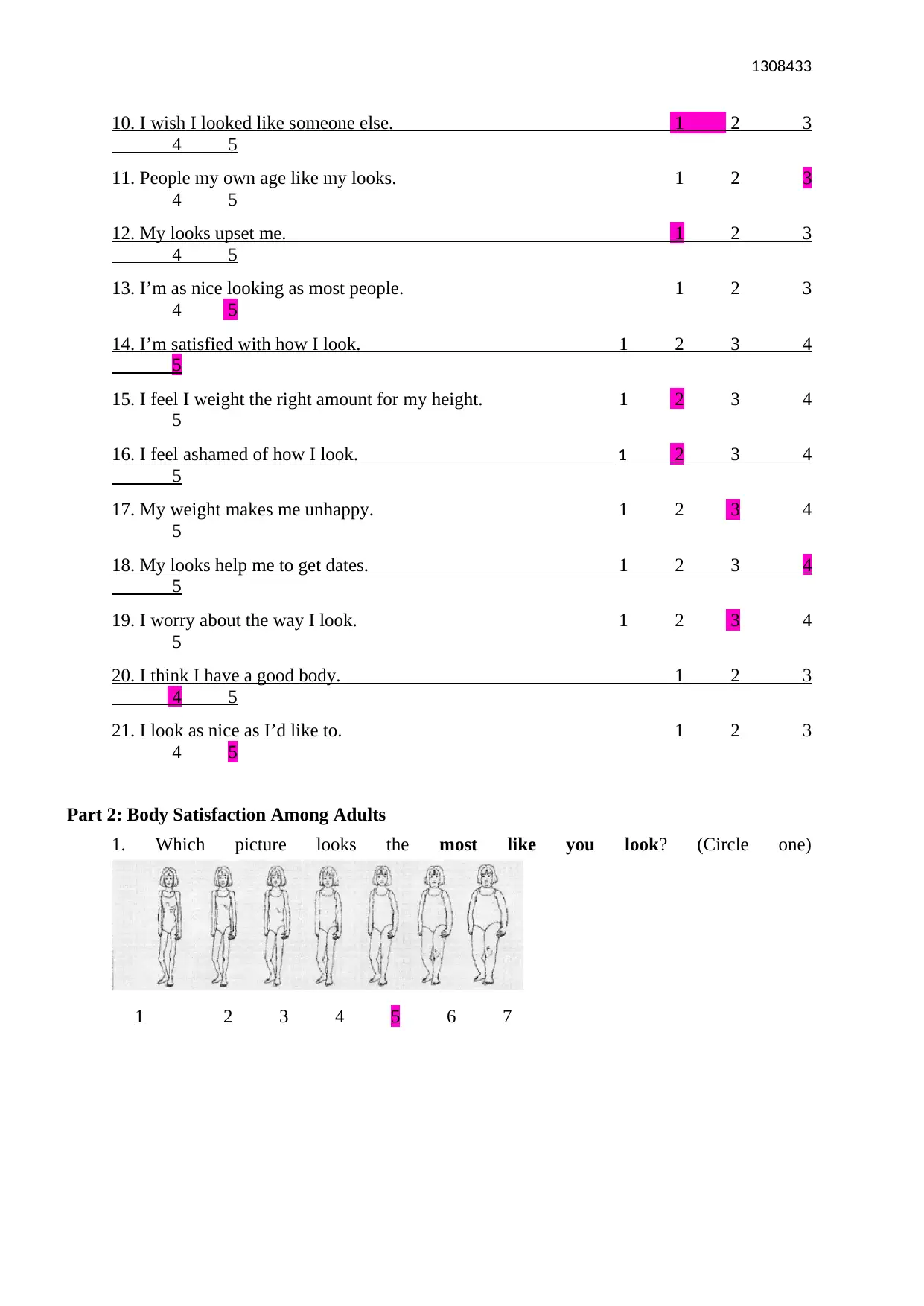
1308433
10. I wish I looked like someone else. 1 2 3
4 5
11. People my own age like my looks. 1 2 3
4 5
12. My looks upset me. 1 2 3
4 5
13. I’m as nice looking as most people. 1 2 3
4 5
14. I’m satisfied with how I look. 1 2 3 4
5
15. I feel I weight the right amount for my height. 1 2 3 4
5
16. I feel ashamed of how I look. 1 2 3 4
5
17. My weight makes me unhappy. 1 2 3 4
5
18. My looks help me to get dates. 1 2 3 4
5
19. I worry about the way I look. 1 2 3 4
5
20. I think I have a good body. 1 2 3
4 5
21. I look as nice as I’d like to. 1 2 3
4 5
Part 2: Body Satisfaction Among Adults
1. Which picture looks the most like you look? (Circle one)
1 2 3 4 5 6 7
10. I wish I looked like someone else. 1 2 3
4 5
11. People my own age like my looks. 1 2 3
4 5
12. My looks upset me. 1 2 3
4 5
13. I’m as nice looking as most people. 1 2 3
4 5
14. I’m satisfied with how I look. 1 2 3 4
5
15. I feel I weight the right amount for my height. 1 2 3 4
5
16. I feel ashamed of how I look. 1 2 3 4
5
17. My weight makes me unhappy. 1 2 3 4
5
18. My looks help me to get dates. 1 2 3 4
5
19. I worry about the way I look. 1 2 3 4
5
20. I think I have a good body. 1 2 3
4 5
21. I look as nice as I’d like to. 1 2 3
4 5
Part 2: Body Satisfaction Among Adults
1. Which picture looks the most like you look? (Circle one)
1 2 3 4 5 6 7
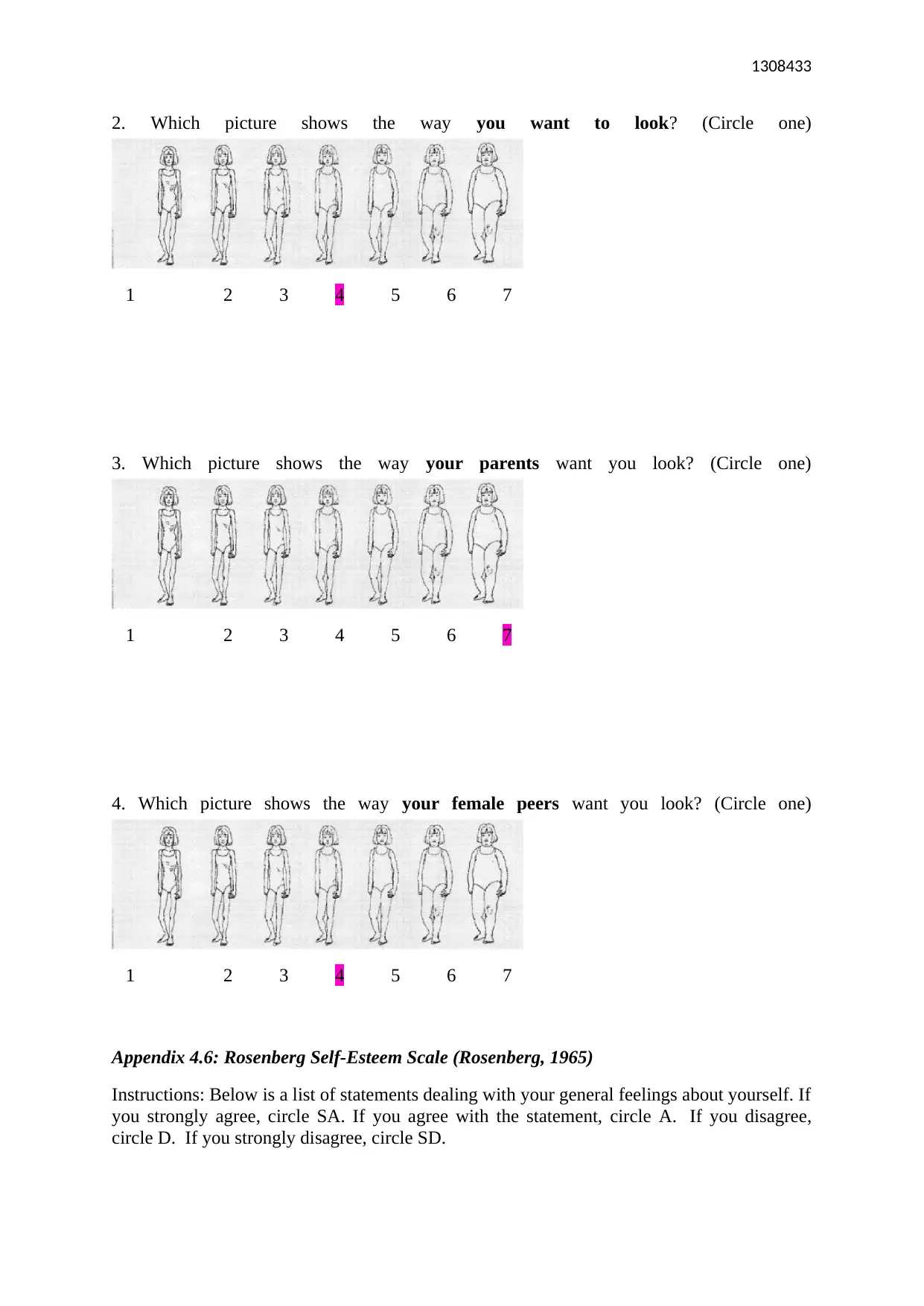
1308433
2. Which picture shows the way you want to look? (Circle one)
1 2 3 4 5 6 7
3. Which picture shows the way your parents want you look? (Circle one)
1 2 3 4 5 6 7
4. Which picture shows the way your female peers want you look? (Circle one)
1 2 3 4 5 6 7
Appendix 4.6: Rosenberg Self-Esteem Scale (Rosenberg, 1965)
Instructions: Below is a list of statements dealing with your general feelings about yourself. If
you strongly agree, circle SA. If you agree with the statement, circle A. If you disagree,
circle D. If you strongly disagree, circle SD.
2. Which picture shows the way you want to look? (Circle one)
1 2 3 4 5 6 7
3. Which picture shows the way your parents want you look? (Circle one)
1 2 3 4 5 6 7
4. Which picture shows the way your female peers want you look? (Circle one)
1 2 3 4 5 6 7
Appendix 4.6: Rosenberg Self-Esteem Scale (Rosenberg, 1965)
Instructions: Below is a list of statements dealing with your general feelings about yourself. If
you strongly agree, circle SA. If you agree with the statement, circle A. If you disagree,
circle D. If you strongly disagree, circle SD.
Paraphrase This Document
Need a fresh take? Get an instant paraphrase of this document with our AI Paraphraser
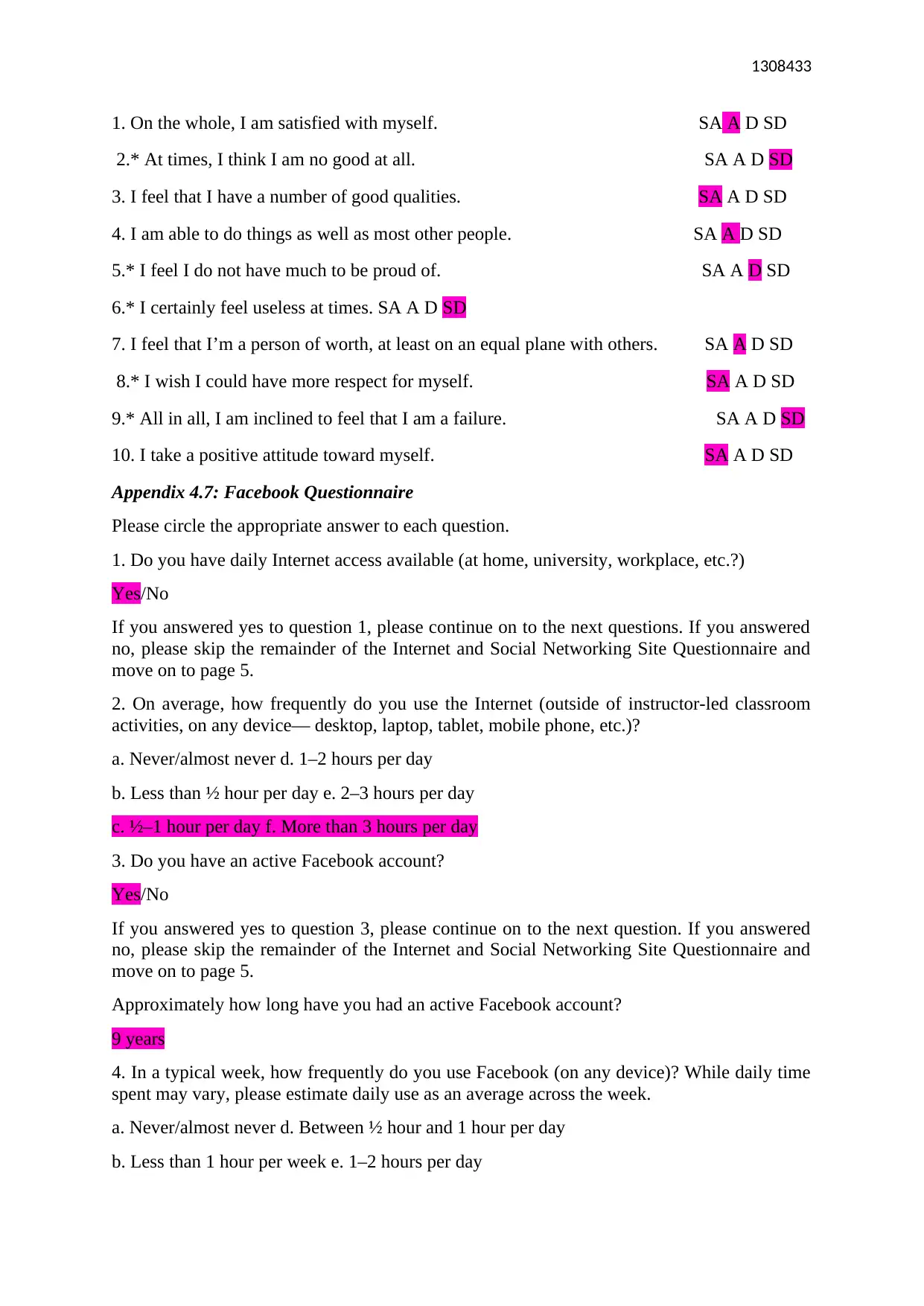
1308433
1. On the whole, I am satisfied with myself. SA A D SD
2.* At times, I think I am no good at all. SA A D SD
3. I feel that I have a number of good qualities. SA A D SD
4. I am able to do things as well as most other people. SA A D SD
5.* I feel I do not have much to be proud of. SA A D SD
6.* I certainly feel useless at times. SA A D SD
7. I feel that I’m a person of worth, at least on an equal plane with others. SA A D SD
8.* I wish I could have more respect for myself. SA A D SD
9.* All in all, I am inclined to feel that I am a failure. SA A D SD
10. I take a positive attitude toward myself. SA A D SD
Appendix 4.7: Facebook Questionnaire
Please circle the appropriate answer to each question.
1. Do you have daily Internet access available (at home, university, workplace, etc.?)
Yes/No
If you answered yes to question 1, please continue on to the next questions. If you answered
no, please skip the remainder of the Internet and Social Networking Site Questionnaire and
move on to page 5.
2. On average, how frequently do you use the Internet (outside of instructor-led classroom
activities, on any device— desktop, laptop, tablet, mobile phone, etc.)?
a. Never/almost never d. 1–2 hours per day
b. Less than ½ hour per day e. 2–3 hours per day
c. ½–1 hour per day f. More than 3 hours per day
3. Do you have an active Facebook account?
Yes/No
If you answered yes to question 3, please continue on to the next question. If you answered
no, please skip the remainder of the Internet and Social Networking Site Questionnaire and
move on to page 5.
Approximately how long have you had an active Facebook account?
9 years
4. In a typical week, how frequently do you use Facebook (on any device)? While daily time
spent may vary, please estimate daily use as an average across the week.
a. Never/almost never d. Between ½ hour and 1 hour per day
b. Less than 1 hour per week e. 1–2 hours per day
1. On the whole, I am satisfied with myself. SA A D SD
2.* At times, I think I am no good at all. SA A D SD
3. I feel that I have a number of good qualities. SA A D SD
4. I am able to do things as well as most other people. SA A D SD
5.* I feel I do not have much to be proud of. SA A D SD
6.* I certainly feel useless at times. SA A D SD
7. I feel that I’m a person of worth, at least on an equal plane with others. SA A D SD
8.* I wish I could have more respect for myself. SA A D SD
9.* All in all, I am inclined to feel that I am a failure. SA A D SD
10. I take a positive attitude toward myself. SA A D SD
Appendix 4.7: Facebook Questionnaire
Please circle the appropriate answer to each question.
1. Do you have daily Internet access available (at home, university, workplace, etc.?)
Yes/No
If you answered yes to question 1, please continue on to the next questions. If you answered
no, please skip the remainder of the Internet and Social Networking Site Questionnaire and
move on to page 5.
2. On average, how frequently do you use the Internet (outside of instructor-led classroom
activities, on any device— desktop, laptop, tablet, mobile phone, etc.)?
a. Never/almost never d. 1–2 hours per day
b. Less than ½ hour per day e. 2–3 hours per day
c. ½–1 hour per day f. More than 3 hours per day
3. Do you have an active Facebook account?
Yes/No
If you answered yes to question 3, please continue on to the next question. If you answered
no, please skip the remainder of the Internet and Social Networking Site Questionnaire and
move on to page 5.
Approximately how long have you had an active Facebook account?
9 years
4. In a typical week, how frequently do you use Facebook (on any device)? While daily time
spent may vary, please estimate daily use as an average across the week.
a. Never/almost never d. Between ½ hour and 1 hour per day
b. Less than 1 hour per week e. 1–2 hours per day
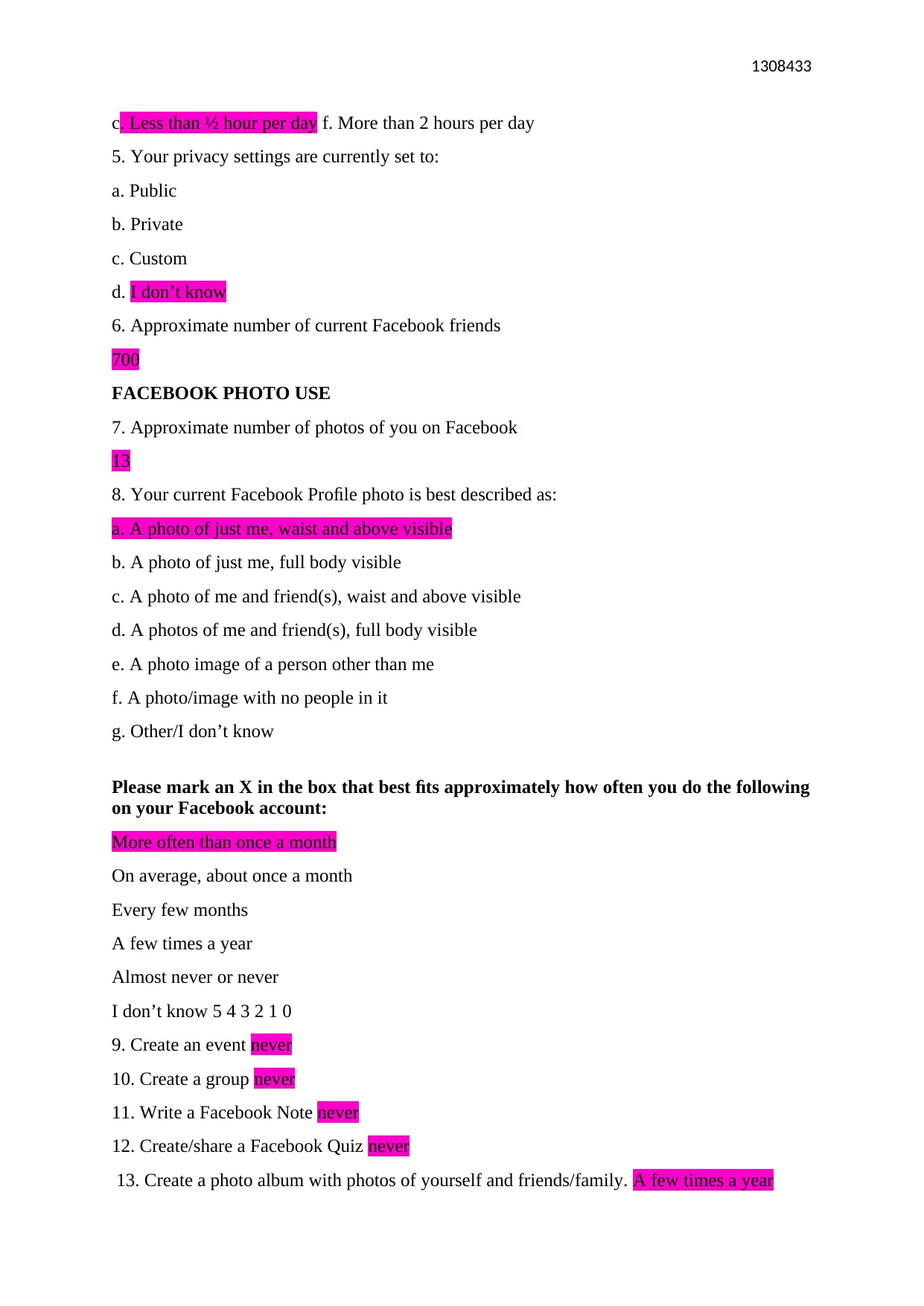
1308433
c. Less than ½ hour per day f. More than 2 hours per day
5. Your privacy settings are currently set to:
a. Public
b. Private
c. Custom
d. I don’t know
6. Approximate number of current Facebook friends
700
FACEBOOK PHOTO USE
7. Approximate number of photos of you on Facebook
13
8. Your current Facebook Profile photo is best described as:
a. A photo of just me, waist and above visible
b. A photo of just me, full body visible
c. A photo of me and friend(s), waist and above visible
d. A photos of me and friend(s), full body visible
e. A photo image of a person other than me
f. A photo/image with no people in it
g. Other/I don’t know
Please mark an X in the box that best fits approximately how often you do the following
on your Facebook account:
More often than once a month
On average, about once a month
Every few months
A few times a year
Almost never or never
I don’t know 5 4 3 2 1 0
9. Create an event never
10. Create a group never
11. Write a Facebook Note never
12. Create/share a Facebook Quiz never
13. Create a photo album with photos of yourself and friends/family. A few times a year
c. Less than ½ hour per day f. More than 2 hours per day
5. Your privacy settings are currently set to:
a. Public
b. Private
c. Custom
d. I don’t know
6. Approximate number of current Facebook friends
700
FACEBOOK PHOTO USE
7. Approximate number of photos of you on Facebook
13
8. Your current Facebook Profile photo is best described as:
a. A photo of just me, waist and above visible
b. A photo of just me, full body visible
c. A photo of me and friend(s), waist and above visible
d. A photos of me and friend(s), full body visible
e. A photo image of a person other than me
f. A photo/image with no people in it
g. Other/I don’t know
Please mark an X in the box that best fits approximately how often you do the following
on your Facebook account:
More often than once a month
On average, about once a month
Every few months
A few times a year
Almost never or never
I don’t know 5 4 3 2 1 0
9. Create an event never
10. Create a group never
11. Write a Facebook Note never
12. Create/share a Facebook Quiz never
13. Create a photo album with photos of yourself and friends/family. A few times a year
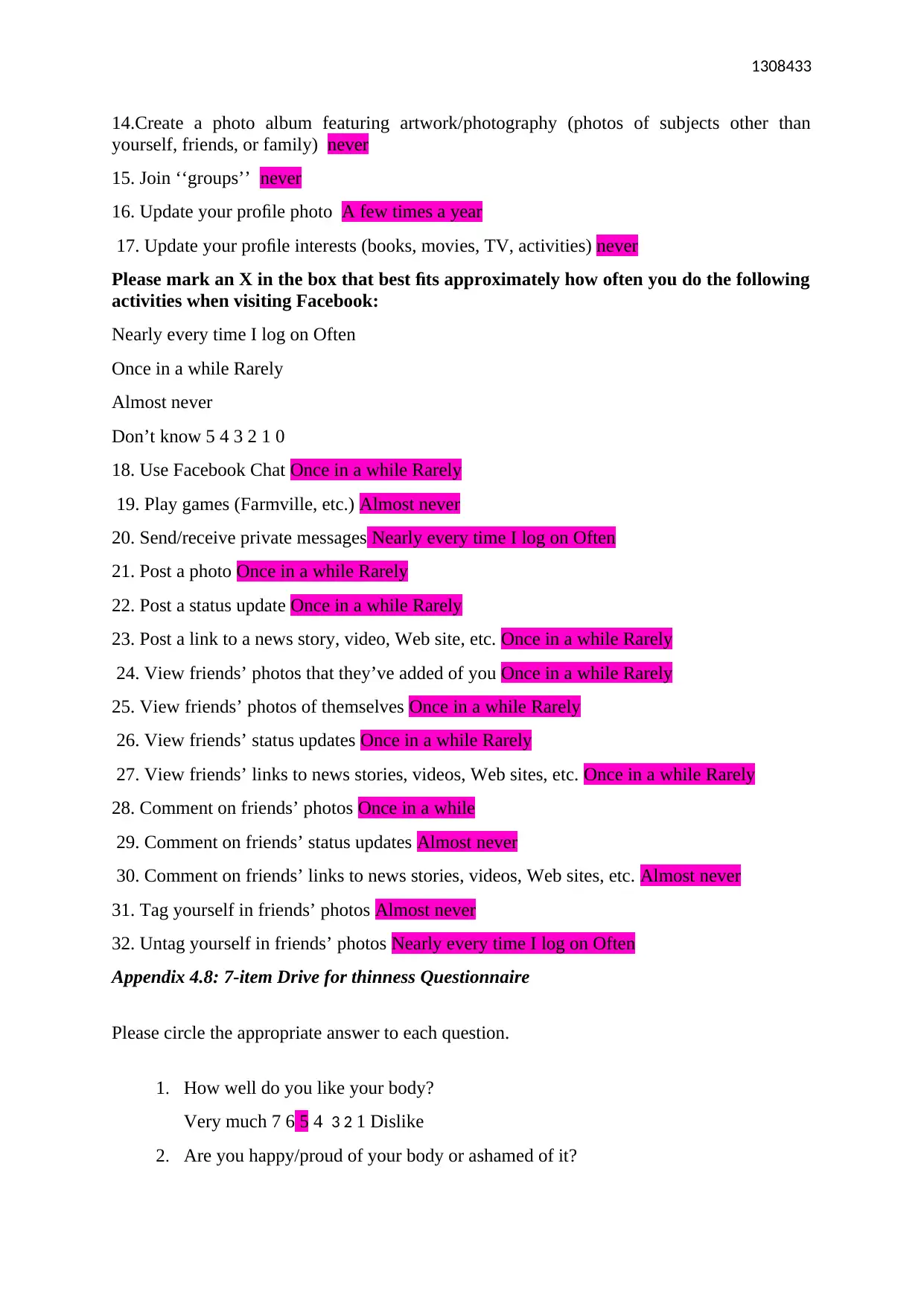
1308433
14.Create a photo album featuring artwork/photography (photos of subjects other than
yourself, friends, or family) never
15. Join ‘‘groups’’ never
16. Update your profile photo A few times a year
17. Update your profile interests (books, movies, TV, activities) never
Please mark an X in the box that best fits approximately how often you do the following
activities when visiting Facebook:
Nearly every time I log on Often
Once in a while Rarely
Almost never
Don’t know 5 4 3 2 1 0
18. Use Facebook Chat Once in a while Rarely
19. Play games (Farmville, etc.) Almost never
20. Send/receive private messages Nearly every time I log on Often
21. Post a photo Once in a while Rarely
22. Post a status update Once in a while Rarely
23. Post a link to a news story, video, Web site, etc. Once in a while Rarely
24. View friends’ photos that they’ve added of you Once in a while Rarely
25. View friends’ photos of themselves Once in a while Rarely
26. View friends’ status updates Once in a while Rarely
27. View friends’ links to news stories, videos, Web sites, etc. Once in a while Rarely
28. Comment on friends’ photos Once in a while
29. Comment on friends’ status updates Almost never
30. Comment on friends’ links to news stories, videos, Web sites, etc. Almost never
31. Tag yourself in friends’ photos Almost never
32. Untag yourself in friends’ photos Nearly every time I log on Often
Appendix 4.8: 7-item Drive for thinness Questionnaire
Please circle the appropriate answer to each question.
1. How well do you like your body?
Very much 7 6 5 4 3 2 1 Dislike
2. Are you happy/proud of your body or ashamed of it?
14.Create a photo album featuring artwork/photography (photos of subjects other than
yourself, friends, or family) never
15. Join ‘‘groups’’ never
16. Update your profile photo A few times a year
17. Update your profile interests (books, movies, TV, activities) never
Please mark an X in the box that best fits approximately how often you do the following
activities when visiting Facebook:
Nearly every time I log on Often
Once in a while Rarely
Almost never
Don’t know 5 4 3 2 1 0
18. Use Facebook Chat Once in a while Rarely
19. Play games (Farmville, etc.) Almost never
20. Send/receive private messages Nearly every time I log on Often
21. Post a photo Once in a while Rarely
22. Post a status update Once in a while Rarely
23. Post a link to a news story, video, Web site, etc. Once in a while Rarely
24. View friends’ photos that they’ve added of you Once in a while Rarely
25. View friends’ photos of themselves Once in a while Rarely
26. View friends’ status updates Once in a while Rarely
27. View friends’ links to news stories, videos, Web sites, etc. Once in a while Rarely
28. Comment on friends’ photos Once in a while
29. Comment on friends’ status updates Almost never
30. Comment on friends’ links to news stories, videos, Web sites, etc. Almost never
31. Tag yourself in friends’ photos Almost never
32. Untag yourself in friends’ photos Nearly every time I log on Often
Appendix 4.8: 7-item Drive for thinness Questionnaire
Please circle the appropriate answer to each question.
1. How well do you like your body?
Very much 7 6 5 4 3 2 1 Dislike
2. Are you happy/proud of your body or ashamed of it?
Secure Best Marks with AI Grader
Need help grading? Try our AI Grader for instant feedback on your assignments.
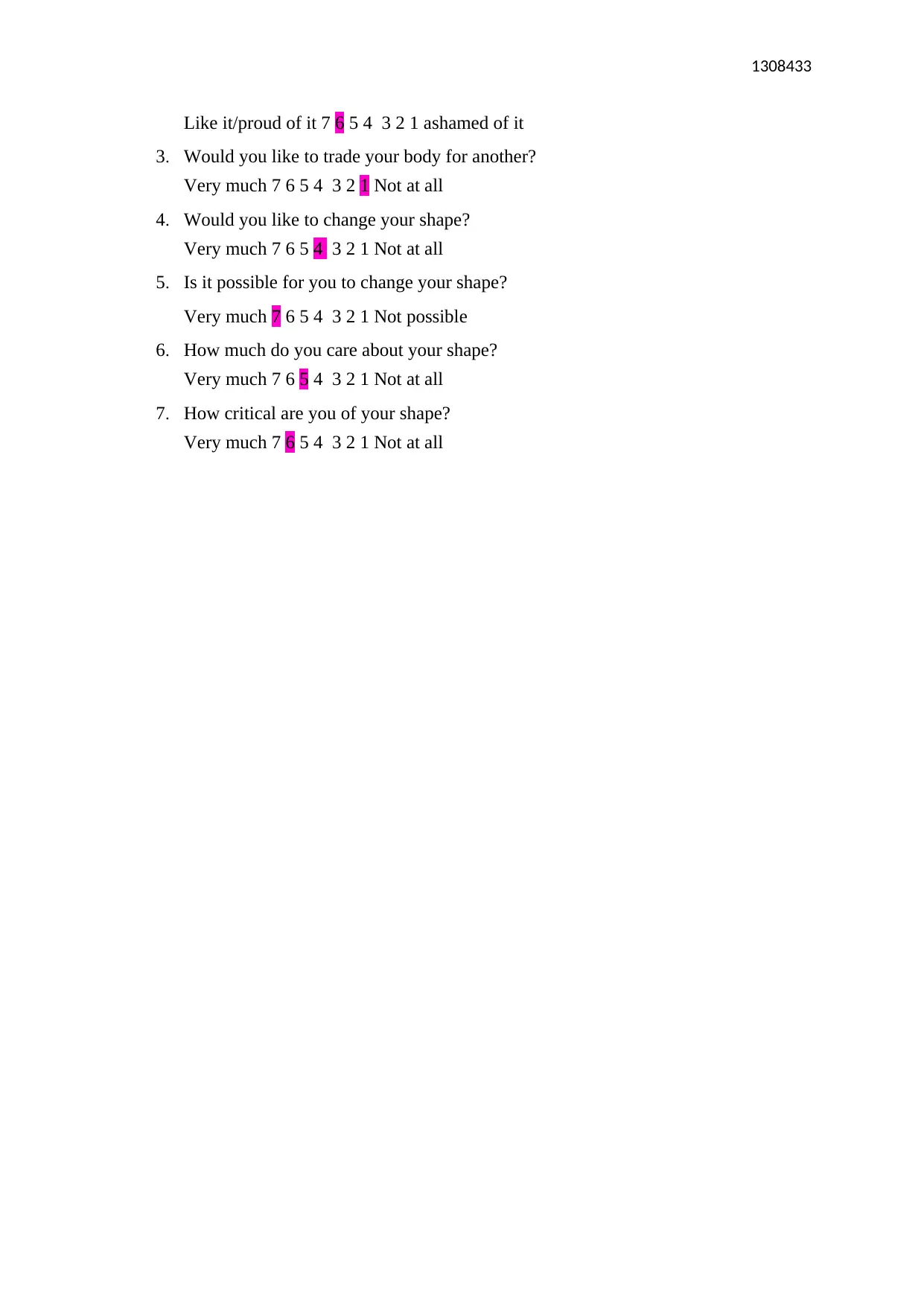
1308433
Like it/proud of it 7 6 5 4 3 2 1 ashamed of it
3. Would you like to trade your body for another?
Very much 7 6 5 4 3 2 1 Not at all
4. Would you like to change your shape?
Very much 7 6 5 4 3 2 1 Not at all
5. Is it possible for you to change your shape?
Very much 7 6 5 4 3 2 1 Not possible
6. How much do you care about your shape?
Very much 7 6 5 4 3 2 1 Not at all
7. How critical are you of your shape?
Very much 7 6 5 4 3 2 1 Not at all
Like it/proud of it 7 6 5 4 3 2 1 ashamed of it
3. Would you like to trade your body for another?
Very much 7 6 5 4 3 2 1 Not at all
4. Would you like to change your shape?
Very much 7 6 5 4 3 2 1 Not at all
5. Is it possible for you to change your shape?
Very much 7 6 5 4 3 2 1 Not possible
6. How much do you care about your shape?
Very much 7 6 5 4 3 2 1 Not at all
7. How critical are you of your shape?
Very much 7 6 5 4 3 2 1 Not at all
1 out of 35
Related Documents
Your All-in-One AI-Powered Toolkit for Academic Success.
+13062052269
info@desklib.com
Available 24*7 on WhatsApp / Email
![[object Object]](/_next/static/media/star-bottom.7253800d.svg)
Unlock your academic potential
© 2024 | Zucol Services PVT LTD | All rights reserved.





